General Dynamics Itronix IX-512AN IX-512AN User Manual Contents
General Dynamics Itronix Corporation IX-512AN Contents
Contents
User Manual 2 Intel

Data Encryption
AES-CCMP
Advanced Encryption Standard - Counter CBC-MAC Protocol. The new method for privacy
protection of wireless transmissions specified in the IEEE 802.11i standard. AES-CCMP
provides a stronger encryption method than TKIP. Choose AES-CCMP as the data encryption
method whenever strong data protection is important. AES-CCMP is available with WPA/
WPA2 Personal/Enterprise network authentication.
NOTE: Some security solutions may not be supported by your computer's
operating system and may require additional software or hardware as well as
wireless LAN infrastructure support. Check with your computer manufacturer for
details.
TKIP
Temporal Key Integrity Protocol provides per-packet key mixing, a message integrity check,
and a rekeying mechanism. TKIP is available with WPA/WPA2 Personal/Enterprise network
authentication.
CKIP
See CKIP.
WEP
Wired Equivalent Privacy (WEP) uses encryption to help prevent unauthorized reception of
wireless data. WEP uses an encryption key to encrypt data before transmitting it. Only
computers that use the same encryption key can access the network and decrypt the data
transmitted by other computers. Enterprise WEP is not exactly the same as personal WEP, in
that you can select Open network authentication and then click Enable 802.1X and be able
to choose from all client authentication types. The selection of authentication types are not
available under personal WEP.
Authentication Types
TLS
A type of authentication method using the Extensible Authentication Protocol (EAP) and a

security protocol called the Transport Layer Security (TLS). EAP-TLS uses certificates which
use passwords. EAP-TLS authentication supports dynamic WEP key management. The TLS
protocol is intended to secure and authenticate communications across a public network
through data encryption. The TLS Handshake Protocol allows the server and client to provide
mutual authentication and to negotiate an encryption algorithm and cryptographic keys
before data is transmitted.
TTLS
These settings define the protocol and the credentials used to authenticate a user. In TTLS
(Tunneled Transport Layer Security), the client uses EAP-TLS to validate the server and
create a TLS-encrypted channel between the client and server. The client can use another
authentication protocol. Typically, password-based protocols challenge over a non-exposed
TLS encrypted channel. TTLS implementations today support all methods defined by EAP, as
well as several older methods (PAP,CHAP,MS-CHAP and MS-CHAP-V2). TTLS can easily be
extended to work with new protocols by defining new attributes to support new protocols.
PEAP
PEAP is a new Extensible Authentication Protocol (EAP) IEEE 802.1X authentication type
designed to take advantage of server-side EAP-Transport Layer Security (EAP-TLS) and to
support various authentication methods, including users' passwords, one-time passwords,
and Generic Token Cards.
LEAP
A version of Extensible Authentication Protocol (EAP). Light Extensible Authentication
Protocol (LEAP) is a proprietary extensible authentication protocol developed by Cisco that
provides a challenge-response authentication mechanism and dynamic key assignment.
EAP-SIM
Extensible Authentication Protocol Method for GSM Subscriber Identity (EAP-SIM) is a
mechanism for authentication and session key distribution. It uses the Global System for
Mobile Communications (GSM) Subscriber Identity Module (SIM). EAP-SIM uses a dynamic
session-based WEP key, which is derived from the client adapter and RADIUS server, to
encrypt data. EAP-SIM requires you to enter a user verification code, or PIN, for
communication with the Subscriber Identity Module (SIM) card. A SIM card is a special
smart card that is used by Global System for Mobile Communications (GSM) based digital
cellular networks. RFC 4186 describes EAP-SIM.
EAP-AKA
EAP-AKA (Extensible Authentication Protocol Method for UMTS Authentication and Key
Agreement) is an EAP mechanism for authentication and session key distribution, using the
Universal Mobile Telecommunications System (UMTS) Subscriber Identity Module (USIM).

The USIM card is a special smart card used with cellular networks to validate a given user
with the network.
Authentication Protocols
PAP
Password Authentication Protocol is a two-way handshake protocol designed for use with
PPP. Password Authentication Protocol is a plain text password used on older SLIP systems.
It is not secure. Only available for TTLS Authentication Type.
CHAP
Challenge Handshake Authentication Protocol is a three-way handshake protocol that is
considered more secure than Password Authentication Protocol. Only available for TTLS
authentication Type.
MS-CHAP (MD4)
Uses a Microsoft version of RSA Message Digest 4 challenge-and-reply protocol. This only
works on Microsoft systems and enables data encryption. To select this authentication
method causes all data to be encrypted. Only available for TTLS authentication type.
MS-CHAP-V2
Introduces an additional feature not available with MS-CHAP-V1 or standard CHAP
authentication, the change password feature. This feature allows the client to change the
account password if the RADIUS server reports that the password has expired. Available for
TTLS and PEAP authentication types.
Generic Token Card (GTC)
Carries user specific token cards for authentication. The main feature in GTC is Digital
Certificate/Token Card-based authentication. In addition, GTC includes the ability to hide
user name identities until the TLS encrypted tunnel is established, which provides additional
confidentiality that user names are not being broadcasted during the authentication phase.
Only available for PEAP authentication type.
TLS
The TLS protocol is intended to secure and authenticate communications across a public

network through data encryption. The TLS Handshake Protocol allows the server and client
to provide mutual authentication and to negotiate an encryption algorithm and cryptographic
keys before data is transmitted. Only available for PEAP authentication type.
Cisco Features
Cisco LEAP
Cisco LEAP (Cisco Light EAP) is a server and client 802.1X authentication through a user-
supplied logon password. When a wireless access point communicates with a Cisco LEAP-
enabled RADIUS (Cisco Secure Access Control Server [ACS]), Cisco LEAP provides access
control through mutual authentication between client wireless adapters and the wireless
networks and provides dynamic, individual user encryption keys to help protect the privacy
of transmitted data.
Cisco Rogue Access Point Security Feature
The Cisco Rogue access point feature provides security protection from an introduction of a
rogue access point that could mimic a legitimate access point on a network in order to
extract information about user credentials and authentication protocols that could
compromise security. This feature only works with Cisco's LEAP authentication. Standard
802.11 technology does not protect a network from the introduction of a rogue access point.
See LEAP Authentication for more information.
802.11b and 802.11g Mixed Environment Protection Protocol
Some access points, for example Cisco 350 or Cisco 1200, support environments in which
not all client stations support WEP encryption; this is called Mixed-Cell Mode. When these
wireless networks operate in "optional encryption" mode, client stations that join in WEP
mode, send all messages encrypted, and stations that use standard mode send all messages
unencrypted. These access points broadcast that the network does not use encryption but
allow clients that use WEP mode. When "Mixed-Cell" is enabled in a profile, it lets you
connect to access points that are configured for "optional encryption."
CKIP
Cisco Key Integrity Protocol (CKIP) is Cisco proprietary security protocol for encryption in
802.11 media. CKIP uses the following features to improve 802.11 security in infrastructure
mode:
●Key Permutation (KP)
●Message Sequence Number

NOTE: CKIP is not used with WPA/WPA2 Personal/Enterprise network authentication.
NOTE: CKIP is only supported through the use of the WiFi connection utility on Windows XP.
Fast Roaming (CCKM)
When a wireless LAN is configured for fast reconnection, a LEAP-enabled client device can
roam from one access point to another without involving the main server. Using Cisco
Centralized Key Management (CCKM), an access point configured to provide Wireless
Domain Services (WDS) takes the place of the RADIUS server and authenticates the client
without perceptible delay in voice or other time-sensitive applications.
Mixed-Cell Mode
Some access points, for example Cisco 350 or Cisco 1200, support environments in which
not all client stations support WEP encryption; this is called Mixed-Cell Mode. When these
wireless network operate in "optional encryption" mode, client stations that join in WEP
mode send all messages encrypted, and stations that use standard mode send all messages
unencrypted. These access points broadcast that the network does not use encryption, but
allows clients that use WEP mode to join. When Mixed-Cell is enabled in a profile, it lets you
connect to access points that are configured for "optional encryption."
Radio Management
When this feature is enabled your wireless adapter provides radio management information
to the Cisco infrastructure. If the Cisco Radio Management utility is used on the
infrastructure it configures radio parameters, detects interference and rogue access points.
EAP-FAST
EAP-FAST, like EAP-TTLS and PEAP, uses tunneling to protect traffic. The main difference is
that EAP-FAST does not use certificates to authenticate. Provisioning in EAP-FAST is
negotiated solely by the client as the first communication exchange when EAP-FAST is
requested from the server. If the client does not have a pre-shared secret Protected Access
Credential (PAC), it is able to initiate a provisioning EAP-FAST exchange to dynamically
obtain one from the server.
EAP-FAST documents two methods to deliver the PAC: manual delivery through an out-of-
band secure mechanism and automatic provisioning.
●Manual delivery mechanisms are any delivery mechanism that the administrator of the
network considers sufficiently secure.
●Automatic provisioning establishes an encrypted tunnel to protect the authentication
of the client and the delivery of the PAC to the client. This mechanism, while not as
secure as a manual method may be, is more secure than the authentication method

used in LEAP.
The EAP-FAST method is divided into two parts: provisioning and authentication. The
provisioning phase involves the initial delivery of the PAC to the client. This phase only
needs to be performed once per client and user.
Back to Top
Back to Contents
Trademarks and Disclaimers

Back to Contents
Regulatory Information
Intel(R) WiMAX/WiFi Link 5350 and Intel(R) WiMAX/WiFi Link 5150 Adapters
●Information for the User
●Regulatory Information
Intel(R) WiFi Link 5300 and Intel(R) WiFi Link 5100 Adapters
●Information for the User
●Regulatory Information
Intel(R) Wireless WiFi Link 4965AGN
Intel(R) Wireless WiFi Link 4965AG_
●Information for the User
●Regulatory Information
Intel(R) PRO/Wireless 3945ABG Network Connection
Intel(R) PRO/Wireless 3945BG Network Connection
●Information for the User
●Regulatory Information
Intel(R) PRO/Wireless 2915ABG Network Connection
●Information for the User
●Regulatory Information
Intel(R) PRO/Wireless 2200BG Network Connection
●Information for the User
●Regulatory Information
Intel(R) WiMAX/WiFi Link 5350 and Intel(R) WiMAX/WiFi Link 5150 Adapters
The information in this section applies to the following products:
WiMAX and Wireless LAN Adapters
●Intel(R) WiMAX/WiFi Link 5350
●Intel(R) WiMAX/WiFi Link 5150
NOTE: In this section, all references to "the adapter" refer equally to the Intel® WiMAX/WiFi Link 5350 and
Intel® WiMAX/WiFi Link 5150 adapters.

NOTE: Due to the evolving state of regulations and standards in the wireless LAN field (IEEE 802.11 and
similar standards), the information provided herein is subject to change. Intel Corporation assumes no
responsibility for errors or omissions in this document. Nor does Intel make any commitment to update the
information contained herein.
Information for the user
Safety Notices
USA—FCC and FAA
The FCC with its action in ET Docket 96-8 has adopted a safety standard for human exposure to radio frequency (RF)
electromagnetic energy emitted by FCC certified equipment. The adapter meets the Human Exposure limits found in OET
Bulletin 65, supplement C, 2001, and ANSI/IEEE C95.1, 1992. Proper operation of this radio according to the instructions
found in this manual will result in exposure substantially below the FCC’s recommended limits.
The following safety precautions should be observed:
●Do not touch or move antenna while the unit is transmitting or receiving.
●Do not hold any component containing the radio such that the antenna is very close or touching any exposed parts of
the body, especially the face or eyes, while transmitting.
●Do not operate the radio or attempt to transmit data unless the antenna is connected; this behavior may cause
damage to the radio.
●Use in specific environments:
❍The use of wireless devices in hazardous locations is limited by the constraints posed by the safety directors of
such environments.
❍The use of wireless devices on airplanes is governed by the Federal Aviation Administration (FAA).
❍The use of wireless devices in hospitals is restricted to the limits set forth by each hospital.
Antenna Use
●In order to comply with FCC RF exposure limits, low gain integrated antennas should be located at a minimum
distance of 20 cm (8 inches) or more from the body of all persons.
●High-gain, wall-mount, or mast-mount antennas are designed to be professionally installed and should be located at
a minimum distance of 30 cm (12 inches) or more from the body of all persons. Please contact your professional
installer, VAR, or antenna manufacturer for proper installation requirements.
Explosive Device Proximity Warning
Warning: Do not operate a portable transmitter (such as a wireless network adapter) near unshielded blasting caps or
in an explosive environment unless the adapter has been modified to be qualified for such use.
Antenna Warnings
Warning: To comply with the FCC and ANSI C95.1 RF exposure limits, it is recommended that for the adapter
installed in a desktop or portable computer, the antenna for this adapter to be installed so as to provide a separation
distance of at least 20 cm (8 inches) from all persons. It is recommended that the user limit exposure time if the antenna
is positioned closer than 20 cm (8 inches).
Warning: Intel(R) PRO/Wireless LAN products are not designed for use with high-gain directional antennas. Use of
such antennas with these products in a manner other than as described in the previous section titled, “Antenna Use” is
illegal.
Use On Aircraft Caution
Caution: Regulations of the FCC and FAA prohibit airborne operation of radio-frequency wireless adapters because
their signals could interfere with critical aircraft instruments.

Other Wireless Devices
Safety Notices for Other Devices in the Wireless Network: See the documentation supplied with wireless Ethernet
adapters or other devices in the wireless network.
Local Restrictions on 802.11a, 802.11b, 802.11g, 802.11n, and 802.16e Radio Usage
Caution: Due to the fact that the frequencies used by 802.11a, 802.11b, 802.11g, 802.11n, and 802.16e wireless LAN
devices may not yet be harmonized in all countries, 802.11a, 802.11b, 802.11g, 802.11n, and 802.16e products are
designed for use only in specific countries, and are not allowed to be operated in countries other than those of designated
use. As a user of these products, you are responsible for ensuring that the products are used only in the countries for
which they were intended and for verifying that they are configured with the correct selection of frequency and channel for
the country of use. The device transmit power control (TPC) interface is part of the Intel(R) PROSet/Wireless
NOTE: In this section, all references to "the adapter" refer equally to the Intel(R) WiFi Link 5300 and Intel(R)
WiFi Link 5100 adapters.
NOTE: Due to the evolving state of regulations and standards in the wireless LAN field (IEEE 802.11 and
similar standards), the information provided herein is subject to change. Intel Corporation assumes no
responsibility for errors or omissions in this document. Nor does Intel make any commitment to update the
information contained herein.
Information for the user
Safety Notices
USA—FCC and FAA
The FCC with its action in ET Docket 96-8 has adopted a safety standard for human exposure to radio frequency (RF)
electromagnetic energy emitted by FCC certified equipment. The adapter meets the Human Exposure limits found in OET
Bulletin 65, supplement C, 2001, and ANSI/IEEE C95.1, 1992. Proper operation of this radio according to the instructions
found in this manual will result in exposure substantially below the FCC’s recommended limits.
The following safety precautions should be observed:
●Do not touch or move antenna while the unit is transmitting or receiving.
●Do not hold any component containing the radio such that the antenna is very close or touching any exposed parts of
the body, especially the face or eyes, while transmitting.
●Do not operate the radio or attempt to transmit data unless the antenna is connected; this behavior may cause
damage to the radio.
●Use in specific environments:
❍The use of wireless devices in hazardous locations is limited by the constraints posed by the safety directors of
such environments.
❍The use of wireless devices on airplanes is governed by the Federal Aviation Administration (FAA).
❍The use of wireless devices in hospitals is restricted to the limits set forth by each hospital.
Antenna Use
●In order to comply with FCC RF exposure limits, low gain integrated antennas should be located at a minimum
distance of 20 cm (8 inches) or more from the body of all persons.
●High-gain, wall-mount, or mast-mount antennas are designed to be professionally installed and should be located at
a minimum distance of 30 cm (12 inches) or more from the body of all persons. Please contact your professional
installer, VAR, or antenna manufacturer for proper installation requirements.
Explosive Device Proximity Warning
Warning: Do not operate a portable transmitter (such as a wireless network device) near unshielded blasting caps or
in an explosive environment unless the device has been modified to be qualified for such use.
Antenna Warnings

Warning: To comply with the FCC and ANSI C95.1 RF exposure limits, it is recommended for the adapter installed in
a desktop or portable computer, that the antenna for this device be installed so as to provide a separation distance of at
least 20 cm (8 inches) from all persons. It is recommended that the user limit exposure time if the antenna is positioned
closer than 20 cm (8 inches).
Warning: Intel(R) PRO/Wireless LAN products are not designed for use with high-gain directional antennas. Use of
such antennas with these products in a manner other than as described in the previous section titled, “Antenna Use” is
illegal.
Use On Aircraft Caution
Caution: Regulations of the FCC and FAA prohibit airborne operation of radio-frequency wireless devices because their
signals could interfere with critical aircraft instruments.
Other Wireless Devices
Safety Notices for Other Devices in the Wireless Network: See the documentation supplied with wireless Ethernet
adapters or other devices in the wireless network.
Local Restrictions on 802.11a, 802.11b, 802.11g and 802.11n Radio Usage
Caution: Due to the fact that the frequencies used by 802.11a, 802.11b, 802.11g and 802.11n wireless LAN devices
may not yet be harmonized in all countries, 802.11a, 802.11b, 802.11g and 802.11n products are designed for use only in
specific countries, and are not allowed to be operated in countries other than those of designated use. As a user of these
products, you are responsible for ensuring that the products are used only in the countries for which they were intended
and for verifying that they are configured with the correct selection of frequency and channel for the country of use. The
device transmit power control (TPC) interface is part of the Intel(R) PROSet/Wireless WiFi Connection Utility Software.
Operational restrictions for Equivalent Isotropic Radiated Power (EIRP) are provided by the system manufacturer. Any
deviation from the permissible power and frequency settings for the country of use is an infringement of national law and
may be punished as such.
For country-specific information, see the additional compliance information supplied with the product.
Wireless interoperability
The adapter is designed to be interoperable with other wireless LAN products that are based on direct sequence spread
spectrum (DSSS) radio technology and to comply with the following standards:
●IEEE Std. 802.11b compliant Standard on Wireless LAN
●IEEE Std. 802.11g compliant Standard on Wireless LAN
●IEEE Std. 802.11a compliant Standard on Wireless LAN
●IEEE Std. 802.11n draft 2.0 compliant on Wireless LAN
●Wireless Fidelity certification, as defined by the Wi-Fi Alliance
The Intel(R) WiFi Link 5300 adapter, Intel(R) WiFi Link 5100 adapter and your health
The adapter, like other radio devices, emits radio frequency electromagnetic energy. The level of energy emitted by this
device, however, is less than the electromagnetic energy emitted by other wireless devices such as mobile phones. The
adapter operates within the guidelines found in radio frequency safety standards and recommendations. These standards
and recommendations reflect the consensus of the scientific community and result from deliberations of panels and
committees of scientists who continually review and interpret the extensive research literature. In some situations or
environments, the use of the adapter may be restricted by the proprietor of the building or responsible representatives of
the applicable organization. Examples of such situations may include:
●Using the adapter equipment on board airplanes, or
●Using the adapter equipment in any other environment where the risk of interference with other devices or services
is perceived or identified as being harmful.

If you are uncertain of the policy that applies to the use of wireless devices in a specific organization or environment (an
airport, for example), you are encouraged to ask for authorization to use the adapter before you turn it on.
Regulatory information
Information for the OEMs and Integrators
The following statement must be included with all versions of this document supplied to an OEM or integrator, but should
not be distributed to the end user.
●This device is intended for OEM integrators only.
●Please See the full Grant of Equipment document for other restrictions.
●This device must be operated and used with a locally approved access point.
Information To Be Supplied to the End User by the OEM or Integrator
The following regulatory and safety notices must be published in documentation supplied to the end user of the product or
system incorporating an Intel(R) WiFi Link 5300 adapter or Intel(R) WiFi Link 5100 adapter in compliance with local
regulations. Host system must be labeled with "Contains FCC ID: XXXXXXXX", FCC ID displayed on label.
The adapter must be installed and used in strict accordance with the manufacturer's instructions as described in the user
documentation that comes with the product. For country-specific approvals, see Radio approvals. Dell Inc. is not
responsible for any radio or television interference caused by unauthorized modification of the devices included with the
adapter kit, or the substitution or attachment of connecting cables and equipment other than that specified by Dell Inc. The
correction of interference caused by such unauthorized modification, substitution or attachment is the responsibility of the
user. Dell Inc. and its authorized resellers or distributors are not liable for any damage or violation of government
regulations that may arise from the user failing to comply with these guidelines.
Local Restriction of 802.11a, 802.11b, 802.11g, and 802.11n Radio Usage
The following statement on local restrictions must be published as part of the compliance documentation for all 802.11a,
802.11b, 802.11g and 802.11n products.
Caution: Due to the fact that the frequencies used by 802.11a, 802.11b, 802.11g and 802.11n wireless LAN devices
may not yet be harmonized in all countries, 802.11a, 802.11b, 802.11g and 802.11n products are designed for use only in
specific countries, and are not allowed to be operated in countries other than those of designated use. As a user of these
products, you are responsible for ensuring that the products are used only in the countries for which they were intended
and for verifying that they are configured with the correct selection of frequency and channel for the country of use. Any
deviation from permissible settings and restrictions in the country of use could be an infringement of national law and may
be punished as such.
FCC Radio Frequency Interference Requirements
This device is restricted to indoor use due to its operation in the 5.15 to 5.25 GHz frequency range. FCC requires this
product to be used indoors for the frequency range 5.15 to 5.25 GHz to reduce the potential for harmful interference to co-
channel Mobile Satellite systems. High power radars are allocated as primary users of the 5.25 to 5.35 GHz and 5.65 to
5.85 GHz bands. These radar stations can cause interference with and /or damage this device.
●This device is intended for OEM integrators only.
●This device cannot be co-located with any other transmitter unless approved by the FCC.
USA—Federal Communications Commission (FCC)
This device complies with Part 15 of the FCC Rules. Operation of the device is subject to the following two conditions:
●This device may not cause harmful interference.
●This device must accept any interference that may cause undesired operation.

NOTE: The radiated output power of the adapter is far below the FCC radio frequency exposure limits.
Nevertheless, the adapter should be used in such a manner that the potential for human contact during normal
operation is minimized. To avoid the possibility of exceeding the FCC radio frequency exposure limits, you
should keep a distance of at least 20 cm between you (or any other person in the vicinity) and the antenna
that is built into the computer. Details of the authorized configurations can be found at http://www.fcc.gov/oet/
ea/ by entering the FCC ID number on the device.
Interference statement
This equipment has been tested and found to comply with the limits for a Class B digital device, pursuant to Part 15 of the
FCC Rules. These limits are designed to provide reasonable protection against harmful interference in a residential
installation. This equipment generates, uses, and can radiate radio frequency energy. If the equipment is not installed and
used in accordance with the instructions, the equipment may cause harmful interference to radio communications. There is
no guarantee, however, that such interference will not occur in a particular installation. If this equipment does cause
harmful interference to radio or television reception (which can be determined by turning the equipment off and on), the
user is encouraged to try to correct the interference by taking one or more of the following measures:
●Reorient or relocate the receiving antenna.
●Increase the distance between the equipment and the receiver.
●Connect the equipment to an outlet on a circuit different from that to which the receiver is connected.
●Consult the dealer or an experienced radio/TV technician for help.
NOTE: The adapter must be installed and used in strict accordance with the manufacturer's instructions as
described in the user documentation that comes with the product. Any other installation or use will violate FCC
Part 15 regulations.
Underwriters Laboratories Inc. (UL) Regulatory Warning
For use in (or with) UL Listed personal computers or compatible.
Brazil
Este equipamento opera em caráter secundário, isto é, não tem direito a proteção contra interferência prejudicial, mesmo
de estações do mesmo tipo, e não pode causar interferência a sistemas operando em caráter primário.
Canada—Industry Canada (IC)
This device complies with RSS210 of Industry Canada.
Caution: When using IEEE 802.11a wireless LAN, this product is restricted to indoor use due to its operation in the
5.15- to 5.25-GHz frequency range. Industry Canada requires this product to be used indoors for the frequency range of
5.15 GHz to 5.25 GHz to reduce the potential for harmful interference to co-channel mobile satellite systems. High power
radar is allocated as the primary user of the 5.25- to 5.35-GHz and 5.65 to 5.85-GHz bands. These radar stations can
cause interference with and/or damage to this device.
The maximum allowed antenna gain for use with this device is 6dBi in order to comply with the E.I.R.P limit for the 5.25- to
5.35 and 5.725 to 5.85 GHz frequency range in point-to-point operation.
This Class B digital apparatus complies with Canadian ICES-003, Issue 4, and RSS-210, No 4 (Dec 2000) and No 5 (Nov
2001).
Cet appareil numérique de la classe B est conforme à la norme NMB-003, No. 4, et CNR-210, No 4 (Dec 2000) et No 5 (Nov
2001).
"To prevent radio interference to the licensed service, this device is intended to be operated indoors and away from
windows to provide maximum shielding. Equipment (or its transmit antenna) that is installed outdoors is subject to
licensing."
« Pour empêcher que cet appareil cause du brouillage au service faisant l'objet d'une licence, il doit être utilisé a l'intérieur
et devrait être placé loin des fenêtres afinde fournir un écran de blindage maximal. Si le matériel (ou son antenne

d'émission) est installé à l'extérieur, il doit faire l'objet d'une licence. »
European Union
The low band 5.15 -5.35 GHz is for indoor use only.
Intel(R) WiFi Link 5300 Adapter Declaration of Conformity
The European Declaration of Conformity is available at the following site:
http://www.intel.com/support/go/wireless/wlan/wf_reg.htm
This equipment complies with the essential requirements of the European Union directive 1999/5/EC.
•esky
[Czech] Intel(R) Corporation tímto prohlašuje, že tento Intel(R) WiFi Link 5300 je ve shod• se základními
požadavky a dalšími p•íslušnými ustanoveními sm•rnice 1999/5/ES.
Dansk
[Danish] Undertegnede Intel(R) Corporation erklærer herved, at følgende udstyr Intel(R) WiFi Link 5300 overholder
de væsentlige krav og øvrige relevante krav i direktiv 1999/5/EF.
Deutsch
[German] Hiermit erklärt Intel(R) Corporation, dass sich das Gerät Intel(R) WiFi Link 5300 in Übereinstimmung mit
den grundlegenden Anforderungen und den übrigen einschlägigen Bestimmungen der Richtlinie 1999/5/EG
befindet.
Esti
[Estonian] Käesolevaga kinnitab Intel(R) Corporation seadme Intel(R) WiFi Link 5300 vastavust direktiivi 1999/5/EÜ
põhinõuetele ja nimetatud direktiivist tulenevatele teistele asjakohastele sätetele.
English Hereby, Intel(R) Corporation, declares that this Intel(R) WiFi Link 5300 is in compliance with the essential
requirements and other relevant provisions of Directive 1999/5/EC.
Español
[Spanish] Por medio de la presente Intel(R) Corporation declara que el Intel(R) WiFi Link 5300 cumple con los
requisitos esenciales y cualesquiera otras disposiciones aplicables o exigibles de la Directiva 1999/5/CE.
Ελληνικ•
[Greek] ΜΕ ΤΗΝ ΠΑΡΟΥΣΑ Intel(R) Corporation ∆ΗΛΩΝΕΙ ΟΤΙ Intel(R) WiFi Link 5300 ΣΥΜΜΟΡΦΩΝΕΤΑΙ ΠΡΟΣ ΤΙΣ
ΟΥΣΙΩ∆ΕΙΣ ΑΠΑΙΤΗΣΕΙΣ ΚΑΙ ΤΙΣ ΛΟΙΠΕΣ ΣΧΕΤΙΚΕΣ ∆ΙΑΤΑΞΕΙΣ ΤΗΣ Ο∆ΗΓΙΑΣ 1999/5/ΕΚ.
Français
[French] Par la présente Intel(R) Corporation déclare que l'appareil Intel(R) WiFi Link 5300 est conforme aux
exigences essentielles et aux autres dispositions pertinentes de la directive 1999/5/CE.
Italiano
[Italian] Con la presente Intel(R) Corporation dichiara che questo Intel(R) WiFi Link 5300 è conforme ai requisiti
essenziali ed alle altre disposizioni pertinenti stabilite dalla direttiva 1999/5/CE.
Latviski
[Latvian] Ar šo Intel(R) Corporation deklar•, ka Intel(R) WiFi Link 5300 atbilst Direkt•vas 1999/5/EK b•tiskaj•m
pras•b•m un citiem ar to saist•tajiem noteikumiem.
Lietuvi•
[Lithuanian] Šiuo Intel(R) Corporation deklaruoja, kad šis Intel(R) WiFi Link 5300 atitinka esminius reikalavimus ir kitas
1999/5/EB Direktyvos nuostatas.
Nederlands
[Dutch] Hierbij verklaart Intel(R) Corporation dat het toestel Intel(R) WiFi Link 5300 in overeenstemming is met de
essentiële eisen en de andere relevante bepalingen van richtlijn 1999/5/EG.
Malti
[Maltese] Hawnhekk, Intel(R) Corporation, jiddikjara li dan Intel(R) WiFi Link 5300 jikkonforma mal-•ti•ijiet essenzjali
u ma provvedimenti o•rajn relevanti li hemm fid-Dirrettiva 1999/5/EC.
Magyar
[Hungarian] Alulírott, Intel(R) Corporation nyilatkozom, hogy a Intel(R) WiFi Link 5300 megfelel a vonatkozó alapvetõ
követelményeknek és az 1999/5/EC irányelv egyéb elõírásainak.
Norsk
[Norwegian] Intel Corporation erklærer herved at utstyret Intel(R) WiFi Link 5300 er i samsvar med de grunnleggende
krav og øvrige relevante krav i direktiv 1999/5/EF.
Polski
[Polish] Niniejszym, Intel(R) Corporation, o•wiadcza, •e Intel(R) WiFi Link 5300 jest zgodne z zasadniczymi
wymaganiami oraz innymi stosownymi postanowieniami Dyrektywy 1999/5/WE.
Português
[Portuguese] Intel(R) Corporation declara que este Intel(R) WiFi Link 5300 está conforme com os requisitos essenciais e
outras disposições da Directiva 1999/5/CE.
Slovensko
[Slovenian] Šiuo Intel(R) Corporation izjavlja, da je ta Intel(R) WiFi Link 5300 v skladu z bistvenimi zahtevami in
ostalimi relevantnimi dolo•ili direktive 1999/5/ES.
Slovensky
[Slovak] Intel(R) Corporation týmto vyhlasuje, že Intel(R) WiFi Link 5300 sp••a základné požiadavky a všetky
príslušné ustanovenia Smernice 1999/5/ES.
Suomi
[Finnish] Intel(R) Corporation vakuuttaa täten että Intel (R) WiFi Link 5300 tyyppinen laite on direktiivin 1999/5/EY
oleellisten vaatimusten ja sitä koskevien direktiivin muiden ehtojen mukainen.

Svenska
[Swedish] Härmed intygar Intel(R) Corporation att denna Intel(R) WiFi Link 5300 står I överensstämmelse med de
väsentliga egenskapskrav och övriga relevanta bestämmelser som framgår av direktiv 1999/5/EG.
Íslenska
[Icelandic] Hér með lýsir Intel(R) Corporation yfir því að Intel(R) WiFi Link 5300 er í samræmi við grunnkröfur og aðrar
kröfur, sem gerðar eru í tilskipun 1999/5/EC.
Intel(R) WiFi Link 5100 Adapter Declaration of Conformity
The European Declaration of Conformity is available at the following site:
http://www.intel.com/support/go/wireless/wlan/wf_reg.htm
This equipment complies with the essential requirements of the European Union directive 1999/5/EC.
•esky
[Czech] Intel(R) Corporation tímto prohlašuje, že tento Intel(R) WiFi Link 5100 je ve shod• se základními
požadavky a dalšími p•íslušnými ustanoveními sm•rnice 1999/5/ES.
Dansk
[Danish] Undertegnede Intel(R) Corporation erklærer herved, at følgende udstyr Intel(R) WiFi Link 5100
overholder de væsentlige krav og øvrige relevante krav i direktiv 1999/5/EF.
Deutsch
[German] Hiermit erklärt Intel(R) Corporation, dass sich das Gerät Intel(R) WiFi Link 5100 in Übereinstimmung
mit den grundlegenden Anforderungen und den übrigen einschlägigen Bestimmungen der Richtlinie
1999/5/EG befindet.
Esti
[Estonian] Käesolevaga kinnitab Intel(R) Corporation seadme Intel(R) WiFi Link 5100 vastavust direktiivi
1999/5/EÜ põhinõuetele ja nimetatud direktiivist tulenevatele teistele asjakohastele sätetele.
English Hereby, Intel(R) Corporation, declares that this Intel(R) WiFi Link 5100 is in compliance with the
essential requirements and other relevant provisions of Directive 1999/5/EC.
Español
[Spanish] Por medio de la presente Intel(R) Corporation declara que el Intel(R) WiFi Link 5100 cumple con los
requisitos esenciales y cualesquiera otras disposiciones aplicables o exigibles de la Directiva 1999/5/
CE.
Ελληνικ•
[Greek] ΜΕ ΤΗΝ ΠΑΡΟΥΣΑ Intel(R) Corporation ∆ΗΛΩΝΕΙ ΟΤΙ Intel(R) WiFi Link 5100 ΣΥΜΜΟΡΦΩΝΕΤΑΙ ΠΡΟΣ
ΤΙΣ ΟΥΣΙΩ∆ΕΙΣ ΑΠΑΙΤΗΣΕΙΣ ΚΑΙ ΤΙΣ ΛΟΙΠΕΣ ΣΧΕΤΙΚΕΣ ∆ΙΑΤΑΞΕΙΣ ΤΗΣ Ο∆ΗΓΙΑΣ 1999/5/ΕΚ.
Français
[French] Par la présente Intel(R) Corporation déclare que l'appareil Intel(R) WiFi Link 5100 est conforme aux
exigences essentielles et aux autres dispositions pertinentes de la directive 1999/5/CE.
Italiano
[Italian] Con la presente Intel(R) Corporation dichiara che questo Intel(R) WiFi Link 5100 è conforme ai
requisiti essenziali ed alle altre disposizioni pertinenti stabilite dalla direttiva 1999/5/CE.
Latviski
[Latvian] Ar šo Intel(R) Corporation deklar•, ka Intel(R) WiFi Link 5100 atbilst Direkt•vas 1999/5/EK
b•tiskaj•m pras•b•m un citiem ar to saist•tajiem noteikumiem.
Lietuvi•
[Lithuanian] Šiuo Intel(R) Corporation deklaruoja, kad šis Intel(R) WiFi Link 5100 atitinka esminius reikalavimus
ir kitas 1999/5/EB Direktyvos nuostatas.
Nederlands
[Dutch] Hierbij verklaart Intel(R) Corporation dat het toestel Intel(R) WiFi Link 5100 in overeenstemming is
met de essentiële eisen en de andere relevante bepalingen van richtlijn 1999/5/EG.
Malti
[Maltese] Hawnhekk, Intel(R) Corporation, jiddikjara li dan Intel(R) WiFi Link 5100 jikkonforma mal-•ti•ijiet
essenzjali u ma provvedimenti o•rajn relevanti li hemm fid-Dirrettiva 1999/5/EC.
Magyar
[Hungarian] Alulírott, Intel(R) Corporation nyilatkozom, hogy a Intel(R) WiFi Link 5100 megfelel a vonatkozó
alapvetõ követelményeknek és az 1999/5/EC irányelv egyéb elõírásainak.
Norsk [Norwegian] Intel Corporation erklærer herved at utstyret Intel(R) WiFi Link 5100 er i samsvar med de
grunnleggende krav og øvrige relevante krav i direktiv 1999/5/EF.
Polski
[Polish] Niniejszym, Intel(R) Corporation, o•wiadcza, •e Intel(R) WiFi Link 5100 jest zgodne z zasadniczymi
wymaganiami oraz innymi stosownymi postanowieniami Dyrektywy 1999/5/WE.
Português
[Portuguese] Intel(R) Corporation declara que este Intel(R) WiFi Link 5100 está conforme com os requisitos
essenciais e outras disposições da Directiva 1999/5/CE.
Slovensko
[Slovenian] Šiuo Intel(R) Corporation izjavlja, da je ta Intel(R) WiFi Link 5100 v skladu z bistvenimi zahtevami in
ostalimi relevantnimi dolo•ili direktive 1999/5/ES.
Slovensky
[Slovak] Intel(R) Corporation týmto vyhlasuje, že Intel(R) WiFi Link 5100 sp••a základné požiadavky a
všetky príslušné ustanovenia Smernice 1999/5/ES.
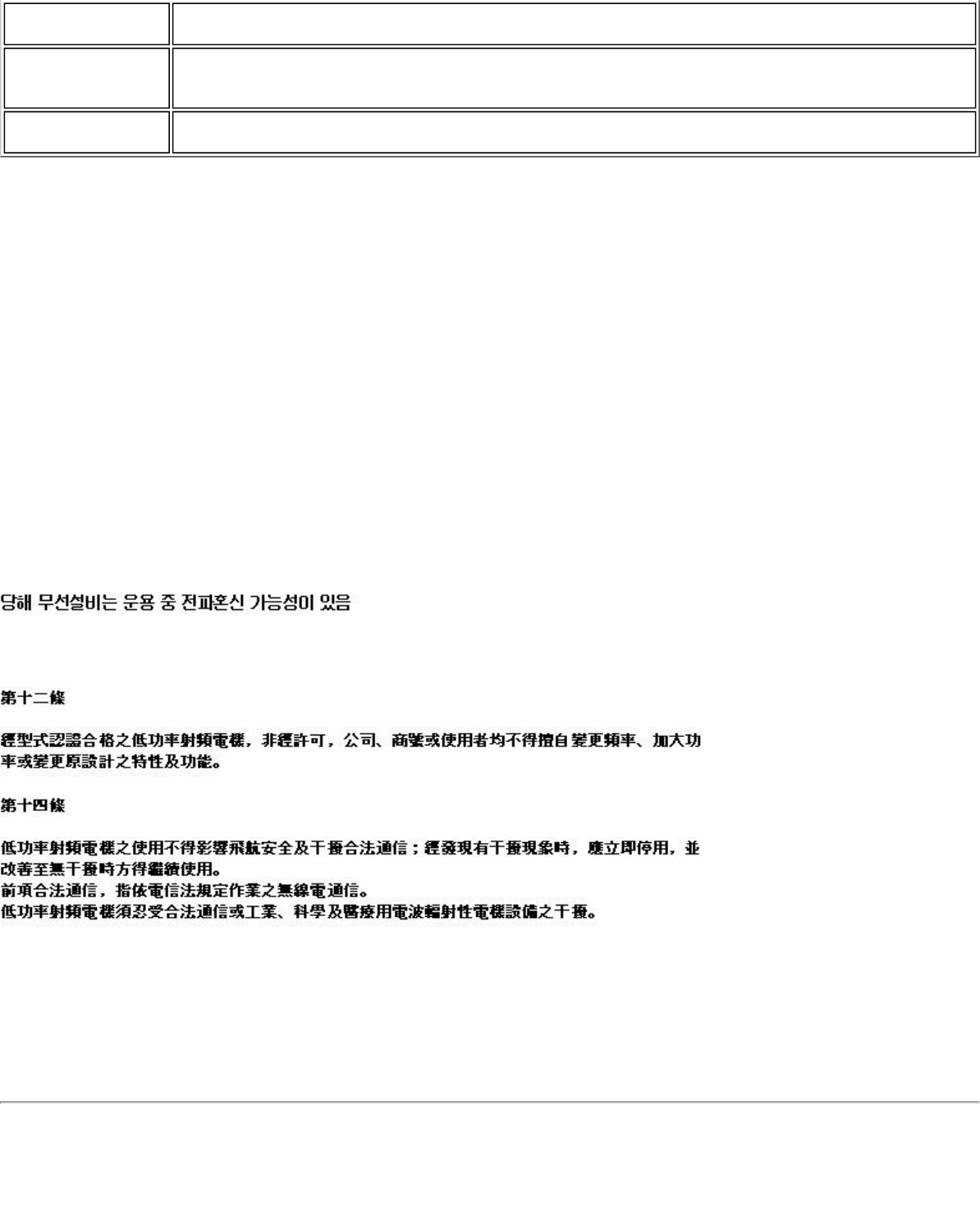
Suomi
[Finnish] Intel(R) Corporation vakuuttaa täten että Intel(R) WiFi Link 5100 tyyppinen laite on direktiivin
1999/5/EY oleellisten vaatimusten ja sitä koskevien direktiivin muiden ehtojen mukainen.
Svenska
[Swedish] Härmed intygar Intel(R) Corporation att denna Intel(R) WiFi Link 5100 står I överensstämmelse
med de väsentliga egenskapskrav och övriga relevanta bestämmelser som framgår av direktiv
1999/5/EG.
Íslenska
[Icelandic] Hér með lýsir Intel(R) Corporation yfir því að Intel(R) WiFi Link 5100 er í samræmi við grunnkröfur
og aðrar kröfur, sem gerðar eru í tilskipun 1999/5/EC.
Italy
The use of these equipments is regulated by:
1. D.L.gs 1.8.2003, n. 259, article 104 (activity subject to general authorization) for outdoor use and article 105 (free
use) for indoor use, in both cases for private use.
2. D.M. 28.5.03, for supply to public of RLAN access to networks and telecom services.
L’uso degli apparati è regolamentato da:
1. D.L.gs 1.8.2003, n. 259, articoli 104 (attività soggette ad autorizzazione generale) se utilizzati al di fuori del proprio
fondo e 105 (libero uso) se utilizzati entro il proprio fondo, in entrambi i casi per uso private.
2. D.M. 28.5.03, per la fornitura al pubblico dell’accesso R-LAN alle reti e ai servizi di telecomunicazioni.
Japan
Indoor use only.
Korea
Taiwan
Radio approvals
To determine whether you are allowed to use your wireless network device in a specific country, please check to see if the
radio type number that is printed on the identification label of your device is listed in the manufacturer's OEM Regulatory
Guidance document.
Intel(R) Wireless WiFi Link 4965AGN and Intel(R) Wireless WiFi Link 4965AG_
The information in this document applies to the following products:

Quad-mode wireless LAN adapters (802.11a/802.11b/802.11g/802.11n)
Intel(R) Wireless WiFi Link 4965AGN (model WM4965AGN)
Tri-mode wireless LAN adapters (802.11a/802.11b/802.11g)
Intel(R) Wireless WiFi Link 4965AG_ (model WM4965AG_)
NOTE: Due to the evolving state of regulations and standards in the wireless LAN field (IEEE 802.11 and
similar standards), the information provided herein is subject to change. Intel Corporation assumes no
responsibility for errors or omissions in this document. Nor does Intel make any commitment to update the
information contained herein.
Information for the user
Safety Notices
USA—FCC and FAA
The FCC with its action in ET Docket 96-8 has adopted a safety standard for human exposure to radio frequency (RF)
electromagnetic energy emitted by FCC certified equipment. The Intel(R) Wireless WiFi Link 4965AGN and Intel(R) Wireless
WiFi Link 4965AG_ adapters meet the Human Exposure limits found in OET Bulletin 65, supplement C, 2001, and ANSI/
IEEE C95.1, 1992. Proper operation of this radio according to the instructions found in this manual will result in exposure
substantially below the FCC’s recommended limits.
The following safety precautions should be observed:
●Do not touch or move antenna while the unit is transmitting or receiving.
●Do not hold any component containing the radio such that the antenna is very close or touching any exposed parts of
the body, especially the face or eyes, while transmitting.
●Do not operate the radio or attempt to transmit data unless the antenna is connected; this behavior may cause
damage to the radio.
●Use in specific environments:
❍The use of wireless devices in hazardous locations is limited by the constraints posed by the safety directors of
such environments.
❍The use of wireless devices on airplanes is governed by the Federal Aviation Administration (FAA).
❍The use of wireless devices in hospitals is restricted to the limits set forth by each hospital.
Antenna Use
●In order to comply with FCC RF exposure limits, low gain integrated antennas should be located at a minimum
distance of 20 cm (8 inches) or more from the body of all persons.
●High-gain, wall-mount, or mast-mount antennas are designed to be professionally installed and should be located at
a minimum distance of 30 cm (12 inches) or more from the body of all persons. Please contact your professional
installer, VAR, or antenna manufacturer for proper installation requirements.
Explosive Device Proximity Warning
Warning: Do not operate a portable transmitter (such as a wireless network device) near unshielded blasting caps or
in an explosive environment unless the device has been modified to be qualified for such use.
Antenna Warnings
Warning: To comply with the FCC and ANSI C95.1 RF exposure limits, it is recommended for the Intel(R) Wireless
WiFi Link 4965AGN or Intel(R) Wireless WiFi Link 4965AG_ adapters installed in a desktop or portable computer, that the
antenna for this device be installed so as to provide a separation distance of al least 20 cm (8 inches) from all persons. It is
recommended that the user limit exposure time if the antenna is positioned closer than 20 cm (8 inches).
Warning: Intel(R) PRO/Wireless LAN products are not designed for use with high-gain directional antennas. Use of
such antennas with these products in a manner other than as described in the previous section titled, “Antenna Use” is
illegal.

Use On Aircraft Caution
Caution: Regulations of the FCC and FAA prohibit airborne operation of radio-frequency wireless devices because their
signals could interfere with critical aircraft instruments.
Other Wireless Devices
Safety Notices for Other Devices in the Wireless Network: See the documentation supplied with wireless Ethernet
adapters or other devices in the wireless network.
Local Restrictions on 802.11a, 802.11b, 802.11g and 802.11n Radio Usage
Caution: Due to the fact that the frequencies used by 802.11a, 802.11b, 802.11g and 802.11n wireless LAN devices
may not yet be harmonized in all countries, 802.11a, 802.11b, 802.11g and 802.11n products are designed for use only in
specific countries, and are not allowed to be operated in countries other than those of designated use. As a user of these
products, you are responsible for ensuring that the products are used only in the countries for which they were intended
and for verifying that they are configured with the correct selection of frequency and channel for the country of use. The
device transmit power control (TPC) interface is part of the Intel(R) PROSet/Wireless WiFi Connection Utility. Operational
restrictions for Equivalent Isotropic Radiated Power (EIRP) are provided by the system manufacturer. Any deviation from
the permissible power and frequency settings for the country of use is an infringement of national law and may be
punished as such.
For country-specific information, see the additional compliance information supplied with the product.
Wireless interoperability
The Intel(R) Wireless WiFi Link 4965AGN and the Intel(R) Wireless WiFi Link 4965AG_ adapters are designed to be
interoperable with other wireless LAN products that are based on direct sequence spread spectrum (DSSS) radio
technology and to comply with the following standards:
●IEEE Std. 802.11b compliant Standard on Wireless LAN
●IEEE Std. 802.11g compliant Standard on Wireless LAN
●IEEE Std. 802.11a compliant Standard on Wireless LAN
●IEEE Std. 802.11n draft 2.0 compliant on Wireless LAN (does apply to the Intel(R) Wireless WiFi Link 4965AG_
adapter)
●Wireless Fidelity certification, as defined by the Wi-Fi Alliance
The Intel(R) Wireless WiFi Link 4965AGN adapter or Intel(R) Wireless WiFi Link 4965AG_ adapter and your
health
The Intel(R) Wireless WiFi Link 4965AGN adapter and Intel(R) Wireless WiFi Link 4965AG_ adapter, like other radio
devices, emit radio frequency electromagnetic energy. The level of energy emitted by the device, however, is less than the
electromagnetic energy emitted by other wireless devices such as mobile phones. The adapter operates within the
guidelines found in radio frequency safety standards and recommendations. These standards and recommendations reflect
the consensus of the scientific community and result from deliberations of panels and committees of scientists who
continually review and interpret the extensive research literature. In some situations or environments, the use of the Intel
(R) Wireless WiFi Link 4965AGN adapter or Intel(R) Wireless WiFi Link 4965AG_ adapter may be restricted by the
proprietor of the building or responsible representatives of the applicable organization. Examples of such situations may
include:
●Using the adapter equipment on board airplanes, or
●Using the adapter equipment in any other environment where the risk of interference with other devices or services
is perceived or identified as being harmful.
If you are uncertain of the policy that applies to the use of wireless devices in a specific organization or environment (an
airport, for example), you are encouraged to ask for authorization to use the Intel(R) Wireless WiFi Link 4965AGN or Intel
(R) Wireless WiFi Link 4965AG_ adapter before you turn it on.

Regulatory information
Information for the OEMs and Integrators
The following statement must be included with all versions of this document supplied to an OEM or integrator, but should
not be distributed to the end user.
●This device is intended for OEM integrators only.
●Please See the full Grant of Equipment document for other restrictions.
●This device must be operated and used with a locally approved access point.
Information To Be Supplied to the End User by the OEM or Integrator
The following regulatory and safety notices must be published in documentation supplied to the end user of the product or
system incorporating an Intel(R) Wireless WiFi Link 4965AGN or Intel(R) Wireless WiFi Link 4965AG_ in compliance with
local regulations. Host system must be labeled with "Contains FCC ID: XXXXXXXX", FCC ID displayed on label.
The Intel(R) Wireless WiFi Link 4965AGN or Intel(R) Wireless WiFi Link 4965AG_ wireless network device must be installed
and used in strict accordance with the manufacturer's instructions as described in the user documentation that comes with
the product. For country-specific approvals, see Radio approvals. Intel Corporation is not responsible for any radio or
television interference caused by unauthorized modification of the devices included with the Intel(R) Wireless WiFi Link
4965AGN or Intel(R) Wireless WiFi Link 4965AG_ adapter kit, or the substitution or attachment of connecting cables and
equipment other than that specified by Intel Corporation. The correction of interference caused by such unauthorized
modification, substitution or attachment is the responsibility of the user. Intel Corporation and its authorized resellers or
distributors are not liable for any damage or violation of government regulations that may arise from the user failing to
comply with these guidelines.
Local Restriction of 802.11a, 802.11b, 802.11g, and 802.11n Radio Usage
The following statement on local restrictions must be published as part of the compliance documentation for all 802.11a,
802.11b, 802.11g and 802.11n products.
Caution: Due to the fact that the frequencies used by 802.11a, 802.11b, 802.11g and 802.11n wireless LAN devices
may not yet be harmonized in all countries, 802.11a, 802.11b, 802.11g and 802.11n products are designed for use only in
specific countries, and are not allowed to be operated in countries other than those of designated use. As a user of these
products, you are responsible for ensuring that the products are used only in the countries for which they were intended
and for verifying that they are configured with the correct selection of frequency and channel for the country of use. Any
deviation from permissible settings and restrictions in the country of use could be an infringement of national law and may
be punished as such.
FCC Radio Frequency Interference Requirements
This device is restricted to indoor use due to its operation in the 5.15 to 5.25 GHz frequency range. FCC requires this
product to be used indoors for the frequency range 5.15 to 5.25 GHz to reduce the potential for harmful interference to co-
channel Mobile Satellite systems. High power radars are allocated as primary users of the 5.25 to 5.35 GHz and 5.65 to
5.85 GHz bands. These radar stations can cause interference with and /or damage this device.
●This device is intended for OEM integrators only.
USA—Federal Communications Commission (FCC)
This device complies with Part 15 of the FCC Rules. Operation of the device is subject to the following two conditions:
●This device may not cause harmful interference.
●This device must accept any interference that may cause undesired operation.
NOTE: The radiated output power of the Intel(R) Wireless WiFi Link 4965AGN or Intel(R) Wireless WiFi Link
4965AG_ adapter is far below the FCC radio frequency exposure limits. Nevertheless, the Intel(R) Wireless
WiFi Link 4965AGN or Intel(R) Wireless WiFi Link 4965AG_ adapter should be used in such a manner that the

potential for human contact during normal operation is minimized. To avoid the possibility of exceeding the
FCC radio frequency exposure limits, you should keep a distance of at least 20 cm between you (or any other
person in the vicinity) and the antenna that is built into the computer. Details of the authorized configurations
can be found at http://www.fcc.gov/oet/ea/ by entering the FCC ID number on the device.
Interference statement
This equipment has been tested and found to comply with the limits for a Class B digital device, pursuant to Part 15 of the
FCC Rules. These limits are designed to provide reasonable protection against harmful interference in a residential
installation. This equipment generates, uses, and can radiate radio frequency energy. If the equipment is not installed and
used in accordance with the instructions, the equipment may cause harmful interference to radio communications. There is
no guarantee, however, that such interference will not occur in a particular installation. If this equipment does cause
harmful interference to radio or television reception (which can be determined by turning the equipment off and on), the
user is encouraged to try to correct the interference by taking one or more of the following measures:
●Reorient or relocate the receiving antenna.
●Increase the distance between the equipment and the receiver.
●Connect the equipment to an outlet on a circuit different from that to which the receiver is connected.
●Consult the dealer or an experienced radio/TV technician for help.
NOTE: The Intel(R) Wireless WiFi Link 4965AGN or Intel(R) Wireless WiFi Link 4965AG_ adapter must be
installed and used in strict accordance with the manufacturer's instructions as described in the user
documentation that comes with the product. Any other installation or use will violate FCC Part 15 regulations.
Underwriters Laboratories Inc. (UL) Regulatory Warning
For use in (or with) UL Listed personal computers or compatible.
Brazil
Este equipamento opera em caráter secundário, isto é, não tem direito a proteção contra interferência prejudicial, mesmo
de estações do mesmo tipo, e não pode causar interferência a sistemas operando em caráter primário.
Canada—Industry Canada (IC)
This device complies with RSS210 of Industry Canada.
Caution: When using IEEE 802.11a wireless LAN, this product is restricted to indoor use due to its operation in the
5.15- to 5.25-GHz frequency range. Industry Canada requires this product to be used indoors for the frequency range of
5.15 GHz to 5.25 GHz to reduce the potential for harmful interference to co-channel mobile satellite systems. High power
radar is allocated as the primary user of the 5.25- to 5.35-GHz and 5.65 to 5.85-GHz bands. These radar stations can
cause interference with and/or damage to this device.
The maximum allowed antenna gain for use with this device is 6dBi in order to comply with the E.I.R.P limit for the 5.25- to
5.35 and 5.725 to 5.85 GHz frequency range in point-to-point operation.
This Class B digital apparatus complies with Canadian ICES-003, Issue 4, and RSS-210, No 4 (Dec 2000) and No 5 (Nov
2001).
Cet appareil numérique de la classe B est conforme à la norme NMB-003, No. 4, et CNR-210, No 4 (Dec 2000) et No 5 (Nov
2001).
"To prevent radio interference to the licensed service, this device is intended to be operated indoors and away from
windows to provide maximum shielding. Equipment (or its transmit antenna) that is installed outdoors is subject to
licensing."
« Pour empêcher que cet appareil cause du brouillage au service faisant l'objet d'une licence, il doit être utilisé a l'intérieur
et devrait être placé loin des fenêtres afinde fournir un écran de blindage maximal. Si le matériel (ou son antenne
d'émission) est installé à l'extérieur, il doit faire l'objet d'une licence. »

European Union
The low band 5.15 -5.35 GHz is for indoor use only.
Declaration of Conformity
The European Declaration of Conformity is available at the following site:
http://download.intel.com/support/wireless/wlan/4965agn/sb/eudoc4965_combined1.pdf
This equipment complies with the essential requirements of the European Union directive 1999/5/EC.
•esky
[Czech] Intel(R) Corporation tímto prohlašuje, že tento Intel(R) Wireless WiFi Link 4965AGN or Intel(R)
Wireless WiFi Link 4965AG_ je ve shod• se základními požadavky a dalšími p•íslušnými ustanoveními
sm•rnice 1999/5/ES.
Dansk
[Danish] Undertegnede Intel(R) Corporation erklærer herved, at følgende udstyr Intel(R) Wireless WiFi Link
4965AGN or Intel(R) Wireless WiFi Link 4965AG_ overholder de væsentlige krav og øvrige relevante
krav i direktiv 1999/5/EF.
Deutsch
[German] Hiermit erklärt Intel(R) Corporation, dass sich das Gerät Intel(R) Wireless WiFi Link 4965AGN or Intel
(R) Wireless WiFi Link 4965AG_ in Übereinstimmung mit den grundlegenden Anforderungen und den
übrigen einschlägigen Bestimmungen der Richtlinie 1999/5/EG befindet.
Esti
[Estonian] Käesolevaga kinnitab Intel(R) Corporation seadme Intel(R) Wireless WiFi Link 4965AGN or Intel(R)
Wireless WiFi Link 4965AG_ vastavust direktiivi 1999/5/EÜ põhinõuetele ja nimetatud direktiivist
tulenevatele teistele asjakohastele sätetele.
English Hereby, Intel(R) Corporation, declares that this Intel(R) Wireless WiFi Link 4965AGN or Intel(R)
Wireless WiFi Link 4965AG_ is in compliance with the essential requirements and other relevant
provisions of Directive 1999/5/EC.
Español
[Spanish] Por medio de la presente Intel(R) Corporation declara que el Intel(R) Wireless WiFi Link 4965AGN or
Intel(R) Wireless WiFi Link 4965AG_ cumple con los requisitos esenciales y cualesquiera otras
disposiciones aplicables o exigibles de la Directiva 1999/5/CE.
Ελληνικ•
[Greek] ΜΕ ΤΗΝ ΠΑΡΟΥΣΑ Intel(R) Corporation ∆ΗΛΩΝΕΙ ΟΤΙ Intel(R) Wireless WiFi Link 4965AGN or Intel(R)
Wireless WiFi Link 4965AG_ ΣΥΜΜΟΡΦΩΝΕΤΑΙ ΠΡΟΣ ΤΙΣ ΟΥΣΙΩ∆ΕΙΣ ΑΠΑΙΤΗΣΕΙΣ ΚΑΙ ΤΙΣ ΛΟΙΠΕΣ
ΣΧΕΤΙΚΕΣ ∆ΙΑΤΑΞΕΙΣ ΤΗΣ Ο∆ΗΓΙΑΣ 1999/5/ΕΚ.
Français
[French] Par la présente Intel(R) Corporation déclare que l'appareil Intel(R) Wireless WiFi Link 4965AGN or
Intel(R) Wireless WiFi Link 4965AG_ est conforme aux exigences essentielles et aux autres
dispositions pertinentes de la directive 1999/5/CE.
Italiano
[Italian] Con la presente Intel(R) Corporation dichiara che questo Intel(R) Wireless WiFi Link 4965AGN or Intel
(R) Wireless WiFi Link 4965AG_ è conforme ai requisiti essenziali ed alle altre disposizioni pertinenti
stabilite dalla direttiva 1999/5/CE.
Latviski
[Latvian] Ar šo Intel(R) Corporationdeklar•, ka Intel(R) Wireless WiFi Link 4965AGN or Intel(R) Wireless WiFi
Link 4965AG_ atbilst Direkt•vas 1999/5/EK b•tiskaj•m pras•b•m un citiem ar to saist•tajiem
noteikumiem.
Lietuvi•
[Lithuanian] Šiuo Intel(R) Corporation deklaruoja, kad šis Intel(R) Wireless WiFi Link 4965AGN or Intel(R) Wireless
WiFi Link 4965AG_ atitinka esminius reikalavimus ir kitas 1999/5/EB Direktyvos nuostatas.
Nederlands
[Dutch] Hierbij verklaart Intel(R) Corporation dat het toestel Intel(R) Wireless WiFi Link 4965AGN or Intel(R)
Wireless WiFi Link 4965AG_ in overeenstemming is met de essentiële eisen en de andere relevante
bepalingen van richtlijn 1999/5/EG.
Malti
[Maltese] Hawnhekk, Intel(R) Corporation, jiddikjara li dan Intel(R) Wireless WiFi Link 4965AGN or Intel(R)
Wireless WiFi Link 4965AG_ jikkonforma mal-•ti•ijiet essenzjali u ma provvedimenti o•rajn relevanti li
hemm fid-Dirrettiva 1999/5/EC.
Magyar
[Hungarian] Alulírott, Intel(R) Corporation nyilatkozom, hogy a Intel(R) Wireless WiFi Link 4965AGN or Intel(R)
Wireless WiFi Link 4965AG_ megfelel a vonatkozó alapvetõ követelményeknek és az 1999/5/EC
irányelv egyéb elõírásainak.
Norsk
[Norwegian] Intel Corporation erklærer herved at utstyretIntel(R) Wireless WiFi Link 4965AGN or Intel(R) Wireless
WiFi Link 4965AG_ er i samsvar med de grunnleggende krav og øvrige relevante krav i direktiv
1999/5/EF.
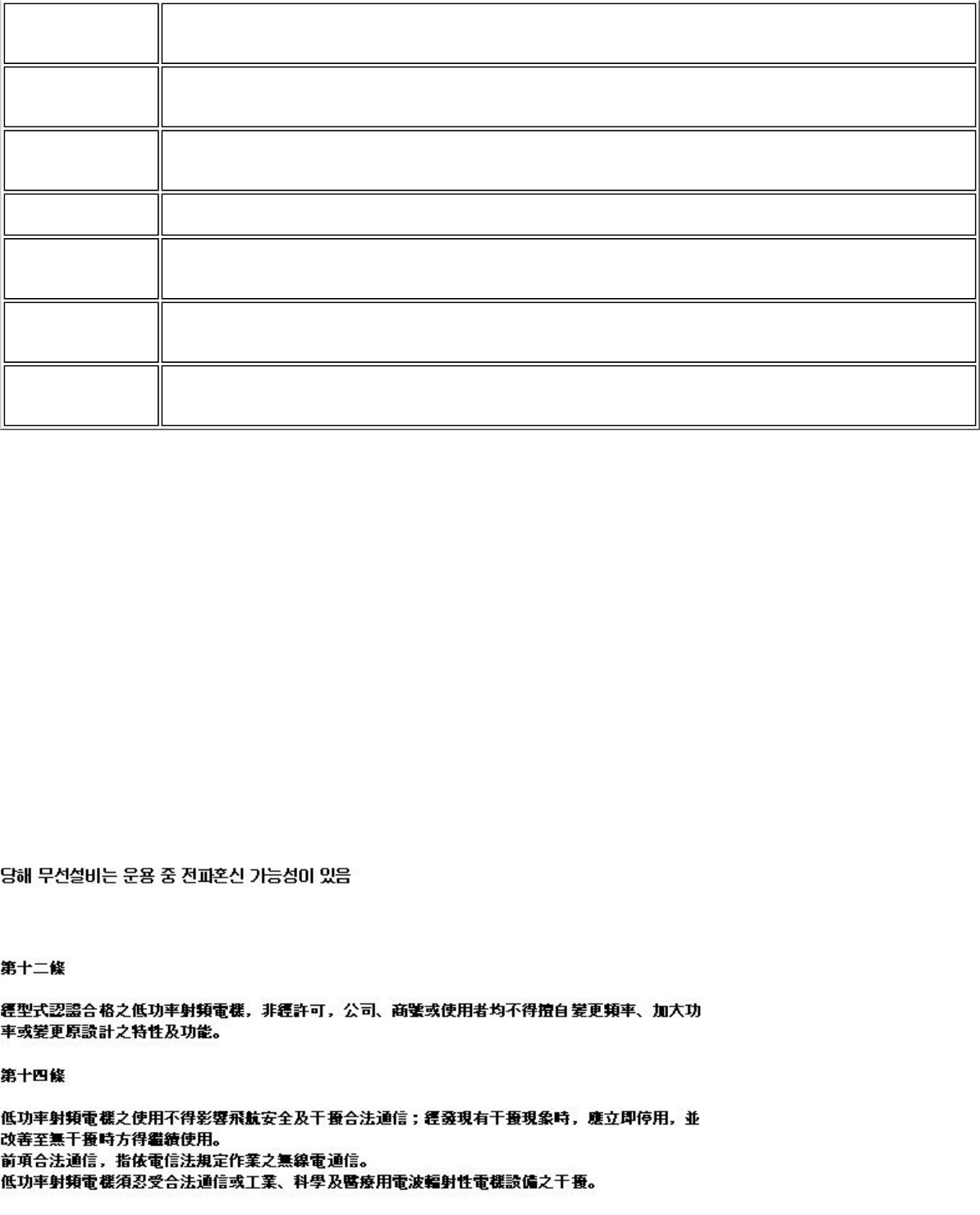
Polski
[Polish] Niniejszym, Intel(R) Corporation, o•wiadcza, •e Intel(R) Wireless WiFi Link 4965AGN or Intel(R)
Wireless WiFi Link 4965AG_ jest zgodne z zasadniczymi wymaganiami oraz innymi stosownymi
postanowieniami Dyrektywy 1999/5/WE.
Português
[Portuguese] Intel(R) Corporation declara que este Intel(R) Wireless WiFi Link 4965AGN or Intel(R) Wireless WiFi
Link 4965AG_ está conforme com os requisitos essenciais e outras disposições da Directiva 1999/5/
CE.
Slovensko
[Slovenian] Šiuo Intel(R) Corporation izjavlja, da je ta Intel(R) Wireless WiFi Link 4965AGN or Intel(R) Wireless
WiFi Link 4965AG_ v skladu z bistvenimi zahtevami in ostalimi relevantnimi dolo•ili direktive 1999/5/
ES.
Slovensky
[Slovak] Intel(R) Corporation týmto vyhlasuje, že Intel(R) Wireless WiFi Link 4965AGN or Intel(R) Wireless
WiFi Link 4965AG_ sp••a základné požiadavky a všetky príslušné ustanovenia Smernice 1999/5/ES.
Suomi
[Finnish] Intel(R) Corporation vakuuttaa täten että Intel (R) Wireless WiFi Link 4965AGN or Intel(R) Wireless
WiFi Link 4965AG_ tyyppinen laite on direktiivin 1999/5/EY oleellisten vaatimusten ja sitä koskevien
direktiivin muiden ehtojen mukainen.
Svenska
[Swedish] Härmed intygar Intel(R) Corporation att denna Intel(R) Wireless WiFi Link 4965AGN or Intel(R)
Wireless WiFi Link 4965AG_ står I överensstämmelse med de väsentliga egenskapskrav och övriga
relevanta bestämmelser som framgår av direktiv 1999/5/EG.
Íslenska
[Icelandic] Hér með lýsir Intel(R) Corporation yfir því að Intel(R) Wireless WiFi Link 4965AGN or Intel(R) Wireless
WiFi Link 4965AG_ er í samræmi við grunnkröfur og aðrar kröfur, sem gerðar eru í tilskipun 1999/5/
EC.
Italy
The use of these equipments is regulated by:
1. D.L.gs 1.8.2003, n. 259, article 104 (activity subject to general authorization) for outdoor use and article 105 (free
use) for indoor use, in both cases for private use.
2. D.M. 28.5.03, for supply to public of RLAN access to networks and telecom services.
L’uso degli apparati è regolamentato da:
1. D.L.gs 1.8.2003, n. 259, articoli 104 (attività soggette ad autorizzazione generale) se utilizzati al di fuori del proprio
fondo e 105 (libero uso) se utilizzati entro il proprio fondo, in entrambi i casi per uso private.
2. D.M. 28.5.03, per la fornitura al pubblico dell’accesso R-LAN alle reti e ai servizi di telecomunicazioni.
Japan
Indoor use only.
Korea
Taiwan

Radio approvals
To determine whether you are allowed to use your wireless network device in a specific country, please check to see if the
radio type number that is printed on the identification label of your device is listed in the manufacturer's OEM Regulatory
Guidance document.
Intel(R) PRO/Wireless 3945ABG Network Connection and the Intel(R) PRO/
Wireless 3945BG Network Connection
The information in this document applies to the following products:
Tri-mode wireless LAN adapters (802.11a/802.11b/802.11g )
Intel(R) PRO/Wireless 3945ABG Network Connection (model WM3945ABG)
Dual-mode wireless LAN adapters (802.11b/802.11g )
Intel(R) PRO/Wireless 3945BG Network Connection (model WM3945BG)
NOTE: Due to the evolving state of regulations and standards in the wireless LAN field (IEEE 802.11 and
similar standards), the information provided herein is subject to change. Intel Corporation assumes no
responsibility for errors or omissions in this document. Nor does Intel make any commitment to update the
information contained herein.
Information for the user
Safety Notices
USA—FCC and FAA
The FCC with its action in ET Docket 96-8 has adopted a safety standard for human exposure to radio frequency (RF)
electromagnetic energy emitted by FCC certified equipment. The Intel(R) PRO/Wireless 3945ABG Network Connection
adapter, or the Intel(R) PRO/Wireless 3945BG Network Connection adapter meet the Human Exposure limits found in OET
Bulletin 65, supplement C, 2001, and ANSI/IEEE C95.1, 1992. Proper operation of this radio according to the instructions
found in this manual will result in exposure substantially below the FCC’s recommended limits.
The following safety precautions should be observed:
●Do not touch or move antenna while the unit is transmitting or receiving.
●Do not hold any component containing the radio such that the antenna is very close or touching any exposed parts of
the body, especially the face or eyes, while transmitting.
●Do not operate the radio or attempt to transmit data unless the antenna is connected; this behavior may cause
damage to the radio.
●Use in specific environments:
❍The use of wireless devices in hazardous locations is limited by the constraints posed by the safety directors of
such environments.
❍The use of wireless devices on airplanes is governed by the Federal Aviation Administration (FAA).
❍The use of wireless devices in hospitals is restricted to the limits set forth by each hospital.
Antenna Use
●In order to comply with FCC RF exposure limits, low gain integrated antennas should be located at a minimum
distance of 20 cm (8 inches) or more from the body of all persons.
●High-gain, wall-mount, or mast-mount antennas are designed to be professionally installed and should be located at
a minimum distance of 30 cm (12 inches) or more from the body of all persons. Please contact your professional
installer, VAR, or antenna manufacturer for proper installation requirements.
Explosive Device Proximity Warning

Warning: Do not operate a portable transmitter (such as a wireless network device) near unshielded blasting caps or
in an explosive environment unless the device has been modified to be qualified for such use.
Antenna Warnings
Warning: To comply with the FCC and ANSI C95.1 RF exposure limits, it is recommended that when the Intel(R) PRO/
Wireless 3945ABG Network Connection or Intel(R) PRO/Wireless 3945BG Network Connection adapter is installed in a
desktop or portable computer, the antenna for this device be installed so as to provide a separation distance of al least 20
cm (8 inches) from all persons. It is recommended that the user limit exposure time if the antenna is positioned closer than
20 cm (8 inches).
Warning: Intel(R) PRO/Wireless LAN products are not designed for use with high-gain directional antennas. Use of
such antennas with these products in a manner other than as described in the previous section titled, “Antenna Use” is
illegal.
Use On Aircraft Caution
Caution: Regulations of the FCC and FAA prohibit airborne operation of radio-frequency wireless devices because their
signals could interfere with critical aircraft instruments.
Other Wireless Devices
Safety Notices for Other Devices in the Wireless Network: See the documentation supplied with wireless Ethernet
adapters or other devices in the wireless network.
Local Restrictions on 802.11a, 802.11b, and 802.11g Radio Usage
Caution: Due to the fact that the frequencies used by 802.11a, 802.11b and 802.11g wireless LAN devices may not
yet be harmonized in all countries, 802.11a, 802.11b, and 802.11g products are designed for use only in specific countries,
and are not allowed to be operated in countries other than those of designated use. As a user of these products, you are
responsible for ensuring that the products are used only in the countries for which they were intended and for verifying
that they are configured with the correct selection of frequency and channel for the country of use. The device transmit
power control (TPC) interface is part of the Intel(R) PROSet/Wireless WiFi Connection Utility. Operational restrictions for
Equivalent Isotropic Radiated Power (EIRP) are provided by the system manufacturer. Any deviation from the permissible
power and frequency settings for the country of use is an infringement of national law and may be punished as such.
For country-specific information, see the additional compliance information supplied with the product.
Wireless interoperability
The Intel(R) PRO/Wireless 3945ABG Network Connection and Intel(R) PRO/Wireless 3945BG Network Connection are
designed to be interoperable with other wireless LAN products that are based on direct sequence spread spectrum (DSSS)
radio technology and to comply with the following standards:
●IEEE Std. 802.11b compliant Standard on Wireless LAN
●IEEE Std. 802.11g compliant Standard on Wireless LAN
●IEEE Std. 802.11a compliant Standard on Wireless LAN
●Wireless Fidelity (Wi-Fi) certification, as defined by the Wi-Fi Alliance
The Intel(R) PRO/Wireless 3945ABG Network Connection adapter or the Intel(R) PRO/Wireless 3945BG
Network Connection adapter and your health
The Intel(R) PRO/Wireless 3945ABG Network Connection adapter or the Intel(R) PRO/Wireless 3945BG Network Connection
adapter, like other radio devices, emits radio frequency electromagnetic energy. The level of energy emitted by this device,
however, is less than the electromagnetic energy emitted by other wireless devices such as mobile phones. The Intel(R)
PRO/Wireless 3945ABG Network Connection adapter or the Intel(R) PRO/Wireless 3945BG Network Connection adapter
wireless device operates within the guidelines found in radio frequency safety standards and recommendations. These
standards and recommendations reflect the consensus of the scientific community and result from deliberations of panels

and committees of scientists who continually review and interpret the extensive research literature. In some situations or
environments, the use of the Intel(R) PRO/Wireless 3945ABG Network Connection adapter or the Intel(R) PRO/Wireless
3945BG Network Connection adapter may be restricted by the proprietor of the building or responsible representatives of
the applicable organization. Examples of such situations may include:
●Using the Intel(R) PRO/Wireless 3945ABG Network Connection adapter or the Intel(R) PRO/Wireless 3945BG
Network Connection adapter equipment on board airplanes, or
●Using the Intel(R) PRO/Wireless 3945ABG Network Connection adapter or the Intel(R) PRO/Wireless 3945BG
Network Connection adapter equipment in any other environment where the risk of interference with other devices
or services is perceived or identified as being harmful.
If you are uncertain of the policy that applies to the use of wireless devices in a specific organization or environment (an
airport, for example), you are encouraged to ask for authorization to use the Intel(R) PRO/Wireless 3945ABG Network
Connection adapter or the Intel(R) PRO/Wireless 3945BG Network Connection wireless devices before you turn it on.
Regulatory information
Information for the OEMs and Integrators
The following statement must be included with all versions of this document supplied to an OEM or integrator, but should
not be distributed to the end user.
●This device is intended for OEM integrators only.
●Please See the full Grant of Equipment document for other restrictions.
●This device must be operated and used with a locally approved access point.
Information To Be Supplied to the End User by the OEM or Integrator
The following regulatory and safety notices must be published in documentation supplied to the end user of the product or
system incorporating an Intel(R) PRO/Wireless 3945ABG Network Connection or an Intel(R) PRO/Wireless 3945BG Network
Connection in compliance with local regulations. Host system must be labeled with "Contains FCC ID: XXXXXXXX", FCC ID
displayed on label.
The Intel(R) PRO/Wireless 3945ABG Network Connection adapter or the Intel(R) PRO/Wireless 3945BG Network Connection
wireless network device must be installed and used in strict accordance with the manufacturer's instructions as described in
the user documentation that comes with the product. For country-specific approvals, see Radio approvals. Intel Corporation
is not responsible for any radio or television interference caused by unauthorized modification of the devices included with
the Intel(R) PRO/Wireless 3945ABG Network Connection or the Intel(R) PRO/Wireless 3945BG Network Connection adapter
kit, or the substitution or attachment of connecting cables and equipment other than that specified by Intel Corporation.
The correction of interference caused by such unauthorized modification, substitution or attachment is the responsibility of
the user. Intel Corporation and its authorized resellers or distributors are not liable for any damage or violation of
government regulations that may arise from the user failing to comply with these guidelines.
Local Restriction of 802.11a, 802.11b, and 802.11g Radio Usage
The following statement on local restrictions must be published as part of the compliance documentation for all 802.11a,
802.11b, and 802.11g products.
Caution: Due to the fact that the frequencies used by 802.11a, 802.11b, and 802.11g wireless LAN devices may not
yet be harmonized in all countries, 802.11a, 802.11b, and 802.11g products are designed for use only in specific countries,
and are not allowed to be operated in countries other than those of designated use. As a user of these products, you are
responsible for ensuring that the products are used only in the countries for which they were intended and for verifying
that they are configured with the correct selection of frequency and channel for the country of use. Any deviation from
permissible settings and restrictions in the country of use could be an infringement of national law and may be punished as
such.
FCC Radio Frequency Interference Requirements

This device is restricted to indoor use due to its operation in the 5.15 to 5.25 GHz frequency range. FCC requires this
product to be used indoors for the frequency range 5.15 to 5.25 GHz to reduce the potential for harmful interference to co-
channel Mobile Satellite systems. High power radars are allocated as primary users of the 5.25 to 5.35 GHz and 5.65 to
5.85 GHz bands. These radar stations can cause interference with and /or damage this device.
●This device is intended for OEM integrators only.
USA—Federal Communications Commission (FCC)
This device complies with Part 15 of the FCC Rules. Operation of the device is subject to the following two conditions:
●This device may not cause harmful interference.
●This device must accept any interference that may cause undesired operation.
NOTE: The radiated output power of the Intel(R) PRO/Wireless 3945ABG Network Connection adapter or the
Intel(R) PRO/Wireless 3945BG Network Connection adapter wireless network device is far below the FCC radio
frequency exposure limits. Nevertheless, the Intel(R) PRO/Wireless LAN wireless network device should be
used in such a manner that the potential for human contact during normal operation is minimized. To avoid
the possibility of exceeding the FCC radio frequency exposure limits, you should keep a distance of at least 20
cm between you (or any other person in the vicinity) and the antenna that is built into the computer. Details of
the authorized configurations can be found at http://www.fcc.gov/oet/ea/ by entering the FCC ID number on
the device.
Interference statement
This equipment has been tested and found to comply with the limits for a Class B digital device, pursuant to Part 15 of the
FCC Rules. These limits are designed to provide reasonable protection against harmful interference in a residential
installation. This equipment generates, uses, and can radiate radio frequency energy. If the equipment is not installed and
used in accordance with the instructions, the equipment may cause harmful interference to radio communications. There is
no guarantee, however, that such interference will not occur in a particular installation. If this equipment does cause
harmful interference to radio or television reception (which can be determined by turning the equipment off and on), the
user is encouraged to try to correct the interference by taking one or more of the following measures:
●Reorient or relocate the receiving antenna.
●Increase the distance between the equipment and the receiver.
●Connect the equipment to an outlet on a circuit different from that to which the receiver is connected.
●Consult the dealer or an experienced radio/TV technician for help.
NOTE: The Intel(R) PRO/Wireless 3945ABG Network Connection adapter or the Intel(R) PRO/Wireless 3945BG
Network Connection adapter wireless network device must be installed and used in strict accordance with the
manufacturer's instructions as described in the user documentation that comes with the product. Any other
installation or use will violate FCC Part 15 regulations.
Underwriters Laboratories Inc. (UL) Regulatory Warning
For use in (or with) UL Listed personal computers or compatible.
Brazil
Este equipamento opera em caráter secundário, isto é, não tem direito a proteção contra interferência prejudicial, mesmo
de estações do mesmo tipo, e não pode causar interferência a sistemas operando em caráter primário.
Canada—Industry Canada (IC)
This device complies with RSS210 of Industry Canada.
Caution: When using IEEE 802.11a wireless LAN, this product is restricted to indoor use due to its operation in the
5.15- to 5.25-GHz frequency range. Industry Canada requires this product to be used indoors for the frequency range of
5.15 GHz to 5.25 GHz to reduce the potential for harmful interference to co-channel mobile satellite systems. High power
radar is allocated as the primary user of the 5.25- to 5.35-GHz and 5.65 to 5.85-GHz bands. These radar stations can
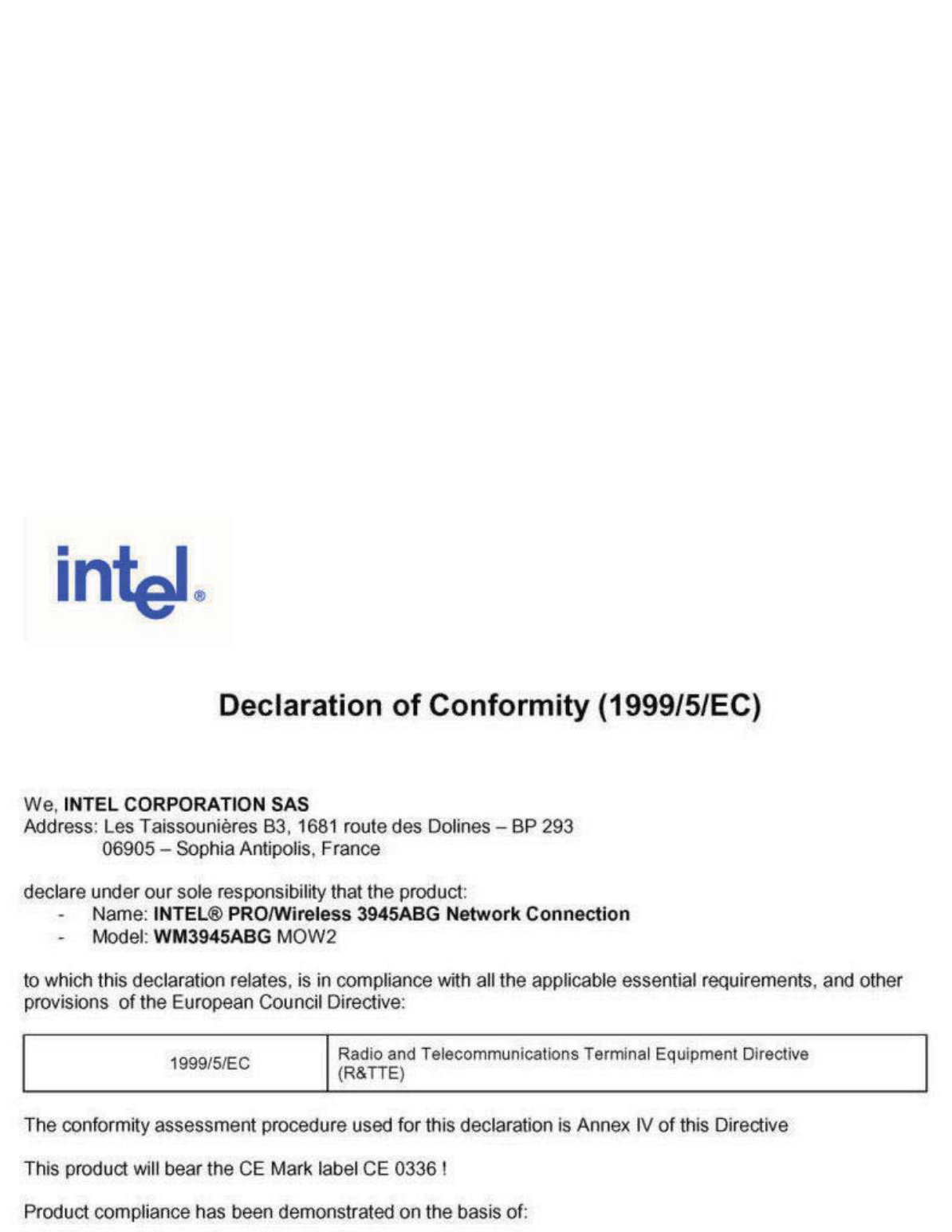
cause interference with and/or damage to this device.
The maximum allowed antenna gain for use with this device is 6dBi in order to comply with the E.I.R.P limit for the 5.25- to
5.35 and 5.725 to 5.85GHz frequency range in point-to-point operation.
This Class B digital apparatus complies with Canadian ICES-003, Issue 4, and RSS-210, No 4 (Dec 2000) and No 5 (Nov
2001).
Cet appareil numérique de la classe B est conforme à la norme NMB-003, No. 4, et CNR-210, No 4 (Dec 2000) et No 5 (Nov
2001).
"To prevent radio interference to the licensed service, this device is intended to be operated indoors and away from
windows to provide maximum shielding. Equipment (or its transmit antenna) that is installed outdoors is subject to
licensing."
« Pour empêcher que cet appareil cause du brouillage au service faisant l'objet d'une licence, il doit être utilisé a l'intérieur
et devrait être placé loin des fenêtres afinde fournir un écran de blindage maximal. Si le matériel (ou son antenne
d'émission) est installé à l'extérieur, il doit faire l'objet d'une licence.»
European Union
The low band 5.15 -5.35 GHz is for indoor use only.
Declaration of Conformity
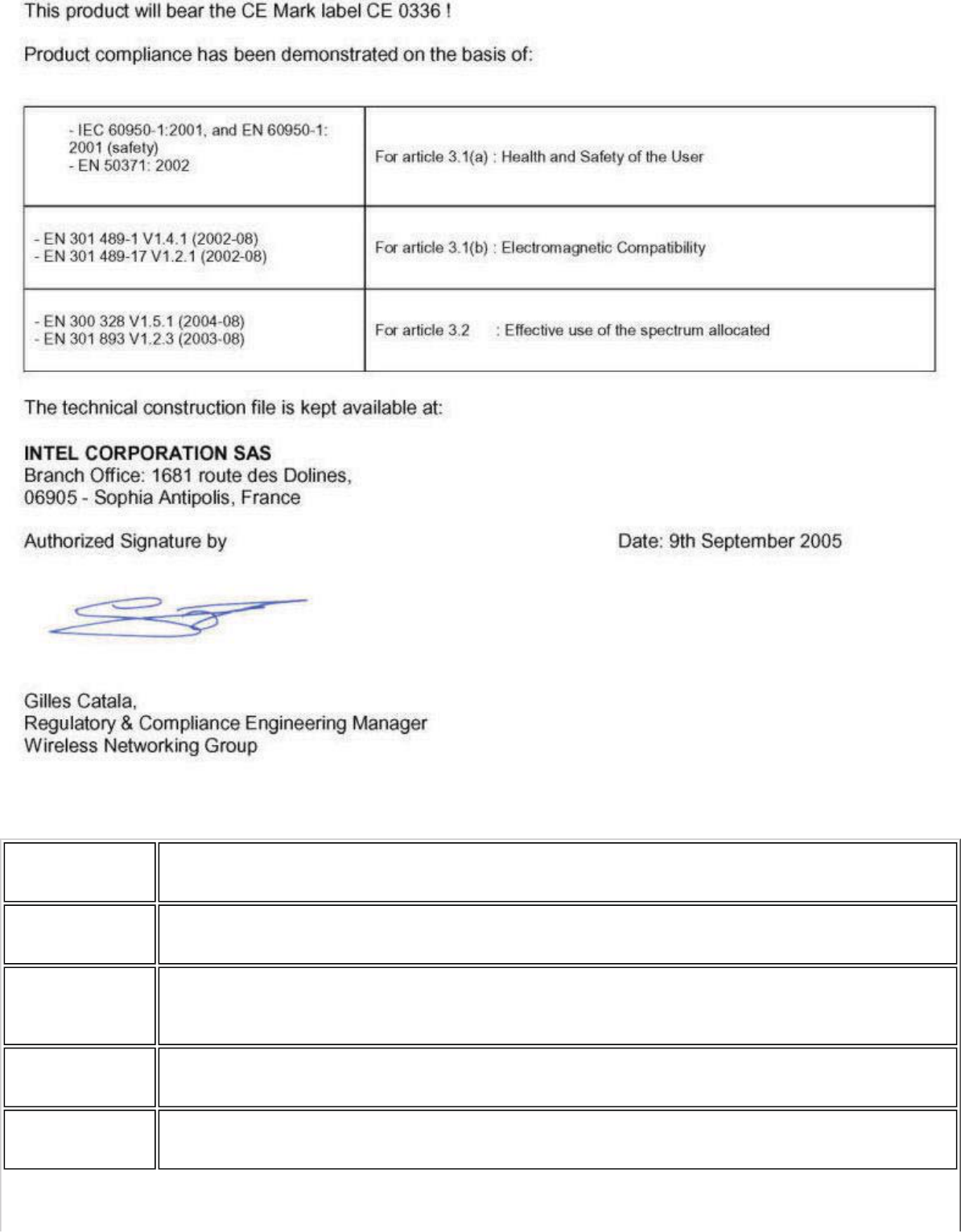
This equipment complies with the essential requirements of the European Union directive 1999/5/EC.
•esky
[Czech] Intel(R) Corporation tímto prohlašuje, že tento Intel(R) PRO/Wireless 3945ABG Network Connection
or Intel(R) PRO/Wireless 3945BG Network Connection je ve shod• se základními požadavky a dalšími
p•íslušnými ustanoveními sm•rnice 1999/5/ES.
Dansk
[Danish] Undertegnede Intel(R) Corporation erklærer herved, at følgende udstyr Intel(R) PRO/Wireless
3945ABG Network Connection or Intel(R) PRO/Wireless 3945BG Network Connection overholder de
væsentlige krav og øvrige relevante krav i direktiv 1999/5/EF.
Deutsch
[German] Hiermit erklärt Intel(R) Corporation, dass sich das Gerät Intel(R) PRO/Wireless 3945ABG Network
Connection or Intel(R) PRO/Wireless 3945BG Network Connection in Übereinstimmung mit den
grundlegenden Anforderungen und den übrigen einschlägigen Bestimmungen der Richtlinie 1999/5/
EG befindet.
Esti
[Estonian] Käesolevaga kinnitab Intel(R) Corporation seadme Intel(R) PRO/Wireless 3945ABG Network
Connection or Intel(R) PRO/Wireless 3945BG Network Connection vastavust direktiivi 1999/5/EÜ
põhinõuetele ja nimetatud direktiivist tulenevatele teistele asjakohastele sätetele.
English Hereby, Intel(R) Corporation, declares that this Intel(R) PRO/Wireless 3945ABG Network Connection
or Intel(R) PRO/Wireless 3945BG Network Connection is in compliance with the essential
requirements and other relevant provisions of Directive 1999/5/EC.

Español
[Spanish] Por medio de la presente Intel(R) Corporation declara que el Intel(R) PRO/Wireless 3945ABG Network
Connection or Intel(R) PRO/Wireless 3945BG Network Connection cumple con los requisitos
esenciales y cualesquiera otras disposiciones aplicables o exigibles de la Directiva 1999/5/CE.
Ελληνικ•
[Greek] ΜΕ ΤΗΝ ΠΑΡΟΥΣΑ Intel(R) Corporation ∆ΗΛΩΝΕΙ ΟΤΙ Intel(R) PRO/Wireless 3945ABG Network
Connection or Intel(R) PRO/Wireless 3945BG Network Connection ΣΥΜΜΟΡΦΩΝΕΤΑΙ ΠΡΟΣ ΤΙΣ
ΟΥΣΙΩ∆ΕΙΣ ΑΠΑΙΤΗΣΕΙΣ ΚΑΙ ΤΙΣ ΛΟΙΠΕΣ ΣΧΕΤΙΚΕΣ ∆ΙΑΤΑΞΕΙΣ ΤΗΣ Ο∆ΗΓΙΑΣ 1999/5/ΕΚ.
Français
[French] Par la présente Intel(R) Corporation déclare que l'appareil Intel(R) PRO/Wireless 3945ABG Network
Connection or Intel(R) PRO/Wireless 3945BG Network Connection est conforme aux exigences
essentielles et aux autres dispositions pertinentes de la directive 1999/5/CE.
Italiano
[Italian] Con la presente Intel(R) Corporation dichiara che questo Intel(R) PRO/Wireless 3945ABG Network
Connection or Intel(R) PRO/Wireless 3945BG Network Connection è conforme ai requisiti essenziali ed
alle altre disposizioni pertinenti stabilite dalla direttiva 1999/5/CE.
Latviski
[Latvian] Ar šo Intel(R) Corporationdeklar•, ka Intel(R) PRO/Wireless 3945ABG Network Connection or Intel(R)
PRO/Wireless 3945BG Network Connection atbilst Direkt•vas 1999/5/EK b•tiskaj•m pras•b•m un
citiem ar to saist•tajiem noteikumiem.
Lietuvi•
[Lithuanian] Šiuo Intel(R) Corporation deklaruoja, kad šis Intel(R) PRO/Wireless 3945ABG Network Connection or
Intel(R) PRO/Wireless 3945BG Network Connection atitinka esminius reikalavimus ir kitas 1999/5/EB
Direktyvos nuostatas.
Nederlands
[Dutch] Hierbij verklaart Intel(R) Corporation dat het toestel Intel(R) PRO/Wireless 3945ABG Network
Connection or Intel(R) PRO/Wireless 3945BG Network Connection in overeenstemming is met de
essentiële eisen en de andere relevante bepalingen van richtlijn 1999/5/EG.
Malti
[Maltese] Hawnhekk, Intel(R) Corporation, jiddikjara li dan Intel(R) PRO/Wireless 3945ABG Network Connection
or Intel(R) PRO/Wireless 3945BG Network Connection jikkonforma mal-•ti•ijiet essenzjali u ma
provvedimenti o•rajn relevanti li hemm fid-Dirrettiva 1999/5/EC.
Magyar
[Hungarian] Alulírott, Intel(R) Corporation nyilatkozom, hogy a Intel(R) PRO/Wireless 3945ABG Network
Connection or Intel(R) PRO/Wireless 3945BG Network Connection megfelel a vonatkozó alapvetõ
követelményeknek és az 1999/5/EC irányelv egyéb elõírásainak.
Norsk [Norwegian] Intel Corporation erklærer herved at utstyret Intel(R) PRO/Wireless 3945ABG Network Connection or
Intel(R) PRO/Wireless 3945BG Network Connection er i samsvar med de grunnleggende krav og
øvrige relevante krav i direktiv 1999/5/EF.
Polski
[Polish] Niniejszym, Intel(R) Corporation, o•wiadcza, •e Intel(R) PRO/Wireless 3945ABG Network Connection
or Intel(R) PRO/Wireless 3945BG Network Connection jest zgodne z zasadniczymi wymaganiami oraz
innymi stosownymi postanowieniami Dyrektywy 1999/5/WE.
Português
[Portuguese] Intel(R) Corporation declara que este Intel(R) PRO/Wireless 3945ABG Network Connection or Intel(R)
PRO/Wireless 3945BG Network Connection está conforme com os requisitos essenciais e outras
disposições da Directiva 1999/5/CE.
Slovensko
[Slovenian] Šiuo Intel(R) Corporation izjavlja, da je ta Intel(R) PRO/Wireless 3945ABG Network Connection or
Intel(R) PRO/Wireless 3945BG Network Connection v skladu z bistvenimi zahtevami in ostalimi
relevantnimi dolo•ili direktive 1999/5/ES.
Slovensky
[Slovak] Intel(R) Corporation týmto vyhlasuje, že Intel(R) PRO/Wireless 3945ABG Network Connection or Intel
(R) PRO/Wireless 3945BG Network Connection sp••a základné požiadavky a všetky príslušné
ustanovenia Smernice 1999/5/ES.
Suomi
[Finnish] Intel(R) Corporation vakuuttaa täten että Intel(R) PRO/Wireless 3945ABG Network Connection or Intel
(R) PRO/Wireless 3945BG Network Connection tyyppinen laite on direktiivin 1999/5/EY oleellisten
vaatimusten ja sitä koskevien direktiivin muiden ehtojen mukainen.
Svenska
[Swedish] Härmed intygar Intel(R) Corporation att denna Intel(R) PRO/Wireless 3945ABG Network Connection
or Intel(R) PRO/Wireless 3945BG Network Connection står I överensstämmelse med de väsentliga
egenskapskrav och övriga relevanta bestämmelser som framgår av direktiv 1999/5/EG.
Íslenska
[Icelandic] Hér með lýsir Intel(R) Corporation yfir því að Intel(R) PRO/Wireless 3945ABG Network Connection or
Intel(R) PRO/Wireless 3945BG Network Connection) er í samræmi við grunnkröfur og aðrar kröfur,
sem gerðar eru í tilskipun 1999/5/EC.
Italy
The use of these equipments is regulated by:
1. D.L.gs 1.8.2003, n. 259, article 104 (activity subject to general authorization) for outdoor use and article 105 (free
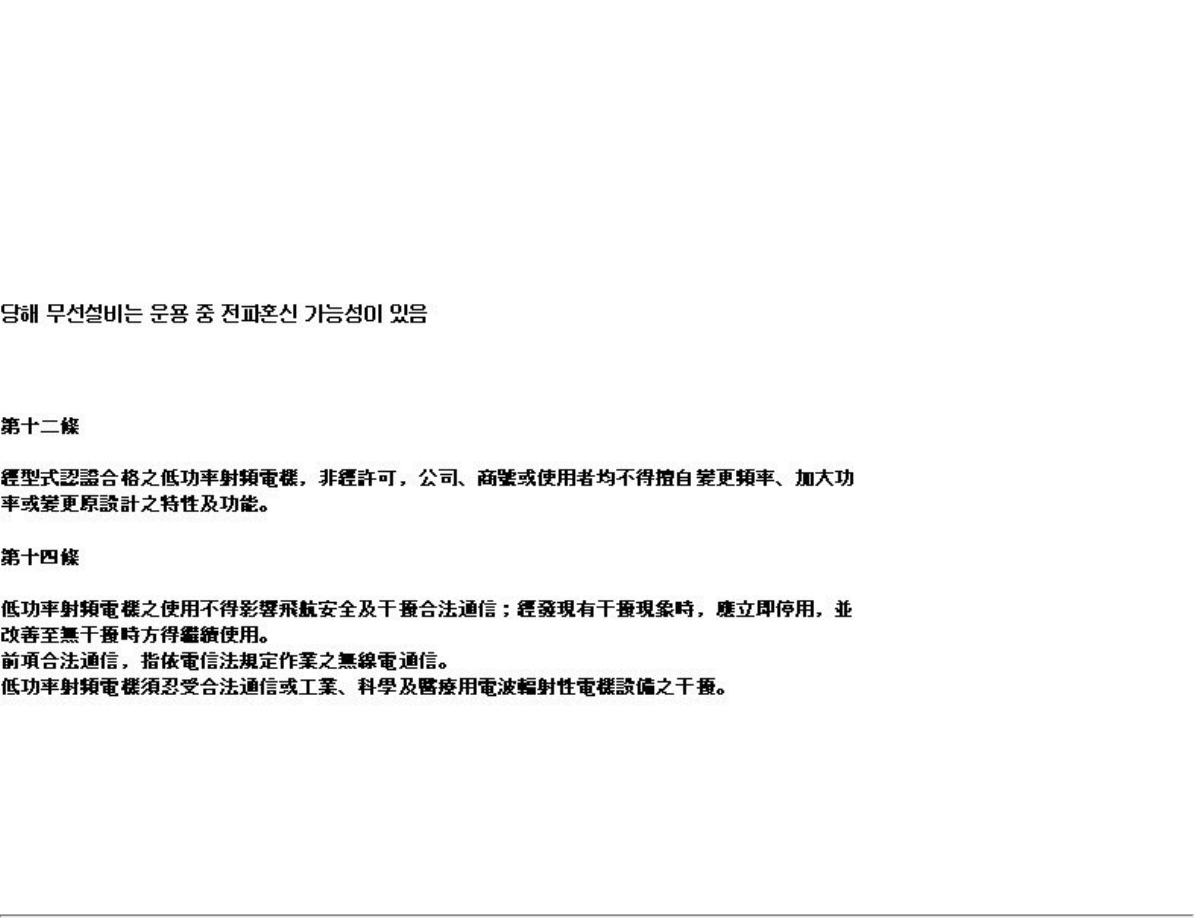
use) for indoor use, in both cases for private use.
2. D.M. 28.5.03, for supply to public of RLAN access to networks and telecom services.
L’uso degli apparati è regolamentato da:
1. D.L.gs 1.8.2003, n. 259, articoli 104 (attività soggette ad autorizzazione generale) se utilizzati al di fuori del proprio
fondo e 105 (libero uso) se utilizzati entro il proprio fondo, in entrambi i casi per uso privato.
2. D.M. 28.5.03, per la fornitura al pubblico dell’accesso R-LAN alle reti e ai servizi di telecomunicazioni.
Japan
Indoor use only.
Korea
Taiwan
Radio approvals
To determine whether you are allowed to use your wireless network device in a specific country, please check to see if the
radio type number that is printed on the identification label of your device is listed in the manufacturer's OEM Regulatory
Guidance document.
Intel(R) PRO/Wireless 2915ABG Network Connection
The information in this document applies to the following products:
Tri-mode wireless LAN adapters (802.11a/802.11b/802.11g )
Intel(R) PRO/Wireless 2915ABG Network Connection (model WM3B2915ABG)
Intel(R) PRO/Wireless 2915ABG Network Connection (model WM3A2915ABG)
NOTE: Due to the evolving state of regulations and standards in the wireless LAN field (IEEE 802.11 and
similar standards), the information provided herein is subject to change. Intel Corporation assumes no
responsibility for errors or omissions in this document. Nor does Intel make any commitment to update the
information contained herein.
Information for the user
Safety Notices

The FCC with its action in ET Docket 96-8 has adopted a safety standard for human exposure to radio frequency (RF)
electromagnetic energy emitted by FCC certified equipment. The Intel(R) PRO/Wireless 2915ABG Network Connection
adapter meets the Human Exposure limits found in OET Bulletin 65, supplement C, 2001, and ANSI/IEEE C95.1, 1992.
Proper operation of this radio according to the instructions found in this manual will result in exposure substantially below
the FCC’s recommended limits.
The following safety precautions should be observed:
●Do not touch or move antenna while the unit is transmitting or receiving.
●Do not hold any component containing the radio such that the antenna is very close or touching any exposed parts of
the body, especially the face or eyes, while transmitting.
●Do not operate the radio or attempt to transmit data unless the antenna is connected; this behavior may cause
damage to the radio.
●Use in specific environments:
❍The use of wireless devices in hazardous locations is limited by the constraints posed by the safety directors of
such environments.
❍The use of wireless devices on airplanes is governed by the Federal Aviation Administration (FAA).
❍The use of wireless devices in hospitals is restricted to the limits set forth by each hospital.
Antenna Use
●In order to comply with FCC RF exposure limits, low gain integrated antennas should be located at a minimum
distance of 20 cm (8 inches) or more from the body of all persons.
●High-gain, wall-mount, or mast-mount antennas are designed to be professionally installed and should be located at
a minimum distance of 30 cm (12 inches) or more from the body of all persons. Please contact your professional
installer, VAR, or antenna manufacturer for proper installation requirements.
Explosive Device Proximity Warning
Warning: Do not operate a portable transmitter (such as a wireless network device) near unshielded blasting caps or
in an explosive environment unless the device has been modified to be qualified for such use.
Antenna Warnings
Warning: To comply with the FCC and ANSI C95.1 RF exposure limits, it is recommended that when the Intel(R) PRO/
Wireless 2915ABG Network Connection adapter is installed in a desktop or portable computer, the antenna for this device
be installed so as to provide a separation distance of al least 20 cm (8 inches) from all persons. It is recommended that the
user limit exposure time if the antenna is positioned closer than 20 cm (8 inches).
Warning: Intel(R) PRO/Wireless LAN products are not designed for use with high-gain directional antennas. Use of
such antennas with these products in a manner other than as described in the previous section titled, “Antenna Use” is
illegal.
Use On Aircraft Caution
Caution: Regulations of the FCC and FAA prohibit airborne operation of radio-frequency wireless devices because their
signals could interfere with critical aircraft instruments.
Other Wireless Devices
Safety Notices for Other Devices in the Wireless Network: See the documentation supplied with wireless Ethernet
adapters or other devices in the wireless network.
Local Restrictions on 802.11a, 802.11b, and 802.11g Radio Usage
Caution: Due to the fact that the frequencies used by 802.11a, 802.11b, and 802.11g wireless LAN devices may not
yet be harmonized in all countries, 802.11a, 802.11b, and 802.11g products are designed for use only in specific countries,
and are not allowed to be operated in countries other than those of designated use. As a user of these products, you are
responsible for ensuring that the products are used only in the countries for which they were intended and for verifying

that they are configured with the correct selection of frequency and channel for the country of use. The device transmit
power control (TPC) interface is part of the Intel(R) PROSet/Wireless WiFi Connection Utility. Operational restrictions for
Equivalent Isotropic Radiated Power (EIRP) are provided by the system manufacturer. Any deviation from the permissible
power and frequency settings for the country of use is an infringement of national law and may be punished as such.
For country-specific information, see the additional compliance information supplied with the product.
Wireless interoperability
The Intel(R) PRO/Wireless 2915ABG Network Connection adapter is designed to be interoperable with other wireless LAN
products that are based on direct sequence spread spectrum (DSSS) radio technology and to comply with the following
standards:
●IEEE Std. 802.11b compliant Standard on Wireless LAN.
●IEEE Std. 802.11g compliant Standard on Wireless LAN.
●IEEE Std. 802.11a compliant Standard on Wireless LAN.
●Wireless Fidelity (Wi-Fi) certification, as defined by the Wi-Fi Alliance
The Intel(R) PRO/Wireless 2915ABG Network Connection adapter and your health
The Intel(R) PRO/Wireless 2915ABG Network Connection adapter, like other radio devices, emits radio frequency
electromagnetic energy. The level of energy emitted by this device, however, is less than the electromagnetic energy
emitted by other wireless devices such as mobile phones. The Intel(R) PRO/Wireless 2915ABG Network Connection adapter
wireless device operates within the guidelines found in radio frequency safety standards and recommendations. These
standards and recommendations reflect the consensus of the scientific community and result from deliberations of panels
and committees of scientists who continually review and interpret the extensive research literature. In some situations or
environments, the use of the Intel(R) PRO/Wireless 2915ABG Network Connection adapter wireless device may be
restricted by the proprietor of the building or responsible representatives of the applicable organization. Examples of such
situations may include:
●Using the Intel(R) PRO/Wireless 2915ABG Network Connection adapter equipment on board airplanes, or
●Using the Intel(R) PRO/Wireless 2915ABG Network Connection adapter equipment in any other environment where
the risk of interference with other devices or services is perceived or identified as being harmful
If you are uncertain of the policy that applies to the use of wireless devices in a specific organization or environment (an
airport, for example), you are encouraged to ask for authorization to use the Intel(R) PRO/Wireless 2915ABG Network
Connection adapter wireless device before you turn it on.
Regulatory information
Information for the OEMs and Integrators
The following statement must be included with all versions of this document supplied to an OEM or integrator, but should
not be distributed to the end user.
●This device is intended for OEM integrators only.
●Please See the full Grant of Equipment document for other restrictions.
●This device must be operated and used with a locally approved access point.
Information To Be Supplied to the End User by the OEM or Integrator
The following regulatory and safety notices must be published in documentation supplied to the end user of the product or
system incorporating an Intel(R) PRO/Wireless 2915ABG Network Connection in compliance with local regulations. Host
system must be labeled with "Contains FCC ID: XXXXXXXX", FCC ID displayed on label.
The Intel(R) PRO/Wireless 2915ABG Network Connection adapter wireless network device must be installed and used in
strict accordance with the manufacturer's instructions as described in the user documentation that comes with the product.
For country-specific approvals, see Radio approvals. Intel Corporation is not responsible for any radio or television

interference caused by unauthorized modification of the devices included with the Intel(R) PRO/Wireless 2915ABG Network
Connection adapter kit, or the substitution or attachment of connecting cables and equipment other than that specified by
Intel Corporation. The correction of interference caused by such unauthorized modification, substitution or attachment is
the responsibility of the user. Intel Corporation and its authorized resellers or distributors are not liable for any damage or
violation of government regulations that may arise from the user failing to comply with these guidelines.
Local Restriction of 802.11a, 802.11b, and 802.11g Radio Usage
The following statement on local restrictions must be published as part of the compliance documentation for all 802.11a,
802.11b, and 802.11g products.
Caution: Due to the fact that the frequencies used by 802.11a, 802.11b, and 802.11g wireless LAN devices may not
yet be harmonized in all countries, 802.11a, 802.11b, and 802.11g products are designed for use only in specific countries,
and are not allowed to be operated in countries other than those of designated use. As a user of these products, you are
responsible for ensuring that the products are used only in the countries for which they were intended and for verifying
that they are configured with the correct selection of frequency and channel for the country of use. Any deviation from
permissible settings and restrictions in the country of use could be an infringement of national law and may be punished as
such.
FCC Radio Frequency Interference Requirements
This device is restricted to indoor use due to its operation in the 5.15 to 5.25 GHz frequency range. FCC requires this
product to be used indoors for the frequency range 5.15 to 5.25 GHz to reduce the potential for harmful interference to co-
channel Mobile Satellite systems. High power radars are allocated as primary users of the 5.25 to 5.35 GHz and 5.65 to
5.85 GHz bands. These radar stations can cause interference with and /or damage this device.
●This device is intended for OEM integrators only.
USA—Federal Communications Commission (FCC)
This device complies with Part 15 of the FCC Rules. Operation of the device is subject to the following two conditions:
●This device may not cause harmful interference.
●This device must accept any interference that may cause undesired operation.
NOTE: The radiated output power of the Intel(R) PRO/Wireless 2915ABG Network Connection adapter wireless
network device is far below the FCC radio frequency exposure limits. Nevertheless, the Intel(R) PRO/Wireless
LAN wireless network device should be used in such a manner that the potential for human contact during
normal operation is minimized. To avoid the possibility of exceeding the FCC radio frequency exposure limits,
you should keep a distance of at least 20 cm between you (or any other person in the vicinity) and the
antenna that is built into the computer.
Interference Statement
This equipment has been tested and found to comply with the limits for a Class B digital device, pursuant to Part 15 of the
FCC Rules. These limits are designed to provide reasonable protection against harmful interference in a residential
installation. This equipment generates, uses, and can radiate radio frequency energy. If the equipment is not installed and
used in accordance with the instructions, the equipment may cause harmful interference to radio communications. There is
no guarantee, however, that such interference will not occur in a particular installation. If this equipment does cause
harmful interference to radio or television reception (which can be determined by turning the equipment off and on), the
user is encouraged to try to correct the interference by taking one or more of the following measures:
●Reorient or relocate the receiving antenna.
●Increase the distance between the equipment and the receiver.
●Connect the equipment to an outlet on a circuit different from that to which the receiver is connected.
●Consult the dealer or an experienced radio/TV technician for help.
NOTE: The Intel(R) PRO/Wireless 2915ABG Network Connection adapter wireless network device must be
installed and used in strict accordance with the manufacturer's instructions as described in the user
documentation that comes with the product. Any other installation or use will violate FCC Part 15 regulations.
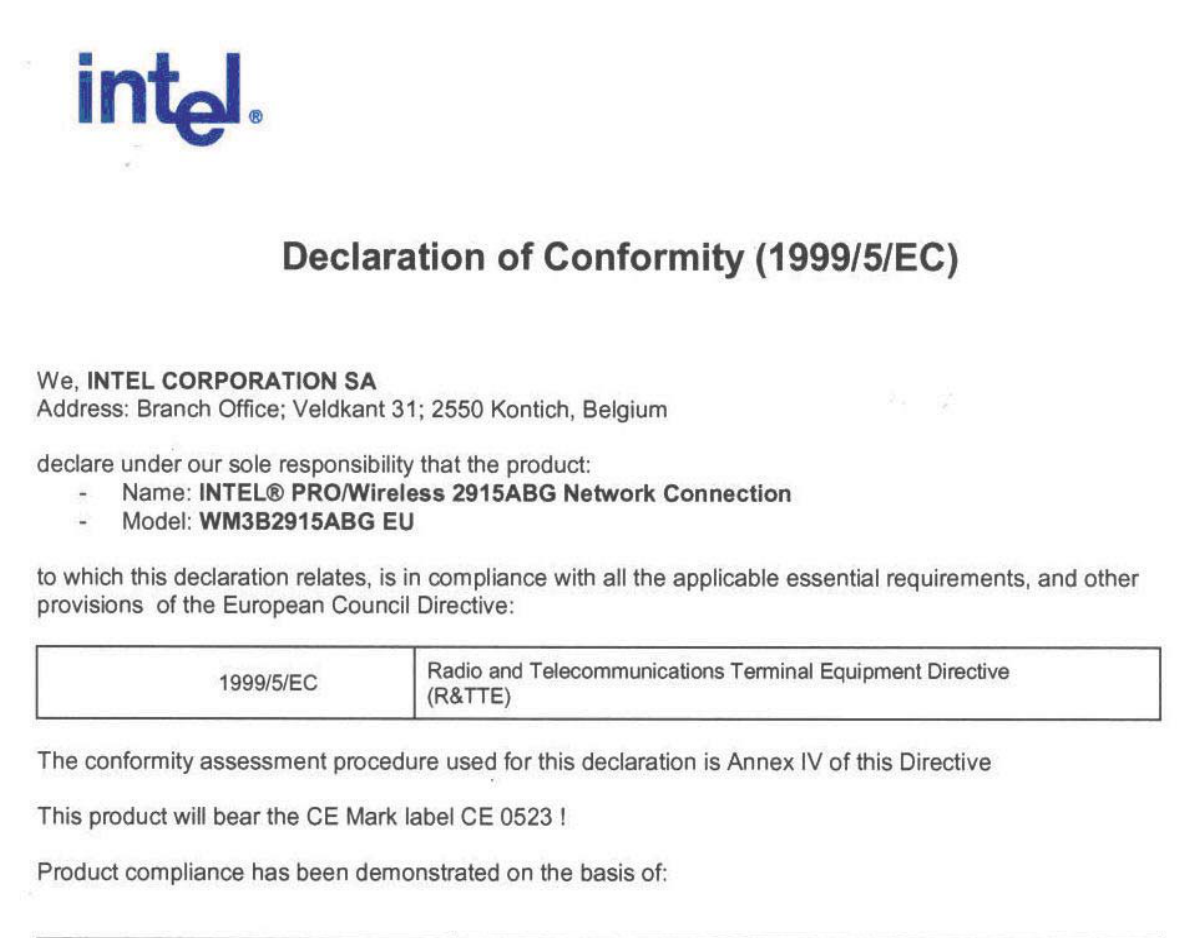
Canada—Industry Canada (IC)
This device complies with RSS210 of Industry Canada.
This Class B digital apparatus complies with Canadian ICES-003, Issue 4, and RSS-210, No 4 (Dec 2000) and No 5 (Nov
2001).
Cet appareil numérique de la classe B est conforme à la norme NMB-003, No. 4, et CNR-210, No 4 (Dec 2000) et No 5 (Nov
2001).
"To prevent radio interference to the licensed service, this device is intended to be operated indoors and away from
windows to provide maximum shielding. Equipment (or its transmit antenna) that is installed outdoors is subject to
licensing."
« Pour empêcher que cet appareil cause du brouillage au service faisant l'objet d'une licence, il doit être utilisé a l'intérieur
et devrait être placé loin des fenêtres afinde fournir un écran de blindage maximal. Si le matériel (ou son antenne
d'émission) est installé à l'extérieur, il doit faire l'objet d'une licence. »
European Union
The low band 5.15 -5.35 GHz is for indoor use only.
Declaration of Conformity
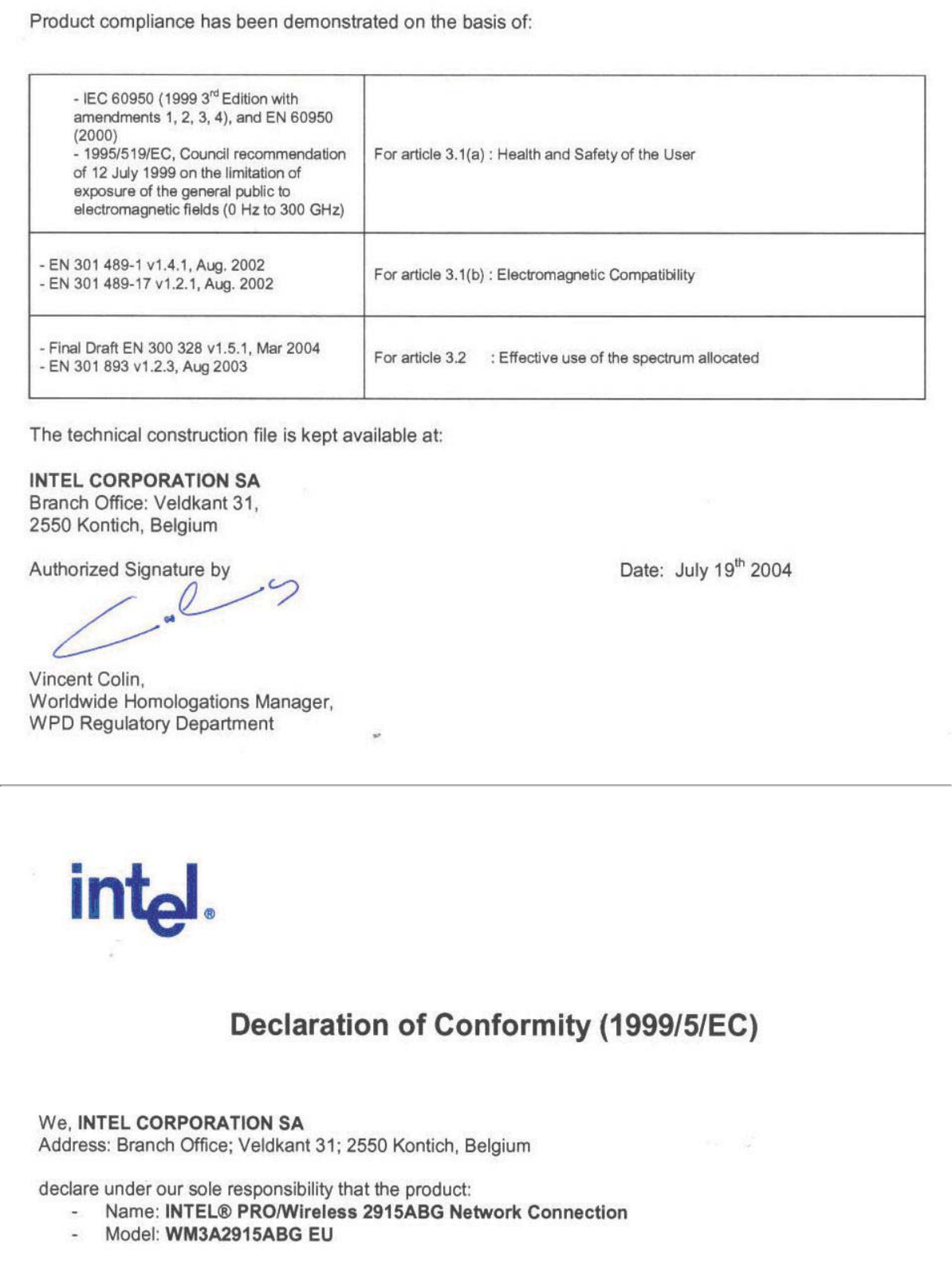
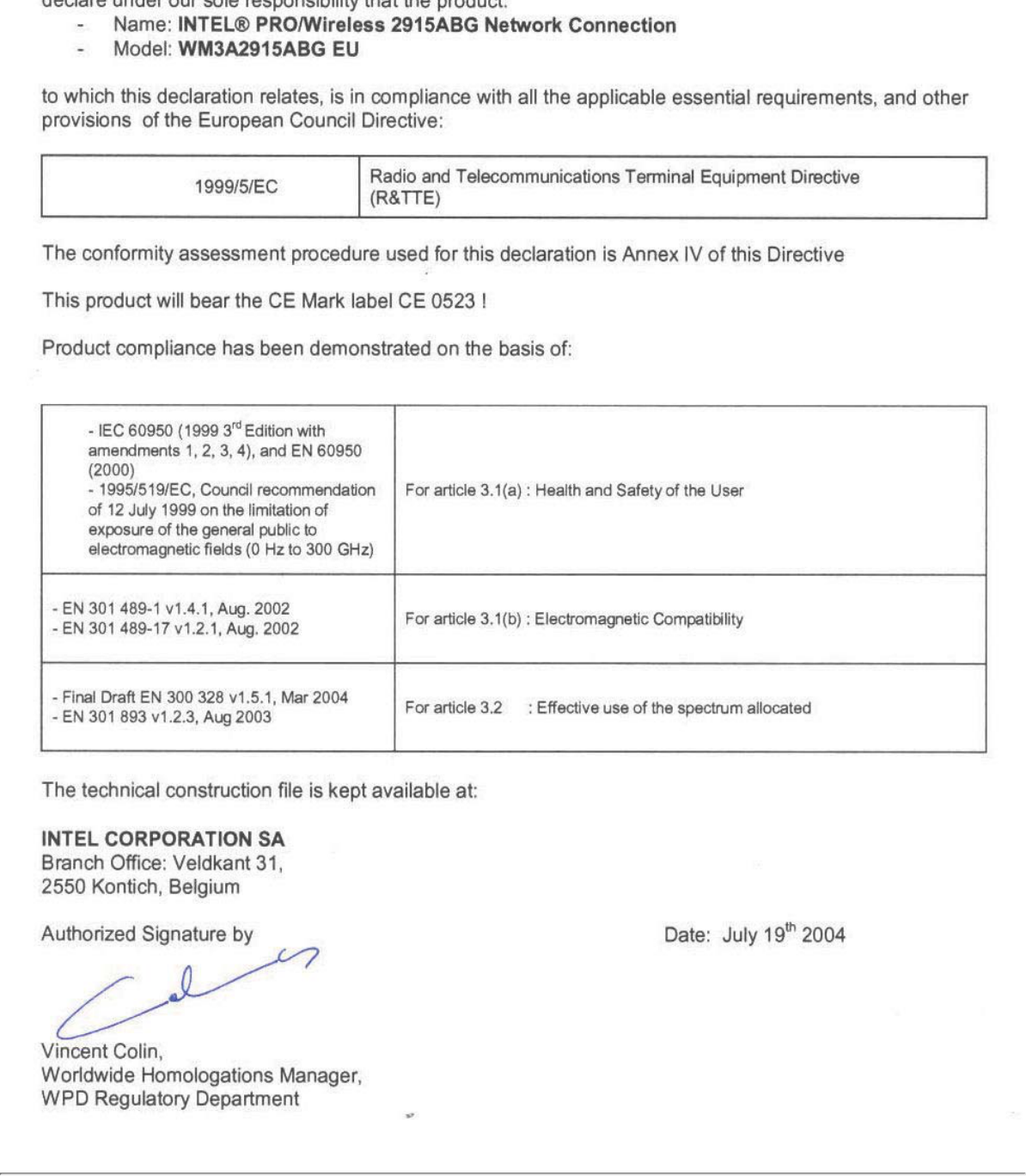
This equipment complies with the essential requirements of the European Union directive 1999/5/EC.

Czech Intel(R) Corporation tímto prohlašuje, že tento Intel(R) PRO/Wireless 2915ABG Network Connection je ve
shod• se základními požadavky a dalšími p•íslušnými ustanoveními sm•rnice 1999/5/ES."
Danish Undertegnede Intel(R) Corporation erklærer herved, at følgende udstyr Intel(R) PRO/Wireless 2915ABG
Network Connection overholder de væsentlige krav og øvrige relevante krav i direktiv 1999/5/EF
Dutch Hierbij verklaart Intel(R) Corporation dat het toestel Intel(R) PRO/Wireless 2915ABG Network Connection in
overeenstemming is met de essentiële eisen en de andere relevante bepalingen van richtlijn 1999/5/EG
Bij deze verklaart Intel(R) Corporation dat deze Intel(R) PRO/Wireless 2915ABG Network Connection voldoet
aan de essentiële eisen en aan de overige relevante bepalingen van Richtlijn 1999/5/EC.
English Hereby, Intel(R) Corporation, declares that this Intel(R) PRO/Wireless 2915ABG Network Connection is in
compliance with the essential requirements and other relevant provisions of Directive 1999/5/EC.
Estonian Käesolevaga kinnitab Intel(R) Corporation seadme Intel(R) PRO/Wireless 2915ABG Network Connection
vastavust direktiivi 1999/5/EÜ põhinõuetele ja nimetatud direktiivist tulenevatele teistele asjakohastele
sätetele.
Finnish Intel(R) Corporation vakuuttaa täten että Intel(R) PRO/Wireless 2915ABG Network Connection tyyppinen
laite on direktiivin 1999/5/EY oleellisten vaatimusten ja sitä koskevien direktiivin muiden ehtojen mukainen.
French Par la présente Intel(R) Corporation déclare que l'appareil Intel(R) PRO/Wireless 2915ABG Network
Connection est conforme aux exigences essentielles et aux autres dispositions pertinentes de la directive
1999/5/CE.
Par la présente, Intel(R) Corporation déclare que ce Intel(R) PRO/Wireless 2915ABG Network Connection est
conforme aux exigences essentielles et aux autres dispositions de la directive 1999/5/CE qui lui sont
applicables.
German Hiermit erklärt Intel(R) Corporation, dass sich dieser/diese/dieses Intel(R) PRO/Wireless 2915ABG Network
Connection in Übereinstimmung mit den grundlegenden Anforderungen und den anderen relevanten
Vorschriften der Richtlinie 1999/5/EG befindet". (BMWi)
Hiermit erklärt Intel(R) Corporation die Übereinstimmung des Gerätes Intel(R) PRO/Wireless 2915ABG
Network Connection mit den grundlegenden Anforderungen und den anderen relevanten Festlegungen der
Richtlinie 1999/5/EG. (Wien).=
Greek ΜΕ ΤΗΝ ΠΑΡΟΥΣΑ Intel(R) Corporation ∆ΗΛΩΝΕΙ ΟΤΙ Intel(R) PRO/Wireless 2915ABG Network Connection
ΣΥΜΜΟΡΦΩΝΕΤΑΙ ΠΡΟΣ ΤΙΣ ΟΥΣΙΩ∆ΕΙΣ ΑΠΑΙΤΗΣΕΙΣ ΚΑΙ ΤΙΣ ΛΟΙΠΕΣ ΣΧΕΤΙΚΕΣ ∆ΙΑΤΑΞΕΙΣ ΤΗΣ Ο∆ΗΓΙΑΣ 1999/5/
ΕΚ.
Hungarian Alulírott, Intel(R) Corporation nyilatkozom, hogy a Intel(R) PRO/Wireless 2915ABG Network Connection
megfelel a vonatkozó alapvetõ követelményeknek és az 1999/5/EC irányelv egyéb elõírásainak.
Icelandic Intel lysir her med yfir að thessi bunadur, Intel(R) PRO/Wireless 2915ABG Network Connection , uppfyllir
allar grunnkrofur, sem gerdar eru i R&TTE tilskipun ESB nr 1999/5/EC
Italian Con la presente Intel(R) Corporation dichiara che questo Intel(R) PRO/Wireless 2915ABG Network Connection
è conforme ai requisiti essenziali ed alle altre disposizioni pertinenti stabilite dalla direttiva 1999/5/CE.
Latvian Ar šo Intel(R) Corporationdeklar•, ka Intel(R) PRO/Wireless 2915ABG Network Connection atbilst Direkt•vas
1999/5/EK b•tiskaj•m pras•b•m un citiem ar to saist•tajiem noteikumiem.

Lithuanian Intel(R) Corporation deklaruoja, kad Intel(R) Pro/Wireless 2915ABG Network Connectionatitinka 1999/5/EC
Direktyvos esminius reikalavimus ir kitas nuostatas".
Malti Hawnhekk, Intel(R) Corporation, jiddikjara li dan Intel(R) PRO/Wireless 2915ABG Network Connection
jikkonforma mal-•ti•ijiet essenzjali u ma provvedimenti o•rajn relevanti li hemm fid-Dirrettiva 1999/5/EC.
Polish Niniejszym, Intel(R) Corporation, deklaruj•, •e Intel(R) PRO/Wireless 2915ABG Network Connection spe•nia
wymagania zasadnicze oraz stosowne postanowienia zawarte
Dyrektywie 1999/5/EC.
Portuguese Intel(R) Corporation declara que este Intel(R) PRO/Wireless 2915ABG Network Connection está conforme
com os requisitos essenciais e outras disposições da Directiva 1999/5/CE.
Slovak Intel(R) Corporation týmto vyhlasuje, že Intel(R) PRO/Wireless 2915ABG Network Connection sp••a základné
požiadavky a všetky príslušné ustanovenia Smernice 1999/5/ES.
Slovenia Šiuo Intel(R) Corporation deklaruoja, kad šis Intel(R) PRO/Wireless 2915ABG Network Connection atitinka
esminius reikalavimus ir kitas 1999/5/EB Direktyvos nuostatas.
Spanish Por medio de la presente Intel(R) Corporation declara que el Intel(R) PRO/Wireless 2915ABG Network
Connection cumple con los requisitos esenciales y cualesquiera otras disposiciones aplicables o exigibles de la
Directiva 1999/5/CE.
Swedish Härmed intygar Intel(R) Corporation att denna Intel(R) PRO/Wireless 2915ABG Network Connection står I
överensstämmelse med de väsentliga egenskapskrav och övriga relevanta bestämmelser som framgår av
direktiv 1999/5/EG.
France
Pour la France métropolitaine
2.400 - 2.4835 GHz (Canaux 1à 13) autorisé en usage intérieur
2.400 -2.454 GHz (canaux 1 à 7) autorisé en usage extérieur
Pour la Guyane et la Réunion
2.400 - 2.4835 GHz (Canaux 1à 13) autorisé en usage intérieur
2.420 - 2.4835 GHz (canaux 5 à 13) autorisé en usage extérieur
Pour tout le territoire Français:
Seulement 5.15 -5.35 GHz autorisé pour le 802.11a
Belgium
Dans le cas d'une utilisation privée, à l'extérieur d'un bâtiment, au-dessus d'un espace public, aucun enregistrement n'est
nécessaire pour une distance de moins de 300m. Pour une distance supérieure à 300m un enregistrement auprès de l'IBPT
est requise. Pour les enregistrements et licences, veuillez contacter l'IBPT.
In geval van privé-gebruik, buiten een gebouw, op een openbare plaats, is geen registratie nodig, wanneer de afstand
minder dan 300m is. Voor een afstand groter dan 300m is een registratie bij BIPT vereist. Voor registraties en licenties,
gelieve BIPT te contacteren.
Japan

Italy
The use of these equipments is regulated by:
- D.L.gs 1.8.2003, n. 259, article 104 (activity subject to general authorization) for outdoor use and article 105 (free use)
for indoor use, in both cases for private use.
- D.M. 28.5.03, for supply to public of RLAN access to networks and telecom services.
L’uso degli apparati è regolamentato da:
- D.L.gs 1.8.2003, n. 259, articoli 104 (attività soggette ad autorizzazione generale) se utilizzati al di fuori del proprio
fondo e 105 (libero uso) se utilizzati entro il proprio fondo, in entrambi i casi per uso privato.
- D.M. 28.5.03, per la fornitura al pubblico dell’accesso R-LAN alle reti e ai servizi di telecomunicazioni.
Greece
A license is required for the outdoor use of band 5.470 – 5.725 GHz.
Belarus
2.4 GHz OFDM (802.11g) is not allowed at this time.
Indonesia
5 GHz interface is not allowed at this time.
Kuwait
5 GHz interface is not allowed at this time.
Oman
If the modules are less than 100 milliwatts they are unlicensed but if they are more than 100 milliwatts, the user is
responsible for getting a license to operate from Telecommunications Regulatory Authority (TRA) in Sultanate of Oman.
Taiwan
Pakistan
Pakistan Telecommunication Authority (PTA) Approved
UAE

5 GHz interface is not allowed at this time.
Ukraine
5 GHz interface is not allowed at this time.
Radio approvals
To determine whether you are allowed to use your wireless network device in a specific country, please check to see if the
radio type number that is printed on the identification label of your device is listed in the manufacturer's OEM Regulatory
Guidance document.
Underwriters Laboratories Inc. (UL) Regulatory Warning
For use in (or with) UL Listed personal computers or compatible.
Regulatory Information: Intel(R) PRO/Wireless 2200BG Network Connection
Information for the User
Regulatory Information
Information for the user
Safety Notices
The FCC with its action in ET Docket 96-8 has adopted a safety standard for human exposure to radio frequency (RF)
electromagnetic energy emitted by FCC certified equipment. The Intel(R) PRO/Wireless 2200BG Network Connection meets
the Human Exposure limits found in OET Bulletin 65, 2001, and ANSI/IEEE C95.1, 1992. Proper operation of this radio
according to the instructions found in this manual will result in exposure substantially below the FCC’s recommended limits.
The following safety precautions should be observed:
●Do not touch or move antenna while the unit is transmitting or receiving.
●Do not hold any component containing the radio such that the antenna is very close or touching any exposed parts of
the body, especially the face or eyes, while transmitting.
●Do not operate the radio or attempt to transmit data unless the antenna is connected; this behavior may cause
damage to the radio.
●Use in specific environments:
❍The use of wireless devices in hazardous locations is limited by the constraints posed by the safety directors of
such environments.
❍The use of wireless devices on airplanes is governed by the Federal Aviation Administration (FAA).
❍The use of wireless devices in hospitals is restricted to the limits set forth by each hospital.
Antenna Use
●In order to comply with FCC RF exposure limits, low gain integrated antennas should be located at a minimum
distance of 20 cm (8 inches) or more from the body of all persons.
●High-gain, wall-mount, or mast-mount antennas are designed to be professionally installed and should be located at
a minimum distance of 30 cm (12 inches) or more from the body of all persons. Please contact your professional
installer, VAR, or antenna manufacturer for proper installation requirements.
Explosive Device Proximity Warning
Warning: Do not operate a portable transmitter (such as a wireless network device) near unshielded blasting caps or

in an explosive environment unless the device has been modified to be qualified for such use.
Antenna Warnings
Warning: To comply with the FCC and ANSI C95.1 RF exposure limits, it is recommended that when the Intel(R) PRO/
Wireless 2200BG Network Connection adapter is installed in a desktop or portable computer, the antenna for this device be
installed so as to provide a separation distance of al least 20 cm (8 inches) from all persons. It is recommended that the
user limit exposure time if the antenna is positioned closer than 20 cm (8 inches).
Warning: Intel(R) PRO/Wireless LAN products are not designed for use with high-gain directional antennas. Use of
such antennas with these products in a manner other than as described in the previous section titled, “Antenna Use” is
illegal.
Use On Aircraft Caution
Caution: Regulations of the FCC and FAA prohibit airborne operation of radio-frequency wireless devices because their
signals could interfere with critical aircraft instruments.
Local Restrictions on 802.11b and 802.11g Radio Usage
All frequencies used by 802.11b and 802.11g are harmonized. Some countries though may not allow 802.11g.
Wireless interoperability
The Intel(R) PRO/Wireless 2200BG Network Connection adapter is designed to be interoperable with any wireless LAN
product that is based on direct sequence spread spectrum (DSSS) radio technology and to comply with the following
standards:
●IEEE Std. 802.11b-1999. Standard on Wireless LAN.
●IEEE Std. 802.11g compliant. Standard on Wireless LAN.
●Wireless Fidelity (Wi-Fi) certification, as defined by the Wi-Fi Alliance
The Intel(R) PRO/Wireless LAN 2200BG Mini PCI adapter and your health
The Intel(R) PRO/Wireless 2200BG Network Connection adapter, like other radio devices, emits radio frequency
electromagnetic energy. The level of energy emitted by this device, however, is less than the electromagnetic energy
emitted by other wireless devices such as mobile phones. The Intel(R) PRO/Wireless 2200BG Network Connection adapter
wireless device operates within the guidelines found in radio frequency safety standards and recommendations. These
standards and recommendations reflect the consensus of the scientific community and result from deliberations of panels
and committees of scientists who continually review and interpret the extensive research literature. In some situations or
environments, the use of the Intel(R) PRO/Wireless 2200BG Network Connection adapter wireless device may be restricted
by the proprietor of the building or responsible representatives of the applicable organization. Examples of such situations
may include:
●Using the Intel(R) PRO/Wireless 2200BG Network Connection adapter equipment on board airplanes, or
●Using the Intel(R) PRO/Wireless 2200BG Network Connection adapter equipment in any other environment where
the risk of interference with other devices or services is perceived or identified as being harmful.
If you are uncertain of the policy that applies to the use of wireless devices in a specific organization or environment (an
airport, for example), you are encouraged to ask for authorization to use the Intel(R) PRO/Wireless 2200BG Network
Connection adapter wireless device before you turn it on.
Regulatory information
The Intel(R) PRO/Wireless 2200BG Network Connection adapter wireless network device must be installed and used in
strict accordance with the manufacturer's instructions as described in the user documentation that comes with the product.

For country-specific approvals, see Radio approvals. Intel Corporation is not responsible for any radio or television
interference caused by unauthorized modification of the devices included with the Intel(R) PRO/Wireless 2200BG Network
Connection adapter kit, or the substitution or attachment of connecting cables and equipment other than that specified by
Intel Corporation. The correction of interference caused by such unauthorized modification, substitution or attachment is
the responsibility of the user. Intel Corporation and its authorized resellers or distributors are not liable for any damage or
violation of government regulations that may arise from the user failing to comply with these guidelines.
USA—Federal Communications Commission (FCC)
This device complies with Part 15 of the FCC Rules. Operation of the device is subject to the following two conditions:
●This device may not cause harmful interference.
●This device must accept any interference that may cause undesired operation.
NOTE: The radiated output power of the Intel(R) PRO/Wireless 2200BG Network Connection adapter wireless
network device is far below the FCC radio frequency exposure limits. Nevertheless, the Intel(R) PROSet/
Wireless LAN wireless network device should be used in such a manner that the potential for human contact
during normal operation is minimized. To avoid the possibility of exceeding the FCC radio frequency exposure
limits, you should keep a distance of at least 2 cm between you (or any other person in the vicinity) and the
antenna that is built into the computer.
Interference Statement
This equipment has been tested and found to comply with the limits for a Class B digital device, pursuant to Part 15 of the
FCC Rules. These limits are designed to provide reasonable protection against harmful interference in a residential
installation. This equipment generates, uses, and can radiate radio frequency energy. If the equipment is not installed and
used in accordance with the instructions, the equipment may cause harmful interference to radio communications. There is
no guarantee, however, that such interference will not occur in a particular installation. If this equipment does cause
harmful interference to radio or television reception (which can be determined by turning the equipment off and on), the
user is encouraged to try to correct the interference by taking one or more of the following measures:
●Reorient or relocate the receiving antenna.
●Increase the distance between the equipment and the receiver.
●Connect the equipment to an outlet on a circuit different from that to which the receiver is connected.
●Consult the dealer or an experienced radio/TV technician for help.
NOTE: The Intel(R) PRO/Wireless 2200BG Network Connection adapter wireless network device must be
installed and used in strict accordance with the manufacturer's instructions as described in the user
documentation that comes with the product. Any other installation or use will violate FCC Part 15 regulations.
U.S. Frequency Bands
2.400 - 2.462 GHz
Canada—Industry Canada (IC)
This Class B digital apparatus complies with Canadian ICES-003, Issue 2, and RSS-210, Issue 4 (Dec. 2000).
Cet appareil numérique de la classe B est conforme à la norme NMB-003, No. 2, et CNR-210, No 4 (Dec 2000).
To prevent radio interference to the licensed service, this device is intended to be operated indoors and away from windows
to provide maximum shielding. Equipment (or its transmit antenna) that is installed outdoors is subject to licensing."
« Pour empêcher que cet appareil cause du brouillage au service faisant l'objet d'une licence, il doit être utilisé a l'intérieur
et devrait être placé loin des fenêtres afinde fournir un écran de blindage maximal. Si le matériel (ou son antenne
d'émission) est installé à l'extérieur, il doit faire l'objet d'une licence.»
Europe—EU Declaration of Conformity
European Frequency Bands
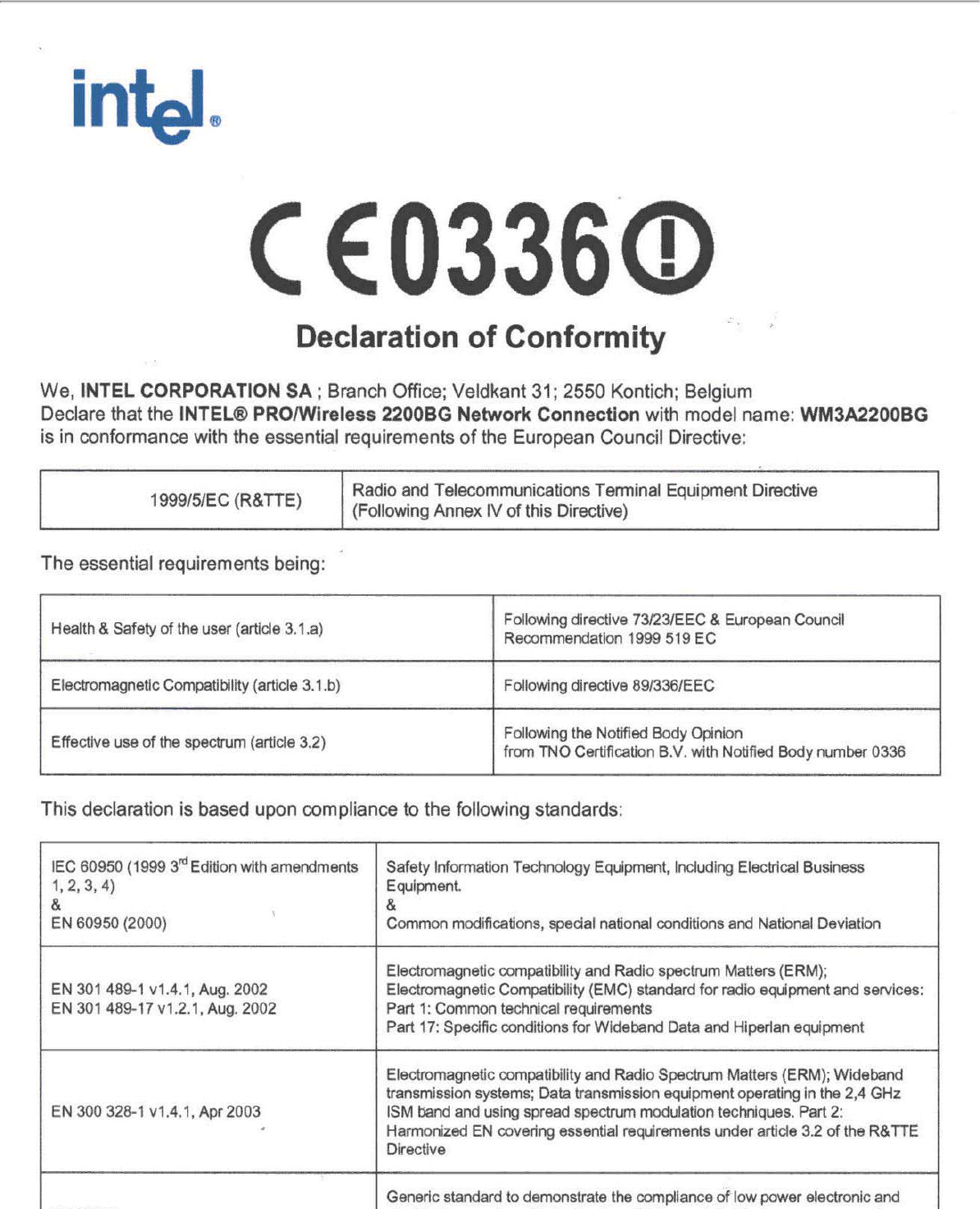
2.400 - 2.4835 GHz (Europe ETSI)
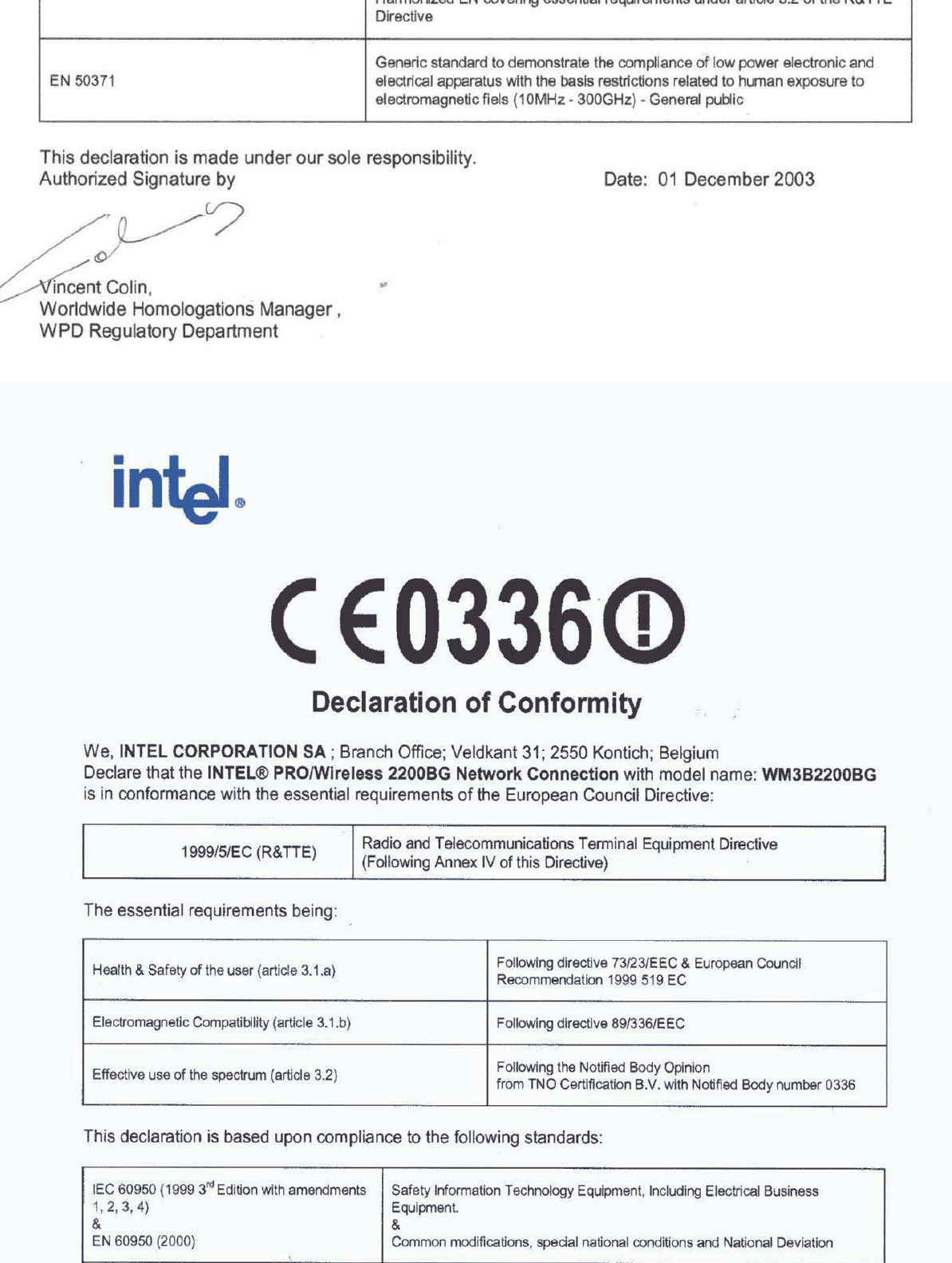
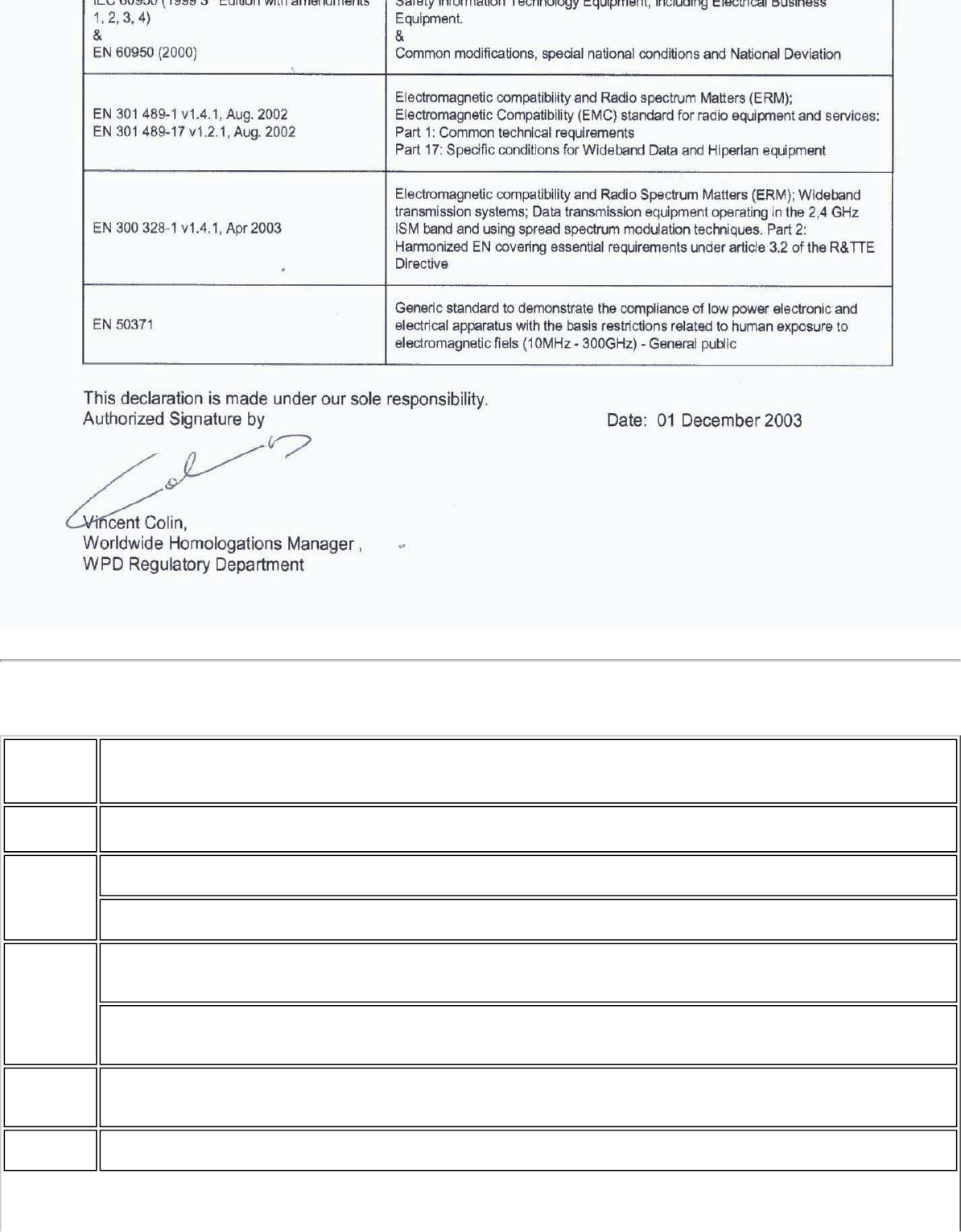
This equipment complies with the essential requirements of the European Union directive 1999/5/EC.
English Hereby, Intel(R) Corporation, declares that this Intel(R) PRO/Wireless 2200BG Network Connection is in
compliance with the essential requirements and other relevant provisions of Directive 1999/5/EC.
Finnish Intel(R) Corporation vakuuttaa täten että Intel(R) PRO/Wireless 2200BG Network Connectiontyyppinen laite
on direktiivin 1999/5/EY oleellisten vaatimusten ja sitä koskevien direktiivin muiden ehtojen mukainen.
Dutch Hierbij verklaart Intel(R) Corporation dat het toestel Intel(R) PRO/Wireless 2200BG Network Connection in
overeenstemming is met de essentiële eisen en de andere relevante bepalingen van richtlijn 1999/5/EG.
Bij deze verklaart Intel(R) Corporation dat deze Intel(R) PRO/Wireless 2200BG Network Connection voldoet
aan de essentiële eisen en aan de overige relevante bepalingen van Richtlijn 1999/5/EC.
French Par la présente Intel(R) Corporation déclare que l'appareil Intel(R) PRO/Wireless 2915ABG Network
Connection est conforme aux exigences essentielles et aux autres dispositions pertinentes de la directive
1999/5/CE.
Par la présente, Intel(R) Corporation déclare que ce Intel(R) PRO/Wireless 2200BG Network Connection est
conforme aux exigences essentielles et aux autres dispositions de la directive 1999/5/CE qui lui sont
applicables.
Swedish Härmed intygar Intel(R) Corporation att denna Intel(R) PRO/Wireless 2200BG Network Connection står I
överensstämmelse med de väsentliga egenskapskrav och övriga relevanta bestämmelser som framgår av
direktiv 1999/5/EG.
Danish Undertegnede Intel(R) Corporation erklærer herved, at følgende udstyr Intel(R) PRO/Wireless 2200BG
Network Connection overholder de væsentlige krav og øvrige relevante krav i direktiv 1999/5/EF.

German Hiermit erklärt Intel(R) Corporation, dass sich dieser/diese/dieses Intel(R) PRO/Wireless 2200BG Network
Connection in Übereinstimmung mit den grundlegenden Anforderungen und den anderen relevanten
Vorschriften der Richtlinie 1999/5/EG befindet". (BMWi)
Hiermit erklärt Intel(R) Corporation die Übereinstimmung des Gerätes Intel(R) PRO/Wireless 2200BG
Network Connection mit den grundlegenden Anforderungen und den anderen relevanten Festlegungen der
Richtlinie 1999/5/EG. (Wien)
Greek ΜΕ ΤΗΝ ΠΑΡΟΥΣΑ Intel(R) Corporation ∆ΗΛΩΝΕΙ ΟΤΙ Intel(R) PRO/Wireless 2200BG Network Connection
ΣΥΜΜΟΡΦΩΝΕΤΑΙ ΠΡΟΣ ΤΙΣ ΟΥΣΙΩ∆ΕΙΣ ΑΠΑΙΤΗΣΕΙΣ ΚΑΙ ΤΙΣ ΛΟΙΠΕΣ ΣΧΕΤΙΚΕΣ ∆ΙΑΤΑΞΕΙΣ ΤΗΣ Ο∆ΗΓΙΑΣ 1999/5/
ΕΚ.
Icelandic Intel lysir her med yfir að thessi bunadur, Intel(R) PRO/Wireless 2200BG Network Connection, uppfyllir allar
grunnkrofur, sem gerdar eru i R&TTE tilskipun ESB nr 1999/5/EC.
Italian Con la presente Intel(R) Corporation dichiara che questo Intel(R) PRO/Wireless 2200BG Network Connectionè
conforme ai requisiti essenziali ed alle altre disposizioni pertinenti stabilite dalla direttiva 1999/5/CE.
Spanish Por medio de la presente Intel(R) Corporation declara que el Intel(R) PRO/Wireless 2200BG Network
Connectioncumple con los requisitos esenciales y cualesquiera otras disposiciones aplicables o exigibles de la
Directiva 1999/5/CE.
Portuguese Intel(R) Corporation declara que este Intel(R) PRO/Wireless 2200BG Network Connection está conforme com
os requisitos essenciais e outras disposições da Directiva 1999/5/CE.
Malti Hawnhekk, Intel(R) Corporation, jiddikjara li dan Intel(R) PRO/Wireless 2200BG Network Connection
jikkonforma mal-•ti•ijiet essenzjali u ma provvedimenti o•rajn relevanti li hemm fid-Dirrettiva 1999/5/EC
New Member States requirements of Declaration of Conformity
Estonian Käesolevaga kinnitab Intel(R) Corporation seadme Intel(R) PRO/Wireless 2200BG Network
Connectionvastavust direktiivi 1999/5/EÜ põhinõuetele ja nimetatud direktiivist tulenevatele teistele
asjakohastele sätetele.
Hungarian Alulírott, Intel(R) Corporation nyilatkozom, hogy a Intel(R) PRO/Wireless 2200BG Network Connectionmegfelel
a vonatkozó alapvetõ követelményeknek és az 1999/5/EC irányelv egyéb elõírásainak
Slovak Intel(R) Corporation týmto vyhlasuje, že Intel(R) PRO/Wireless 2200BG Network Connection sp••a základné
požiadavky a všetky príslušné ustanovenia Smernice 1999/5/ES.
Czech Intel(R) Corporation tímto prohlašuje, že tento Intel(R) PRO/Wireless 2200BG Network Connection je ve shod•
se základními požadavky a dalšími p•íslušnými ustanoveními sm•rnice 1999/5/ES."
Slovenia Šiuo Intel(R) Corporation deklaruoja, kad šis Intel(R) PRO/Wireless 2200BGNetwork Connectionatitinka
esminius reikalavimus ir kitas 1999/5/EB Direktyvos nuostatas.
Latvian Ar šo Intel(R) Corporation deklar•, ka Intel(R) PRO/Wireless 2200BG Network Connection atbilst Direkt•vas
1999/5/EK b•tiskaj•m pras•b•m un citiem ar to saist•tajiem noteikumiem
Lithuanian Intel(R) Corporation deklaruoja, kadIntel(R) Pro/Wireless 2200BG Network Connectionatitinka 1999/5/EC
Direktyvosesminius reikalavimus irkitas nuostatas".
Polish Niniejszym, Intel(R) Corporation, deklaruj•, •e Intel(R) PRO/Wireless 2200BG Network Connection spe•nia
wymagania zasadnicze oraz stosowne postanowienia zawarte
Dyrektywie 1999/5/EC.
France
Pour la France métropolitaine
2.400 - 2.4835 GHz (Canaux 1à 13) autorisé en usage intérieur
2.400 -2.454 GHz (canaux 1 à 7) autorisé en usage extérieur
Pour la Guyane et la Réunion
2.400 - 2.4835 GHz (Canaux 1à 13) autorisé en usage intérieur
2.420 - 2.4835 GHz (canaux 5 à 13) autorisé en usage extérieur
Pour tout le territoire Français:
Seulement 5.15 -5.35 GHz autorisé pour le 802.1
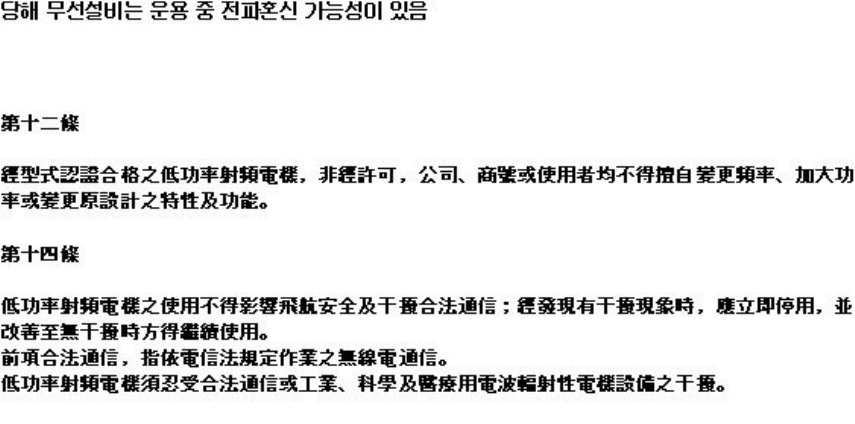
Belgique
Dans le cas d'une utilisation privée, à l'extérieur d'un bâtiment, au-dessus d'un espace public, aucun enregistrement n'est
nécessaire pour une distance de moins de 300m. Pour une distance supérieure à 300m un enregistrement auprès de l'IBPT
est requise. Pour les enregistrements et licences, veuillez contacter l'IBPT.
In geval van privé-gebruik, buiten een gebouw, op een openbare plaats, is geen registratie nodig, wanneer de afstand
minder dan 300m is. Voor een afstand groter dan 300m is een registratie bij BIPT vereist. Voor registraties en licenties,
gelieve BIPT te contacteren.
Italia
The use of these equipments is regulated by:
- D.L.gs 1.8.2003, n. 259, article 104 (activity subject to general authorization) for outdoor use and article 105 (free use)
for indoor use, in both cases for private use.
- D.M. 28.5.03, for supply to public of RLAN access to networks and telecom services.
L’uso degli apparati è regolamentato da:
- D.L.gs 1.8.2003, n. 259, articoli 104 (attività soggette ad autorizzazione generale) se utilizzati al di fuori del proprio
fondo e 105 (libero uso) se utilizzati entro il proprio fondo, in entrambi i casi per uso privato.
- D.M. 28.5.03, per la fornitura al pubblico dell’accesso R-LAN alle reti e ai servizi di telecomunicazioni.
Belarus
2.4 GHz OFDM (802.11g) is not allowed at this time.
Korea
Taiwan
Pakistan
Pakistan Telecommunication Authority (PTA) Approved
Radio approvals
To determine whether you are allowed to use your wireless network device in a specific country, please check to see if the
radio type number that is printed on the identification label of your device is listed in the manufacturer's OEM Regulatory
Guidance document.

Back to Contents

Back to Contents
Specifications
●Intel(R) WiMAX/WiFi Link 5350
●Intel(R) WiMAX/WiFi Link 5150
●Intel(R) WiFi Link 5300
●Intel(R) WiFi Link 5100
●Intel(R) Wireless WiFi Link 4965AGN
●Intel(R) Wireless WiFi Link 4965AG_
●Intel(R) PRO/Wireless 3945ABG Network Connection
●Intel(R) PRO/Wireless 3945BG Network Connection
●Intel(R) PRO/Wireless 2915ABG Network Connection
●Intel(R) PRO/Wireless 2200BG Network Connection
Intel(R) WiFi Link 5150 and Intel(R) WiFi Link 5350
WiFi / WiMAX
Form Factor PCI Express* Mini Card and Half-Mini Card
SKUs Intel® WiMAX/WiFi Link 5350 - 3x3 MC
Intel® WiMAX/WiFi Link 5150 - 1X2 MC/HMC
Dimensions Mini Card: Width 20 in x Length 1.18 in x Height 0.18 in
(50.80 mm x 30 mm x 4.5 mm)
Half-Mini Card: Width 1.049 in x Length 1.18 in x Height
0.18 in (26.64 mm x 30 mm x 4.5 mm)
Antenna Interface
Connector Hirose U.FL-R-SMT mates with cable connector U.FL-LP-
066
Antenna Diversity On-board diversity
Connector Interface 53-pin Mini Card edge connector
Voltage 3.3 V
Operating Temperature 0 to +80 degrees Celsius

Humidity 50% to 90% non-condensing (at temperatures of 25 ºC
to 35 ºC)
WiFi
Frequency Modulation 5 GHz (802.11a/n) 2.4 GHz (802.11b/g/n)
Frequency band 5.15 GHz - 5.85 GHz
(dependent on country) 2.41-2.474 GHz
(dependent on country)
Modulation BPSK, QPSK, 16 QAM, 64
QAM CCK, DQPSK, DBPSK
Wireless Medium 5 GHz UNII: Orthogonal
Frequency Division
Multiplexing (OFDM)
2.4 GHz ISM: Orthogonal
Frequency Division
Multiplexing (OFDM)
Channels 4 to 12 (dependent on
country) Channel 1-11 (US only)
Channel 1-13 (Japan,
Europe)
IEEE 802.11n Data Rates Intel(R) WiFi Link 5350
450, 405, 360, 300, 270, 243, 240, 216.7, 195, 180,
173.3, 150, 144, 135, 130, 120, 117, 115.5, 90,
86.667, 72.2, 65, 60, 57.8, 45, 43.3, 30, 28.9, 21.7,
15, 14.4, 7.2 Mbps
Intel(R) WiFi Link 5150
300, 270, 243, 240, 180, 150, 144, 135, 130, 120, 117,
115.5, 90, 86.667, 72.2, 65, 60, 57.8, 45, 43.3, 30,
28.9, 21.7, 15, 14.4, 7.2 Mbps
IEEE 802.11a Data Rates 54, 48, 36, 24, 18, 12, 9, 6 Mbps
IEEE 802.11g Data Rates 54, 48, 36, 24, 18, 12, 9, 6 Mbps
IEEE 802.11b Data Rates 11, 5.5, 2, 1 Mbps
WiFi General
Operating Systems Microsoft Windows XP* (32 and 64 bit) and Windows
Vista* (32 and 64 bit)
Wi-Fi Alliance* certification Wi-Fi* certification for 802.11b, 802.11g, 802.11a,
802.11h, 802.11d, WPA-Personal, WPA-Enterprise,
WPA2-Personal, WPA2-Enterprise, WMM, WMM Power
Save, EAP-SIM, LEAP, PEAP, TKIP, EAP-FAST, EAP-TLS,
EAP-TTLS
Cisco Compatible
Extensions certification Cisco Compatible Extensions, v4.0
WLAN Standard IEEE 802.11g, 802.11b, 802.11a, 802.11n
Architecture Infrastructure or ad hoc (peer-to-peer) operating modes
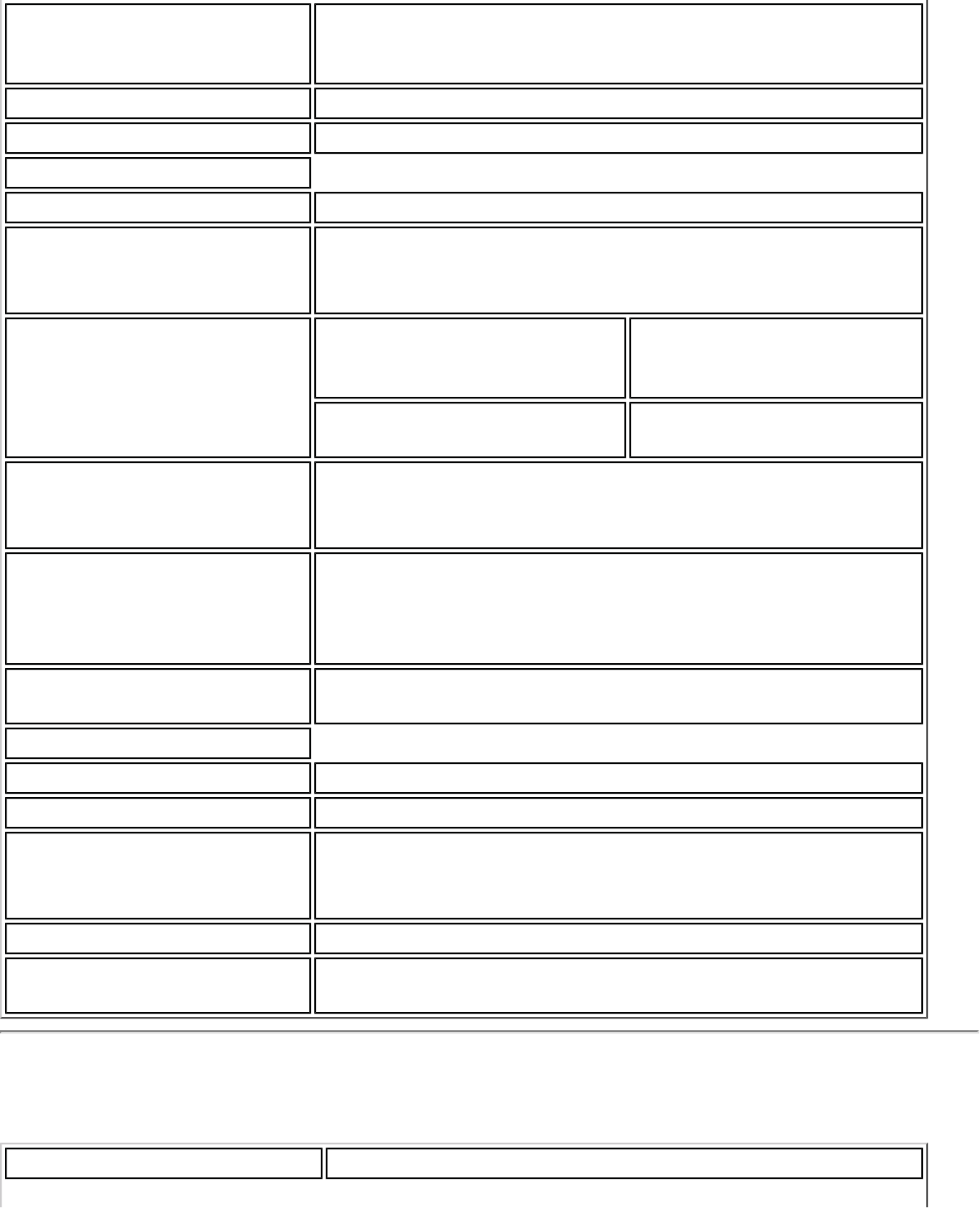
Security WPA-Personal, WPA2-Personal, WPA-Enterprise, WPA2-
Enterprise, 802.1X: EAP-SIM, LEAP, PEAP, EAP-FAST,
EAP-TLS, EAP-TTLS, EAP-AKA
Encryption AES-CCMP 128-bit, WEP 128-bit and 64-bit, CKIP, TKIP
Product Safety UL, C-UL, CB (IEC 60590)
WiMAX
Frequency band 2.5-2.7 GHz (3A Profile)
Modulation UL - QPSK, 16 QAM
DL - QPSK, 16 QAM, 64 QAM
Wireless Medium Duplex mode: TDD
operations Scalable OFDMA
(SOFDMA): 512 and 1024
FFT
sub-carrier permutation:
PUSC Channel bandwidths: 5
MHz and 10 MHz
WiMAX Network Release
Feature set SPWG/NWG Release 1.0
SPWG/NWG Release 1.5
Rate Performance (OTA
performance
10MHz channel)
10 Mbps DL and 4 Mbps UL @ peak rate
RF Transmitter Output
Power Compliance with Power class 2
WiMAX General
Operating Systems Microsoft Windows XP* ,Vista*
Standard Compliance 802.16e-2005 Corrigenda 2 (D4)
WiMAX System Profile
Feature set Mobile WiMAX release 1, Wave II
Profile 3A
Security Key Management Protocol (PKMv2)
Encryption 128bit CCMP (Counter-Mode/CBC-MAC) based on AES
encryption
Intel(R) WiFi Link 5300 and Intel(R) WiFi Link 5100
Form Factor PCI Express* Full-Mini Card and Half-Mini Card

Dimensions Full-Mini Card: Width 2.00 in x Length 1.18 in x Height
0.18 in (50.95 mm x 30 mm x 4.5 mm)
Half-Mini Card: Width 1.049 in x Length 1.18 in x
Height 0.18 in (26.64 mm x 30 mm x 4.5 mm)
Antenna Interface Connector Hirose U.FL-R-SMT mates with cable connector U.FL-LP-
066
Antenna Diversity On-board diversity
Connector Interface 52-pin Mini Card edge connector
Voltage 3.3 V
Operating Temperature 0 to +80 degrees Celsius
Humidity 50% to 95% non-condensing (at temperatures of 25 ºC
to 35 ºC)
Frequency Modulation 5 GHz (802.11a/n) 2.4 GHz (802.11b/g/n)
Frequency band 5.15 GHz - 5.85 GHz
(dependent on country) 2.400 - 2.4835 GHz
(dependent on country)
Modulation BPSK, QPSK, 16 QAM, 64
QAM CCK, DQPSK, DBPSK
Wireless Medium 5 GHz UNII: Orthogonal
Frequency Division
Multiplexing (OFDM)
2.4 GHz ISM: Orthogonal
Frequency Division
Multiplexing (OFDM)
Channels 4 to 12 (dependent on
country) Channel 1-11 (US only)
Channel 1-13 (Japan,
Europe)
IEEE 802.11n Data Rates Intel(R) WiFi Link 5300
450, 405, 360, 300, 270, 243, 240, 216.7, 195, 180,
173.3, 150, 144, 135, 130, 120, 117, 115.5, 90,
86.667, 72.2, 65, 60, 57.8, 45, 43.3, 30, 28.9, 21.7,
15, 14.4, 7.2 Mbps
Intel(R) WiFi Link 5100
300, 270, 243, 240, 180, 150, 144, 135, 130, 120,
117, 115.5, 90, 86.667, 72.2, 65, 60, 57.8, 45, 43.3,
30, 28.9, 21.7, 15, 14.4, 7.2 Mbps
IEEE 802.11a Data Rates 54, 48, 36, 24, 18, 12, 9, 6 Mbps
IEEE 802.11g Data Rates 54, 48, 36, 24, 18, 12, 9, 6 Mbps
IEEE 802.11b Data Rates 11, 5.5, 2, 1 Mbps
General

Operating Systems Microsoft Windows XP* (32 and 64 bit) and Windows
Vista* (32 and 64 bit).
Wi-Fi Alliance* certification Wi-Fi* certification for 802.11b, 802.11g, 802.11a,
802.11h, 802.11d, WPA-Personal, WPA-Enterprise,
WPA2-Personal, WPA2-Enterprise, WMM, WMM Power
Save, EAP-SIM, LEAP, PEAP, TKIP, EAP-FAST, EAP-TLS,
EAP-TTLS, EAP-AKA
Cisco Compatible Extensions
certification Cisco Compatible Extensions, v4.0
WLAN Standard IEEE 802.11g, 802.11b, 802.11a, 802.11n
Architecture Infrastructure or ad hoc (peer-to-peer) operating modes
Security WPA-Personal, WPA2-Personal, WPA-Enterprise, WPA2-
Enterprise, AES-CCMP 128-bit, WEP 128-bit and 64-bit;
802.1X: EAP-SIM, LEAP, PEAP, TKIP, EAP-FAST, EAP-
TLS, EAP-TTLS, EAP-AKA
Product Safety UL, C-UL, CB (IEC 60590)
Intel(R) Wireless WiFi Link 4965AGN
Form Factor PCI Express* Mini Card
Dimensions Width 2.00 in x Length 1.18 in x Height 0.18 in (50.95
mm x 30 mm x 4.5 mm)
Antenna Interface Connector Hirose U.FL-R-SMT mates with cable connector U.FL-LP-
066
Antenna Diversity On-board diversity
Connector Interface 52-pin Mini Card edge connector
Voltage 3.3 V
Operating Temperature 0 to +80 degrees Celsius

Humidity 50% to 95% non-condensing (at temperatures of 25 ºC
to 35 ºC)
Frequency Modulation 5 GHz (802.11a/n) 2.4 GHz (802.11b/g/n)
Frequency band 5.15 GHz - 5.85 GHz
(dependent on country) 2.400 - 2.4835 GHz
(dependent on country)
Modulation BPSK, QPSK, 16 QAM, 64
QAM CCK, DQPSK, DBPSK
Wireless Medium 5 GHz UNII: Orthogonal
Frequency Division
Multiplexing (OFDM)
2.4 GHz ISM: Orthogonal
Frequency Division
Multiplexing (OFDM)
Channels 4 to 12 (dependent on
country) Channel 1-11 (US only)
Channel 1-13 (Japan,
Europe)
IEEE 802.11n Data Rates Rx: 300, 270, 243, 240, 180
Rx/Tx: 150, 144, 135, 130, 120, 117, 115.5, 90,
86.667, 72.2, 65, 60, 57.8, 45, 43.3, 30, 28.9, 21.7,
15, 14.4, 7.2
IEEE 802.11a Data Rates 54, 48, 36, 24, 18, 12, 9, 6 Mbps
IEEE 802.11g Data Rates 54, 48, 36, 24, 18, 12, 9, 6 Mbps
IEEE 802.11b Data Rates 11, 5.5, 2, 1 Mbps
General
Operating Systems Microsoft Windows XP* (32 and 64 bit) and Windows
Vista* (32 and 64 bit).

Wi-Fi Alliance* certification Wi-Fi* certification for 802.11b, 802.11g, 802.11a,
802.11h, 802.11d, WPA-Personal, WPA-Enterprise,
WPA2-Personal, WPA2-Enterprise, WMM, WMM Power
Save, EAP-SIM, LEAP, PEAP, TKIP, EAP-FAST, EAP-TLS,
EAP-TTLS, EAP-AKA
Cisco Compatible Extensions
certification Cisco Compatible Extensions, v4.0
WLAN Standard IEEE 802.11g, 802.11b, 802.11a, 802.11n
Architecture Infrastructure or ad hoc (peer-to-peer) operating modes
Security WPA-Personal, WPA2-Personal, WPA-Enterprise, WPA2-
Enterprise, AES-CCMP 128-bit, WEP 128-bit and 64-bit;
802.1X: EAP-SIM, LEAP, PEAP, TKIP, EAP-FAST, EAP-
TLS, EAP-TTLS, EAP-AKA
Product Safety UL, C-UL, CB (IEC 60590)
Intel(R) Wireless WiFi Link 4965AG_
This is a version of Intel Wireless WiFi 4965AGN with 8-2.11n capabilities disabled. 802.11n
refers to: IEEE P802.11n / D2.0 Draft Amendment to STANDARD [FOR] Information
Technology-Telecommunications and information exchange between systems-Local and
Metropolitan networks-Specific requirements-Part 11: Wireless LAN Medium Access Control
(MAC) and Physical Layer (PHY) specifications: Enhancements for Higher Throughput.
Form Factor PCI Express Mini Card
Dimensions Width 2.00 in x Length 1.18 in x Height 0.18 in (50.95
mm x 30 mm x 4.5 mm)
Antenna Interface Connector Hirose U.FL-R-SMT mates with cable connector U.FL-LP-
066
Antenna Diversity On-board diversity
Connector Interface 52-pin Mini Card edge connector
Voltage 3.3 V
Operating Temperature 0 to +80 degrees Celsius

Humidity 50% to 95% non-condensing (at temperatures of 25 ºC
to 35 ºC)
Frequency Modulation 5 GHz (802.11a) 2.4 GHz (802.11b/g)
Frequency band 5.15 GHz - 5.85 GHz
(dependent on country) 2.400 - 2.4835 GHz
(dependent on country)
Modulation BPSK, QPSK, 16 QAM, 64
QAM CCK, DQPSK, DBPSK
Wireless Medium 5 GHz UNII: Orthogonal
Frequency Division
Multiplexing (OFDM)
2.4 GHz ISM: Orthogonal
Frequency Division
Multiplexing (OFDM)
Channels 4 to 12 (dependent on
country) Channel 1-11 (US only)
Channel 1-13 (Japan,
Europe)
IEEE 802.11a Data Rates 54, 48, 36, 24, 18, 12, 9, 6 Mbps
IEEE 802.11g Data Rates 54, 48, 36, 24, 18, 12, 9, 6 Mbps
IEEE 802.11b Data Rates 11, 5.5, 2, 1 Mbps
General
Operating Systems Microsoft Windows XP (32 and 64 bit), and Windows
Vista (32 and 64 bit)
Wi-Fi Alliance* certification Wi-Fi* certification for 802.11b, 802.11g, 802.11a,
WPA, WPA2, WMM, EAP-SIM
Cisco Compatible Extensions
certification Cisco Compatible Extensions, v4.0
WLAN Standard IEEE 802.11g, 802.11b, 802.11a
Architecture Infrastructure or ad hoc (peer-to-peer) operating modes
Security WPA-Personal, WPA2-Personal, WPA-Enterprise, WPA2-
Enterprise, AES-CCMP 128-bit, WEP 128-bit and 64-bit;
802.1X: EAP-SIM, LEAP, PEAP, TKIP, EAP-FAST, EAP-
TLS, EAP-TTLS, EAP-AKA
Product Safety UL, C-UL, CB (IEC 60590)
Intel(R) PRO/Wireless 3945ABG Network Connection
Form Factor PCI Express Mini Card
Dimensions Width 2.00 in x Length 1.18 in x Height 0.18 in (50.95
mm x 30 mm x 4.5 mm)
Antenna Interface Connector Hirose U.FL-R-SMT mates with cable connector U.FL-LP-
066

Dual Diversity Antenna On-board dual diversity switching
Connector Interface 52-pin Mini Card edge connector
Voltage 3.3 V
Operating Temperature 0 to +80 degrees Celsius
Humidity 50 to 92% non-condensing (at temperatures of 25 ºC
to 55 ºC)
Frequency Modulation 5 GHz (802.11a) 2.4 GHz (802.11b/g)
Frequency band 5.15 GHz - 5.85 GHz 2.400 - 2.4835 GHz
(dependent on country)
Modulation BPSK, QPSK, 16 QAM, 64
QAM CCK, DQPSK, DBPSK
Wireless Medium 5 GHz UNII: Orthogonal
Frequency Division
Multiplexing (OFDM)
2.4 GHz ISM: Orthogonal
Frequency Division
Multiplexing (OFDM)
Channels 4 to 12 non-overlapping,
dependent on country Channel 1-11 (US only)
Channel 1-13 (Japan,
Europe)
Data Rates 54, 48, 36, 24, 18, 12, 9, 6
Mbps 11, 5.5, 2, 1 Mbps
General
Operating Systems Microsoft Windows XP and Windows Vista
Wi-Fi Alliance* certification Wi-Fi* certification for 802.11b, 802.11g, 802.11a,
802.11h, 802.11d, WPA-Personal, WPA-Enterprise,
WPA2-Personal, WPA2-Enterprise, WMM, WMM Power
Save, EAP-SIM, LEAP, PEAP, TKIP, EAP-FAST, EAP-TLS,
EAP-TTLS, EAP-AKA
Cisco Compatible Extensions
certification Cisco Compatible Extensions, v4.0
WLAN Standard IEEE 802.11g, 802.11b, 802.11a
Architecture Infrastructure or ad hoc (peer-to-peer) operating modes
Security WPA-Personal, WPA2-Personal, WPA-Enterprise, WPA2-
Enterprise, AES-CCMP 128-bit, WEP 128-bit and 64-bit;
802.1X: EAP-SIM, LEAP, PEAP, TKIP, EAP-FAST, EAP-
TLS, EAP-TTLS, EAP-AKA
Product Safety UL, C-UL, CB (IEC 60590)
Intel(R) PRO/Wireless 3945BG Network Connection

Form Factor PCI Express Mini Card
Dimensions Width 2.00 in x Length 1.18 in x Height
0.18 in (50.95 mm x 30 mm x 4.5 mm)
Antenna Interface Connector Hirose U.FL-R-SMT mates with cable
connector U.FL-LP-066
Dual Diversity Antenna On-board dual diversity switching
Connector Interface 52-pin Mini Card edge connector
Voltage 3.3 V
Operating Temperature 0 to +80 degrees Celsius
Humidity 50 to 92% non-condensing (at
temperatures of 25 ºC to 55 ºC)
Frequency Modulation 2.4 GHz (802.11b/g)
Frequency band 2.400 - 2.4835 GHz (dependent on country)
Modulation CCK, DQPSK, DBPSK
Wireless Medium 2.4 GHz ISM: Orthogonal Frequency
Division Multiplexing (OFDM)
Channels Channel 1-11 (US only)
Channel 1-13 (Japan, Europe)
IEEE 802.11g Data Rates 54, 48, 36, 24, 18, 12, 9, 6, 5.5, 2, 1 Mbps
IEEE 802.11g Data Rates 11, 5.5, 2, 1 Mbps
General
Operating Systems Microsoft Windows XP and Windows Vista
Wi-Fi Alliance* certification Wi-Fi* certification for 802.11b, 802.11g,
WPA, WPA2, WMM, EAP-SIM, LEAP, PEAP,
TKIP, EAP-FAST, EAP-TLS, EAP-TTLS, EAP-
AKA
Cisco Compatible Extensions certification Cisco Compatible Extensions, v4.0
WLAN Standard IEEE 802.11g, 802.11b
Architecture Infrastructure or ad hoc (peer-to-peer)
operating modes
Security WPA-Personal, WPA2-Personal, WPA-
Enterprise, WPA2-Enterprise, AES-CCMP
128-bit, WEP 128-bit and 64-bit; 802.1X:
EAP-SIM, LEAP, PEAP, TKIP, EAP-FAST, EAP-
TLS, EAP-TTLS, EAP-AKA
Product Safety UL, C-UL, CB (IEC 60590)

Intel(R) PRO/Wireless 2915ABG Network Connection
Form Factor Mini PCI Type 3A
Dimensions Width 2.85 in x Length 1.75 in x Height 0.20 in (72.39
mm x 44.54 mm x 5.08 mm)
Weight 0.7 oz. (12.90 g.)
Antenna Interface Connector Hirose U.FL-R-SMT mates with cable connector U.FL-LP-
066
Dual Diversity Antenna On-board dual diversity switching
Connector Interface 124-pin SO-DIMM edge connector
Voltage 3.3 Volt
Operating Temperature 0 to +70 degrees Celsius
Humidity 50 to 85% non-condensing
Frequency Modulation 5 GHz (802.11a) 2.4 GHz (802.11b/g)
Frequency band 5.15 GHz - 5.85 GHz 2.400 - 2.472 GHz
(dependent on country)
Modulation BPSK, QPSK, 16 QAM, 64
QAM CCK, DQPSK, DBPSK
Wireless Medium 5 GHz UNII: Orthogonal
Frequency Division
Multiplexing (OFDM)
2.4 GHz ISM: Orthogonal
Frequency Division
Multiplexing (OFDM)
Channels 4 to 12 non-overlapping,
dependent on country Channel 1-11 (US only)
Channel 1-13 (Japan,
Europe)

Data Rates 54, 48, 36, 24, 18, 12, 9, 6
Mbps 11, 5.5, 2, 1 Mbps
General
Operating Systems Microsoft Windows XP and Windows Vista
Wi-Fi Alliance* certification Wi-Fi* certification for 802.11b, 802.11g, 802.11a,
WPA, WPA2, WMM, EAP-SIM, LEAP, PEAP, TKIP, EAP-
FAST, EAP-TLS, EAP-TTLS, EAP-AKA
Cisco Compatible Extensions
certification Cisco Compatible Extensions, v3.0
WLAN Standard IEEE 802.11g, 802.11b, 802.11a
Architecture Infrastructure or ad hoc (peer-to-peer) operating modes
Security WPA-Personal, WPA2-Personal, WPA-Enterprise, WPA2-
Enterprise, AES-CCMP 128-bit, WEP 128-bit and 64-bit.
802.1X: EAP-SIM, LEAP, PEAP, TKIP, EAP-FAST, EAP-
TLS, EAP-TTLS, EAP-AKA
Product Safety UL, C-UL, CB (IEC 60590)
Intel(R) PRO/Wireless 2200BG Network Connection
Form Factor Mini PCI Type 3B
Dimensions Width 2.34 in x Length 1.75 in x Height
0.20 in (59.45 mm x 44.45 mm x 5 mm)
Weight 0.7 oz. (12.90 g.)
Antenna Interface Connector Hirose U.FL-R-SMT mates with cable
connector U.FL-LP-066
Dual Diversity Antenna On-board dual diversity switching
Connector Interface 124-pin mini PCI edge connector
Voltage 3.3 V

Operating Temperature 0 to +70 degrees Celsius
Humidity 50 to 85% non-condensing
Frequency Modulation OFDM with BPSK, QPSK, 16QAM, 64QAM,
DBPSK, DQPSK, CCK
Frequency band 2.400 - 2.472 GHz (US)
2.400 - 2.4835 GHz (Japan)
2.400 - 2.4835 GHz (Europe ETSI)
Modulation OFDM with BPSK, QPSK, 16QAM, 64QAM,
DBPSK, DQPSK, CCK
Channels Full 14 channel support
Data Rates 1, 2, 5.5, 6, 9, 11, 12, 18, 24, 36, 48 and
54 Mbps
General
Operating Systems Microsoft Windows XP and Windows Vista
Wi-Fi Alliance* certification Wi-Fi* certification for 802.11b, 802.11g,
WPA, WPA2, WMM, EAP-SIM, LEAP, PEAP,
TKIP, EAP-FAST, EAP-TLS, EAP-TTLS, EAP-
AKA
Cisco Compatible Extensions certification Cisco Compatible Extensions, v2.0
WLAN Standard IEEE 802.11g and 802.11b
Architecture Infrastructure or ad hoc (peer-to-peer)
operating modes
Security WPA, LEAP, PEAP, TKIP, EAP-TLS, EAP-
TTLS, AES (128-bit), WEP 128-bit and 64-
bit.
Product Safety UL, C-UL, CB (IEC 60590)
Back to Top
Back to Contents
Trademarks and Disclaimers

Back to Contents
General Troubleshooting
Intel(R) Wireless Troubleshooter
Wireless Event Viewer
Manual Diagnostics Tool
Resolving Errors
Basic Troubleshooting
Basic Troubleshooting
Problem or Symptom Possible Solution
The wireless network card cannot
connect to the access point. Ensure that your access point is turned on, and that
you have a profile for the wireless network. The
security settings in your profile must match your
access point’s settings.
Ensure that 802.1X is disabled on both your access
point and your wireless card.
The wireless card drops
connection occasionally. 1. Move closer to the access point.
2. Power cycle access point.
3. Update access point firmware from access point
vendor support site.
4. Update the wireless LAN driver.

Your wireless connection is slower
than expected. 1. Move closer to the access point.
2. Power cycle access point.
3. Update access point firmware from access point
vendor support site.
4. Update the wireless LAN driver.
The name of my wireless network
is not displayed in the list of
available networks.
Ensure that your access point is functioning correctly.
Check the SSID (network name) of the wireless
network and ensure that the access point is set to
broadcast the SSID.
For XP users: The computers seem
to be connected to the network,
but printers and/or file shares do
not appear in My Computer or in
My Network Places.
Verify that File and Printer Sharing is enabled on all
the computers on your network.
1. Click Start.
2. Click Control Panel.
3. Click Switch to Classic View, if available in
the left pane.
4. Double-click Network Connections.
5. Right-click Wireless Network Connection.
6. Click Properties.
7. Click the General tab.
8. Under This connection uses the following
items, verify that the File and Printer
Sharing for Microsoft Networks is selected.
9. If cleared, click to select File and Printer
Sharing for Microsoft Networks.
10. If this item is not present, perform the following
steps:
●Click Install.

●Select Service
●Click Add.
●Select File and Printer Sharing for Microsoft
Networks.
●Click OK
11. Close OK to close Wireless Network Connection
Properties.
12. Close Network Connections.
For Vista users: The computers
seem to be connected to the
network, but printers and/or file
shares do not appear in
Computer.
Verify that File and Printer Sharing are enabled in the
Network and Sharing Center.
1. Click Start.
2. Click Control Panel.
3. Click Network and Internet.
4. Under Network and Sharing Center, click View
network computers and devices.
5. If no resources are displayed, network discovery
and file sharing may be turned off. This is
indicated by a message by the top of the
window: Network discovery and file sharing
are turned off. Network computers and
devices are not visible. Click to change...
Click this message.
6. Click Turn on network discovery and file
sharing. The instructions will guide you
through the process.

Data transfer is sometimes very
slow. Microwave ovens, some baby monitors, cordless game
controllers, and some cordless phones operate at the
same radio frequency as the installed wireless card.
When these devices are in use, they interfere with the
wireless network. For optimum performance, keep
wirelessly-connected computers at least 20 feet away
from devices that operate at a frequency of 2.4 GHz.
Data transfer is always very slow. Some homes and most offices are steel-framed
structures. The steel in such buildings may interfere
with your network's radio signals, thus causing a
slowdown in the data transmission rate. Try moving
your computer to different locations in the building to
see if performance improves.
Computers are not communicating
with the network. Verify that all of the wireless network properties
settings are correct.
●Make sure that your computer is receiving a
good signal from the access point or router.
●Verify with the network administrator that
installed the wireless card in your portable
computer is compatible with the IEEE 802.11
WLAN standard under which the wireless
network is operating.
●You may need to disable or uninstall firewall
software to connect.
●If your network uses access points or routers,
check all cables and make sure the power LED
on the front of the access point or router is
green.
I cannot connect to any wireless
network. Radio may be disabled. See: Turn on/Turn off Radio
for more information.
Intel(R) PROSet/Wireless WiFi
software asks me for a key when I
try to connect to a wireless
network.
Network has security enabled. See Security Overview
for more information.
No wireless networks are
displayed in the list of available
networks.
Computer is too far from wireless network or there are
no wireless networks in the area.

How do I configure roaming
identity for multiple users. Configure Roaming Identity to support multiple
users:
If you use a Pre-logon/Common profile that requires
the roaming identity to be based on the Windows
logon credentials, the creator of the profile can add a
roaming identity that uses %username% and %
domain%. The roaming identity is parsed and the
appropriate log on information is substituted for the
keywords. This allows maximum flexibility in
configuring the roaming identity while allowing
multiple users to share the profile.
Please see your authentication server user guide for
directions about how to format a suitable roaming
identity. Possible formats are:
%domain%\%username%
%username%@%domain%
%username%@%domain%.com
%username%@mynetwork.com
If Roaming Identity is cleared, %domain%\%username
% is the default.
NOTE:Credentials: This user name and domain
must match the user name that is set in the
authentication server by the administrator prior to
client authentication. The user name is case-sensitive.
This name specifies the identity supplied to the
authenticator by the authentication protocol operating
over the TLS tunnel. This user identity is securely
transmitted to the server only after an encrypted
channel has been verified and established.
Back to Top
Back to Contents
Trademarks and Disclaimers

Back to Contents
Glossary of Terms
Term Definition
802.11 The 802.11 standard refers to a family of specifications developed by the
IEEE for wireless LAN technology. The 802.11 specifies an over-the-air
interface between a wireless client and a base station or between two
wireless clients and provides 1 or 2 Mbps transmission in the 2.4 GHz band
using either frequency hopping spread spectrum (FHSS) or direct sequence
spread spectrum (DSSS).
802.11a The 802.11a standard specifies a maximum data transfer rate of 54 Mbps
and an operating frequency of 5 GHz. The 802.11a standard uses the
Orthogonal Frequency Division Multiplexing (OFDM) transmission method.
Additionally, the 802.11a standard supports 802.11 features such as WEP
encryption for security.
802.11b 802.11b is an extension to 802.11 that applies to wireless networks and
provides 11 Mbps transmission (with a fallback to 5.5, 2 and 1 Mbps) in
the 2.4 GHz band. 802.11b uses only DSSS. Throughput data rate 5+
Mbps in the 2.4 GHz band.
802.11g The 802.11g standard specifies a maximum data transfer rate of 54 Mbps,
an operating frequency of 2.4GHz, and WEP encryption for security.
802.11g networks are also referred to as Wi-Fi* networks.
802.11n A taskgroup of the IEEE 802.11 committee is in the process of defining a
standard for high throughput speeds of at least 100Mbps on wireless
networks. Some proposals being fielded by the taskgroup include designs
for up to 540 Mbps. Multiple-Input-Multiple-Output (MIMO) technology,
using multiple receivers and multiple transmitters in both the client and
access point to achieve improved performance is expected to form the
basis of the final specification.
802.1X 802.1X is the IEEE Standard for Port-Based Network Access
Control. This is used in conjunction with EAP methods to provide
access control to wired and wireless networks.
AAA Server Authentication, Authorization and Accounting Server. A system to
control access to computer resources and track user activity.
Access Point
(AP) A device that connects wireless devices to another network. For
example, a wireless LAN, Internet modem or others.

Ad Hoc
Network A communication configuration in which every computer has the same
capabilities, and any computer can initiate a communication session. Also
known as a peer-to-peer network, a device to device network or a
computer-to-computer network.
AES-CCMP Advanced Encryption Standard - Counter CBC-MAC Protocol is the
new method for privacy protection of wireless transmissions
specified in the IEEE 802.11i standard. AES-CCMP provides a
stronger encryption method than TKIP. The AES algorithm is
capable of using cryptographic keys of 128, 192, and 256 bits to
encrypt and decrypt data in 128-bit blocks. AES-CCMP uses the
AES block cipher, but restricts the key length to 128 bits. AES-
CCMP incorporates two sophisticated cryptographic techniques
(counter mode and CBC-MAC) to provide improved security
between the mobile client and the access point.
Authentication Verifies the identity of a user logging onto a network. Passwords,
digital certificates, smart cards and biometrics are used to prove
the identity of the client to the network. Passwords and digital
certificates are also used to identify the network to the client.
Available
network One of the networks listed under Available networks on the Wireless
Networks tab of the Wireless Network Connection Properties (Windows XP
environment). Any wireless network that is broadcasting and is within
receiving range of the wireless adapter appears on the list.
BER Bit Error Rate. The ratio of errors to the total number of bits being sent in
a data transmission from one location to another.
Bit Rate The total number of bits (ones and zeros) per second that a network
connection can support. Note that this bit rate will vary, under software
control, with different signal path conditions.
Broadcast
SSID Used to allow an access point to respond to clients on a wireless network
by sending probes.
BSSID A unique identifier for each wireless client on a wireless network. The Basic
Service Set Identifier (BSSID) is the Ethernet MAC address of each adapter
on the network.
CA
(Certificate
Authority)
A corporate certification authority implemented on a server. In
addition, Internet Explorer's certificate can import a certificate
from a file. A trusted CA certificate is stored in the root store.
CCX (Cisco
Compatible
eXtension)
Cisco Compatible Extensions Program ensures that devices used on Cisco
wireless LAN infrastructure meet the security, management and roaming
requirements.
Certificate Used for client authentication. A certificate is registered on the
authentication server (for example, RADIUS server) and used by the
authenticator.

CKIP Cisco Key Integrity Protocol (CKIP) is a Cisco proprietary security
protocol for encryption in 802.11 media. CKIP uses a key message
integrity check and message sequence number to improve 802.11
security in infrastructure mode. CKIP is Cisco's version of TKIP.
Client
computer The computer that gets its Internet connection by sharing either the host
computer's connection or the access point's connection.
DSSS Direct Sequence Spread Spectrum. Technology used in radio transmission.
Incompatible with FHSS.
EAP Short for Extensible Authentication Protocol, EAP sits inside of Point-to-
Point Protocol's (PPP) authentication protocol and provides a generalized
framework for several different authentication methods. EAP is supposed
to head off proprietary authentication systems and let everything from
passwords to challenge-response tokens and public-key infrastructure
certificates all work smoothly.
EAP-AKA EAP-AKA (Extensible Authentication Protocol Method for UMTS
Authentication and Key Agreement) is an EAP mechanism for
authentication and session key distribution, using the Universal
Mobile Telecommunications System (UMTS) Subscriber Identity
Module (USIM). The USIM card is a special smart card used with
cellular networks to validate a given user with the network.
EAP-FAST EAP-FAST, like EAP-TTLS and PEAP, uses tunneling to protect traffic. The
main difference is that EAP-FAST does not use certificates to authenticate.
Provisioning in EAP-FAST is negotiated solely by the client as the first
communication exchange when EAP-FAST is requested from the server. If
the client does not have a pre-shared secret Protected Access Credential
(PAC), it can request to initiate a provisioning EAP-FAST exchange to
dynamically obtain one from the server.
EAP-FAST documents two methods to deliver the PAC: manual delivery
through an out-of-band secure mechanism, and automatic provisioning.
●Manual delivery mechanisms can be any delivery mechanism that
the administrator of the network feels is sufficiently secure for their
network.
●Automatic provisioning establishes an encrypted tunnel to protect
the authentication of the client and the delivery of the PAC to the
client. This mechanism, while not as secure as a manual method
may be, is more secure than the authentication method used in
LEAP.
The EAP-FAST method can be divided into two parts: provisioning, and
authentication. The provisioning phase involves the initial delivery of the
PAC to the client. This phase only needs to be performed once per client

and user.
EAP-GTC The EAP-GTC (Generic Token Card) is similar to the EAP-OTP except with
hardware token cards. The request contains a displayable message, and
the response contains the string read from the hardware token card.
EAP-OTP EAP-OTP (One-Time Password) is similar to MD5, except it uses
the OTP as the response. The request contains a displayable
message. The OTP method is defined in RFC 2289.
EAP-SIM Extensible Authentication Protocol-Subscriber Identity Module (EAP-
SIM) authentication can be used with:
●Network Authentication types: Open, Shared, and WPA*-Enterprise,
WPA2*-Enterprise.
●Data Encryption types: None, WEP and CKIP.
A SIM card is a special smart card that is used by Global System for Mobile
Communications (GSM) based digital cellular networks. The SIM card is
used to validate your credentials with the network
EAP-TLS A type of authentication method that uses EAP and a security
protocol called the Transport Layer Security (TLS). EAP-TLS uses
certificates that use passwords. EAP-TLS authentication supports
dynamic WEP key management.
EAP-TTLS A type of authentication method that uses EAP and Tunneled
Transport Layer Security (TTLS). EAP-TTLS uses a combination of
certificates and another security method such as passwords.
Encryption Scrambling data so that only the authorized recipient can read it. Usually a
key is needed to interpret the data.
FHSS Frequency-Hop Spread Spectrum. Technology used in radio transmission.
Incompatible with DSSS.
File and
printer sharing A capability that allows a number of people to view, modify, and print the
same file(s) from different computers.
Fragmentation
threshold The threshold at which the wireless adapter breaks the packet into multiple
frames. This determines the packet size and affects the throughput of the
transmission.
GHz
(Gigahertz) A unit of frequency equal to 1,000,000,000 cycles per second.
Host computer The computer that is directly connected to the Internet via a modem or
network adapter.
Infrastructure
network A wireless network centered around an access point. In this
environment, the access point not only provides communication
with the wired network, but also mediates wireless network traffic
in the immediate neighborhood.

IEEE Institute of Electrical and Electronics Engineers (IEEE) is an
organization involved in defining computing and communications
standards.
Internet
Protocol (IP)
address
The address of a computer that is attached to a network. Part of the
address designates which network the computer is on, and the other part
represents the host identification.
LAN (Local
Area Network) A high-speed, low-error data network covering a relatively small
geographic area.
LEAP (Light
Extensible
Authentication
Protocol)
A version of Extensible Authentication Protocol (EAP). LEAP is a
proprietary extensible authentication protocol developed by Cisco
that provides a challenge-response authentication mechanism and
dynamic key assignment.
MAC (Media
Access
Control)
Address
A hardwired address applied at the factory. It uniquely identifies
network hardware, such as a wireless adapter, on a LAN or WAN.
Mbps
(Megabits-per-
second)
Transmission speed of 1,000,000 bits per second.
MHz
(Megahertz) A unit of frequency equal to 1,000,000 cycles per second.
MIC (Michael) Message Integrity Check (commonly called Michael).
MS-CHAP An EAP mechanism used by the client. Microsoft Challenge Authentication
Protocol (MS-CHAP) Version 2, is used over an encrypted channel to
enable server validation. The challenge and response packets are sent over
a non-exposed TLS encrypted channel.
ns
(Nanosecond) 1 billionth (1/1,000,000,000) of a second.
OFDM Orthogonal Frequency Division Multiplexing.
Open
authentication Allows any device network access. If encryption is not enabled on the
network, any device that knows the Service Set Identifier (SSID) of the
access point can gain access to the network.

PEAP Protected Extensible Authentication Protocol (PEAP) is an Internet
Engineering Task Force (IETF) draft protocol sponsored by
Microsoft, Cisco, and RSA Security. PEAP creates an encrypted
tunnel similar to the tunnel used in secure web pages (SSL).
Inside the encrypted tunnel, a number of other EAP authentication
methods can be used to perform client authentication. PEAP
requires a TLS certificate on the RADIUS server, but unlike EAP-
TLS there is no requirement to have a certificate on the client.
PEAP has not been ratified by the IETF. The IETF is currently
comparing PEAP and TTLS (Tunneled TLS) to determine an
authentication standard for 802.1X authentication in 802.11
wireless systems. PEAP is an authentication type designed to take
advantage of server-side EAP-Transport Layer Security (EAP-TLS)
and to support various authentication methods, including user
passwords and one-time passwords, and Generic Token Cards.
Peer-to-Peer
mode A wireless network structure that allows wireless clients to communicate
directly with each other without using an access point.
Power save
mode The state in which the radio is periodically powered down to conserve
power. When the portable computer is in Power Save mode, receive
packets are stored in the access point until the wireless adapter wakes up.
Preferred
network One of the networks that has been configured. Such networks are listed
under Preferred networks on the Wireless Networks tab of the Wireless
Network Connection Properties (Windows XP* environment).
RADIUS
(Remote
Authentication
Dial-In User
Service)
RADIUS is an authentication and accounting system that verifies
user's credentials and grants access to requested resources.
RF (Radio
Frequency) The international unit for measuring frequency is Hertz (Hz), which is
equivalent to the older unit of cycles per second. One MegaHertz (MHz) is
one million Hertz. One GigaHertz (GHz) is one billion Hertz. For reference:
the standard US electrical power frequency is 60 Hz, the AM broadcast
radio frequency band is 0.55 -1.6 MHz, the FM broadcast radio frequency
band is 88-108 MHz, and microwave ovens typically operate at 2.45 GHz.
Roaming Movement of a wireless node between two micro cells. Roaming usually
occurs in infrastructure networks built around multiple access points.
Current wireless network roaming is only supported in the same subnet of
a network.
RTS threshold The number of frames in the data packet at or above which an RTS/CTS
(request to send/clear to send) handshake is turned on before the packet
is sent. The default value is 2347.
Shared key An encryption key known only to the receiver and sender of data. This is
also referred to as a pre-shared key.

SIM
(Subscriber
Identity
Module)
A SIM card is used to validate credentials with the network. A SIM
card is a special smart card used by GSM-based digital cellular
networks.
Silent mode Silent Mode Access Points or Wireless Routers have been
configured to not broadcast the SSID for the wireless network.
This makes it necessary to know the SSID in order to configure the
wireless profile to connect to the access point or wireless router.
Single Sign On Single Sign On feature set allows the 802.1X credentials to match your
Windows log on user name and password credentials for wireless network
connections.
SSID (Service
Set Identifier) SSID or network name is a value that controls access to a wireless
network. The SSID for your wireless network card must match the SSID
for any access point that you want to connect with. If the value does not
match, you are not granted access to the network. Each SSID may be up
to 32 alphanumeric characters long and is case-sensitive.
stealth A stealth access point is one that has the capability and is
configured to not broadcast its SSID. This is the wireless network
name that appears when a DMU (Device Management Utility, such
as Intel® PROSet/Wireless WiFi ) scans for available wireless
networks. Although this can enhance wireless network security, it
is commonly considered a weak security feature. To connect to a
stealth access point, a user must specifically know the SSID and
configure their DMU accordingly. The feature is not a part of the
802.11 specification, and is known by differing names by various
vendors: closed mode, private network, SSID broadcasting.
TKIP
(Temporal
Key Integrity
Protocol)
Temporal Key Integrity protocol improves data encryption. Wi-Fi
Protected Access* uses its TKIP. TKIP provides important data
encryption enhancements including a re-keying method. TKIP is
part of the IEEE 802.11i encryption standard for wireless
networks. TKIP is the next generation of WEP, the Wired
Equivalency Protocol, which is used to secure 802.11 wireless
networks. TKIP provides per packet key mixing, a message
integrity check and a re-keying mechanism, thus fixing the flaws
of WEP.

TLS
(Transport
Layer
Security)
A type of authentication method using the Extensible
Authentication Protocol (EAP) and a security protocol called the
Transport Layer Security (TLS). EAP-TLS uses certificates which
use passwords. EAP-TLS authentication supports dynamic WEP key
management. The TLS protocol is intended to secure and
authenticate communications across a public network through data
encryption. The TLS Handshake Protocol allows the server and
client to provide mutual authentication and to negotiate an
encryption algorithm and cryptographic keys before data is
transmitted.
TTLS
(Tunneled
Transport
Layer
Security)
These settings define the protocol and the credentials used to
authenticate a user. In TTLS, the client uses EAP-TLS to validate
the server and create a TLS-encrypted channel between the client
and server. The client can use another authentication protocol.
Typically password-based protocols challenge over this encrypted
channel to enable server validation. The challenge and response
packets are sent over a non-exposed TLS encrypted channel. TTLS
implementations today support all methods defined by EAP, as well
as several older methods (CHAP, PAP, MS-CHAP and MS-CHAP-
V2). TTLS can easily be extended to work with new protocols by
defining new attributes to support new protocols.
WEP (Wired
Equivalent
Privacy)
Wired Equivalent Privacy, 64- and 128-bit (64-bit is sometimes
referred to as 40-bit). This is a low-level encryption technique
designed to give the user about the same amount of privacy that
he would expect from a LAN. WEP is a security protocol for
wireless local area networks (WLANs) defined in the 802.11b
standard. WEP is designed to provide the same level of security as
that of a wired LAN. WEP aims to provide security by data over
radio waves so that it is protected as it is transmitted from one
end point to another.
WEP Key Either a pass phrase or hexadecimal key.
The pass phrase must be 5 ASCII characters for 64-bit WEP or 13
ASCII characters for 128-bit WEP. For pass phrases, 0-9, a-z, A-Z,
and ~!@#$%^&*()_+|`-={}|[]\:";'<>?,./ are all valid characters.
The hex key must be 10 hexadecimal characters (0-9, A-F) for 64-
bit WEP or 26 hexadecimal characters (0-9, A-F) for 128-bit WEP.
Wi-Fi*
(Wireless
Fidelity)
Is meant to be used generically when referring of any type to 802.11
network, whether 802.11b, 802.11a, or dual-band.

WiMAX WiMAX, the Worldwide Interoperability for Microwave Access, is a
telecommunications technology aimed at providing wireless data
over long distances in a variety of ways, from point-to-point links
to full mobile cellular type access. It is based on the IEEE 802.16
standard. The name WiMAX was created by the WiMAX Forum,
which was formed in June 2001 to promote conformance and
interoperability of the standard. The forum describes WiMAX as "a
standards-based technology enabling the delivery of last mile
wireless broadband access as an alternative to cable and DSL."
Wireless
router A stand-alone wireless hub that allows any computer that has a
wireless network adapter to communicate with another computer
within the same network and to connect to the Internet.
WLAN
(Wireless
Local-Area
Network)
A type of local-area network that uses high-frequency radio waves rather
than wires to communicate between nodes.
WPA* (Wi-Fi
Protected
Access)
This is a security enhancement that strongly increases the level of data
protection and access control to a wireless network. WPA is an interim
standard that will be replaced with the IEEE's 802.11i standard upon its
completion. WPA consists of RC4 and TKIP and provides support for BSS
(Infrastructure) mode only. (Not compatible with WPA2.)
WPA2* (Wi-Fi
Protected
Access 2)
This is the second generation of WPA that complies with the IEEE TGi
specification. WPA2 consists of AES encryption, pre-authentication and
PMKID caching. It provides support for BSS (Infrastructure) mode and
IBSS (ad hoc) mode. (Not compatible with WPA.)
WPA-
Enterprise Wi-Fi Protected Access-Enterprise applies to corporate users. A
new standards-based, interoperable security technology for
wireless LAN (subset of IEEE 802.11i draft standard) that encrypts
data sent over radio waves. WPA is a Wi-Fi standard that was
designed to improve upon the security features of WEP as follows:
●Improved data encryption through the temporal key integrity
protocol (TKIP). TKIP uses a hashing algorithm to scramble the
encryption keys and adds an integrity-checking feature to ensure
that the keys have not been tampered with.
●User authentication, which is generally missing in WEP, through the
extensible authentication protocol (EAP). WEP regulates access to a
wireless network based on a computer's hardware-specific MAC
address, which is relatively simple to be sniffed out and stolen. EAP
is built on a more secure public-key encryption system to ensure
that only authorized network users can access the network.
WPA is an interim standard that will be replaced with the IEEE's 802.11i

standard upon its completion.
WPA-Personal Wi-Fi Protected Access-Personal provides a level of security in the small
network or home environment.
WPA-PSK (Wi-
Fi Protected
Access-Pre-
Shared Key)
WPA-PSK mode does not use an authentication server. It can be
used with the data encryption types WEP or TKIP. WPA-PSK
requires configuration of a pre-shared key (PSK). You must enter a
pass phrase or 64 hex characters for a pre-shared key of length
256-bits. The data encryption key is derived from the PSK.
Back to Top
Back to Contents
Trademarks and Disclaimers

Back to Contents
Customer Support
Intel support is available online or by telephone. Available services include the most up-to-
date product information, installation instructions about specific products, and
troubleshooting tips.
Online Support
Technical Support:http://support.intel.com
Network Product Support:http://www.intel.com/network
Corporate Web Site:http://www.intel.com
Back to Contents

Back to Contents
Warranty
Product Warranty Information
One-Year Limited Hardware Warranty
Limited Warranty
In this warranty statement, the term "Product" applies to the following devices:
●Intel(R) WiMAX/WiFi Link 5350
●Intel(R) WiMAX/WiFi Link 5150
●Intel(R) WiFi Link 5300
●Intel(R) WiFi Link 5100
●Intel(R) Wireless WiFi Link 4965AGN
●Intel(R) Wireless WiFi Link 4965AG_
●Intel(R) PRO/Wireless 3945ABG Network Connection
●Intel(R) PRO/Wireless 2915ABG Network Connection
●Intel(R) PRO/Wireless 2200BG Network Connection
Intel warrants to the purchaser of the Product that the Product, if properly used and
installed, will be free from defects in material and workmanship and will substantially
conform to Intel’s publicly available specifications for the Product for a period of one (1) year
beginning on the date the Product was purchased in its original sealed packaging.
SOFTWARE OF ANY KIND DELIVERED WITH OR AS PART OF THE PRODUCT IS EXPRESSLY
PROVIDED "AS IS", SPECIFICALLY EXCLUDING ALL OTHER WARRANTIES, EXPRESS,
IMPLIED (INCLUDING WITHOUT LIMITATION, WARRANTIES OF MERCHANTABILITY, NON-
INFRINGEMENT OR FITNESS FOR A PARTICULAR PURPOSE), provided however, that Intel
warrants that the media on which the software is furnished will be free from defects for a
period of ninety (90) days from the date of delivery. If such a defect appears within the
warranty period, you may return the defective media to Intel for replacement or alternative
delivery of the software at Intel's discretion and without charge. Intel does not warrant or
assume responsibility for the accuracy or completeness of any information, text, graphics,
links or other items contained within the software.
If the Product which is the subject of this Limited Warranty fails during the warranty period
for reasons covered by this Limited Warranty, Intel, at its option, will:

●REPAIR the Product by means of hardware and/or software; OR
●REPLACE the Product with another product, OR, if Intel is unable to repair or replace
the Product,
●REFUND the then-current Intel price for the Product at the time a claim for warranty
service is made to Intel under this Limited Warranty.
THIS LIMITED WARRANTY, AND ANY IMPLIED WARRANTIES THAT MAY EXIST UNDER
APPLICABLE STATE, NATIONAL, PROVINCIAL OR LOCAL LAW, APPLY ONLY TO YOU AS THE
ORIGINAL PURCHASER OF THE PRODUCT.
Extent of Limited Warranty
Intel does not warrant that the Product, whether purchased stand-alone or integrated with
other products, including without limitation, semi-conductor components, will be free from
design defects or errors known as "errata." Current characterized errata are available upon
request. Further, this Limited Warranty does NOT cover: (i) any costs associated with the
replacement or repair of the Product, including labor, installation or other costs incurred by
you, and in particular, any costs relating to the removal or replacement of any Product
soldered or otherwise permanently affixed to any printed circuit board or integrated with
other products; (ii) damage to the Product due to external causes, including accident,
problems with electrical power, abnormal, mechanical or environmental conditions, usage
not in accordance with product instructions, misuse, neglect, accident, abuse, alteration,
repair, improper or unauthorized installation or improper testing, or (iii) any Product which
has been modified or operated outside of Intel’s publicly available specifications or where the
original product identification markings (trademark or serial number) have been removed,
altered or obliterated from the Product; or (iv) issues resulting from modification (other than
by Intel) of software products provided or included in the Product, (v) incorporation of
software products, other than those software products provided or included in the Product
by Intel, or (vi) failure to apply Intel-supplied modifications or corrections to any software
provided with or included in the Product.
How to Obtain Warranty Service
To obtain warranty service for the Product, you may contact your original place of purchase
in accordance with its instructions or you may contact Intel. To request warranty service
from Intel, you must contact the Intel Customer Support ("ICS") center in your region (www.
intel.com/support/) within the warranty period during normal business hours (local time),
excluding holidays and return the Product to the designated ICS center. Please be prepared
to provide: (1) your name, mailing address, email address, telephone numbers and, in the
USA, valid credit card information; (2) proof of purchase; (3) model name and product
identification number found on the Product; and (4) an explanation of the problem. The
Customer Service Representative may need additional information from you depending on
the nature of the problem. Upon ICS's verification that the Product is eligible for warranty
service, you will be issued a Return Material Authorization ("RMA") number and provided
with instructions for returning the Product to the designated ICS center. When you return
the Product to the ICS center, you must include the RMA number on the outside of the
package. Intel will not accept any returned Product without an RMA number, or that has an

invalid RMA number, on the package. You must deliver the returned Product to the
designated ICS center in the original or equivalent packaging, with shipping charges pre-
paid (within the USA), and assume the risk of damage or loss during shipment. Intel may
elect to repair or replace the Product with either a new or reconditioned Product or
components, as Intel deems appropriate. The repaired or replaced product will be shipped to
you at the expense of Intel within a reasonable period of time after receipt of the returned
Product by ICS. The returned Product shall become Intel’s property on receipt by ICS. The
replacement product is warranted under this written warranty and is subject to the same
limitations of liability and exclusions for ninety (90) days or the remainder of the original
warranty period, whichever is longer. If Intel replaces the Product, the Limited Warranty
period for the replacement Product is not extended.
WARRANTY LIMITATIONS AND EXCLUSIONS
THIS WARRANTY REPLACES ALL OTHER WARRANTIES FOR THE PRODUCT AND INTEL
DISCLAIMS ALL OTHER WARRANTIES, EXPRESS OR IMPLIED INCLUDING, WITHOUT
LIMITATION, THE IMPLIED WARRANTIES OF MERCHANTABILITY, FITNESS FOR A
PARTICULAR PURPOSE, NON-INFRINGEMENT, COURSE OF DEALING AND USAGE OF TRADE.
Some states (or jurisdictions) do not allow the exclusion of implied warranties so
this limitation may not apply to you. ALL EXPRESS AND IMPLIED WARRANTIES ARE
LIMITED IN DURATION TO THE LIMITED WARRANTY PERIOD. .NO WARRANTIES APPLY
AFTER THAT PERIOD. Some states (or jurisdictions) do not allow limitations on how
long an implied warranty lasts, so this limitation may not apply to you.
LIMITATIONS OF LIABILITY
INTEL’S RESPONSIBILITY UNDER THIS OR ANY OTHER WARRANTY, IMPLIED OR EXPRESS,
IS LIMITED TO REPAIR, REPLACEMENT OR REFUND, AS SET FORTH ABOVE. THESE
REMEDIES ARE THE SOLE AND EXCLUSIVE REMEDIES FOR ANY BREACH OF WARRANTY. TO
THE MAXIMUM EXTENT PERMITTED BY LAW, INTEL IS NOT RESPONSIBLE FOR ANY DIRECT,
SPECIAL, INCIDENTAL, OR CONSEQUENTIAL DAMAGES RESULTING FROM ANY BREACH OF
WARRANTY OR UNDER ANY OTHER LEGAL THEORY (INCLUDING WITHOUT LIMITATION,
LOST PROFITS, DOWNTIME, LOSS OF GOODWILL, DAMAGE TO OR REPLACEMENT OF
EQUIPMENT AND PROPERTY, AND ANY COSTS OF RECOVERING, REPROGRAMMING, OR
REPRODUCING ANY PROGRAM OR DATA STORED IN OR USED WITH A SYSTEM CONTAINING
THE PRODUCT), EVEN IF INTEL HAS BEEN ADVISED OF THE POSSIBILITY OF SUCH
DAMAGES. Some states (or jurisdictions) do not allow the exclusion or limitation of
incidental or consequential damages, so the above limitations or exclusions may
not apply to you. THIS LIMITED WARRANTY GIVES YOU SPECIFIC LEGAL RIGHTS, AND
YOU MAY ALSO HAVE OTHER RIGHTS THAT VARY BY STATE OR JURISDICTION. ANY AND
ALL DISPUTES ARISING UNDER OR RELATED TO THIS LIMITED WARRANTY SHALL BE
ADJUDICATED IN THE FOLLOWING FORUMS AND GOVERNED BY THE FOLLOWING LAWS:
FOR THE UNITED STATES OF AMERICA, CANADA, NORTH AMERICA AND SOUTH AMERICA,
THE FORUM SHALL BE SANTA CLARA, CALIFORNIA, USA AND THE APPLICABLE LAW SHALL
BE THAT OF THE STATE OF DELAWARE. FOR THE ASIA PACIFIC REGION (EXCEPT FOR
MAINLAND CHINA), THE FORUM SHALL BE SINGAPORE AND THE APPLICABLE LAW SHALL
BE THAT OF SINGAPORE. FOR EUROPE AND THE REST OF THE WORLD, THE FORUM SHALL

BE LONDON AND THE APPLICABLE LAW SHALL BE THAT OF ENGLAND AND WALES IN THE
EVENT OF ANY CONFLICT BETWEEN THE ENGLISH LANGUAGE VERSION AND ANY OTHER
TRANSLATED VERSION(S)OF THIS LIMITED WARRANTY (WITH THE EXCEPTION OF THE
SIMPLIFIED CHINESE VERSION), THE ENGLISH LANGUAGE VERSION SHALL CONTROL.
IMPORTANT! UNLESS OTHERWISE AGREED IN WRITING BY INTEL, THE INTEL PRODUCTS
SOLD HEREUNDER ARE NOT DESIGNED, OR INTENDED FOR USE IN ANY MEDICAL, LIFE
SAVING OR LIFE SUSTAINING SYSTEMS, TRANSPORTATION SYSTEMS, NUCLEAR SYSTEMS,
OR FOR ANY OTHER MISSION CRITICAL APPLICATION IN WHICH THE FAILURE OF THE
INTEL PRODUCT COULD CREATE A SITUATION WHERE PERSONAL INJURY OR DEATH MAY
OCCUR.
Back to Top
Back to Contents
Trademarks and Disclaimers
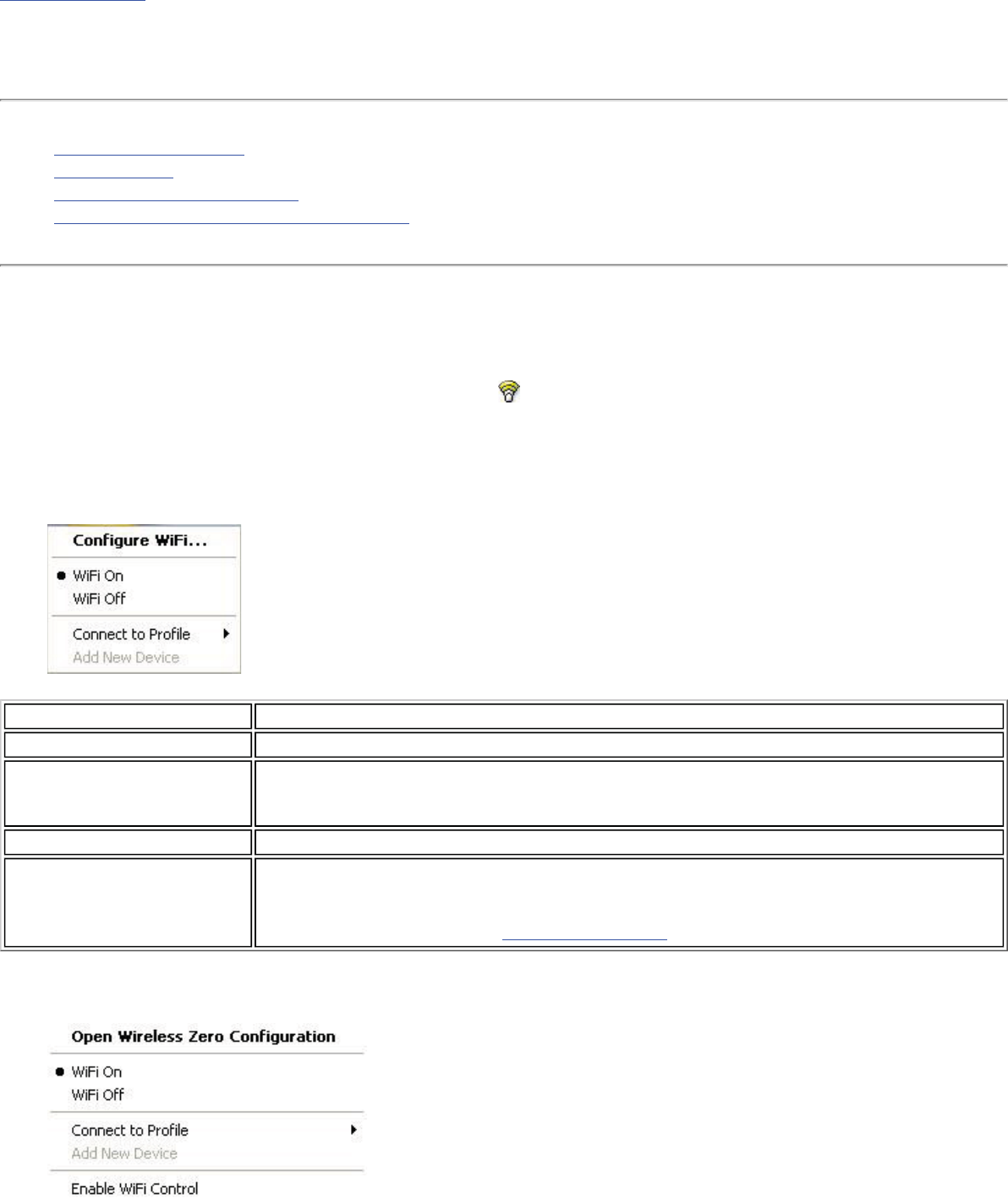
Back to Contents
Taskbar Icon
●Taskbar Menu Options
●Taskbar Icons
●Tool Tips and Desktop Alerts
●Start Intel PROSet/Wireless from Taskbar
Taskbar Menu Options
The Intel(R) PROSet/Wireless WiFi Connection Utility status icon displays on the Taskbar located in the lower right
corner of your Windows desktop. This icon looks like this:
Right-click the status icon to display the menu options.
If the WiFi connection utility is managing your WiFi connections, then the following menu options appear.
Name Description
Configure WiFi... Click to open Intel PROSet/Wireless WiFi and configure your WiFi connections.
WiFi On / WiFi Off Click to turn on or off the Intel wireless adapter. If you are currently connected to a
wireless network and you click WiFi Off, your wireless network connection will be
closed.
Connect to Profile Displays the current profiles in the Profiles list. Click on a profile to connect to it.
Add New Device This command lets you add a new device (for example, a laptop) using Wi-Fi
Protected Setup*. The availability of this command on your computer means that
your computer is already configured as a Wi-Fi Protected Setup registrar (using the
WiFi connection utility). See Add an New Device.
If Windows Zero Configuration manager is managing your WiFi connections, then the following menu options appear.

Name Description
Open Wireless Zero
Configuration
Click to open Windows Zero Configuration, the wireless connections manager
provided by Windows*. Only available if you have selected Use Windows to
manage WiFi at the Intel(R) PROSet/Wireless WiFi Connection Utility, Advanced
menu.
Configure WiFi Click to open Intel(R) PROSet/Wireless WiFi Connection Utility and configure your WiFi
connections.
WiFi On / WiFi Off Click to turn on or off the Intel wireless adapter. If you are currently connected to a
wireless network and you click WiFi Off, your wireless network connection will be
closed.
Connect to Profile Displays the current profiles in the Profiles list. Click on a profile to connect to it.
Add New Device This command lets you add a new device (for example, a laptop) using Wi-Fi
Protected Setup*. The availability of this command on your computer means that
your computer is already configured as a Wi-Fi Protected Setup registrar (using the
WiFi connection utility). See Add an New Device.
Enable WiFi Control Click to assign management of your WiFi wireless connections to the WiFi connection
utility. Wireless Zero Configuration manager will no longer manage your connections.
If you want to assign management of your WiFi wireless connections back to Wireless
Zero Configuration manager, open the Intel(R) PROSet/Wireless WiFi software, and
under the Advanced menu, click Use Windows to Manage WiFi.
Taskbar Icons
The Taskbar icon provides visual indication of the current wireless connection state. The connection status icon is
located on the lower right corner of your Windows desktop. The Taskbar icon can be set to display or be hidden in
the Tools Menu Application Settings.
Name Description
WiFi Off : The wireless adapter is off. The wireless device does not
transmit or receive while it is off. Click WiFi On to enable the
adapter. The icon is white and static.
Searching for wireless networks: The wireless adapter searches
for any available wireless networks. The icon is white with animation.
No wireless networks found: There are no available wireless
networks found. Intel PROSet/Wireless WiFi periodically scans for
available networks. If you want to force a scan, double-click the icon
to launch Intel PROSet/Wireless and click Refresh. The icon is red.
Wireless network found: An available wireless network is found.
Double-click the icon to display the Wireless Networks list. Select the
network. Click Connect. The icon is yellow.
Authentication failed: Unable to authenticate with wireless
network. The icon is green with a yellow warning triangle.
Connecting to a wireless network: Flashes while an IP address is
being obtained or if an error occurs.
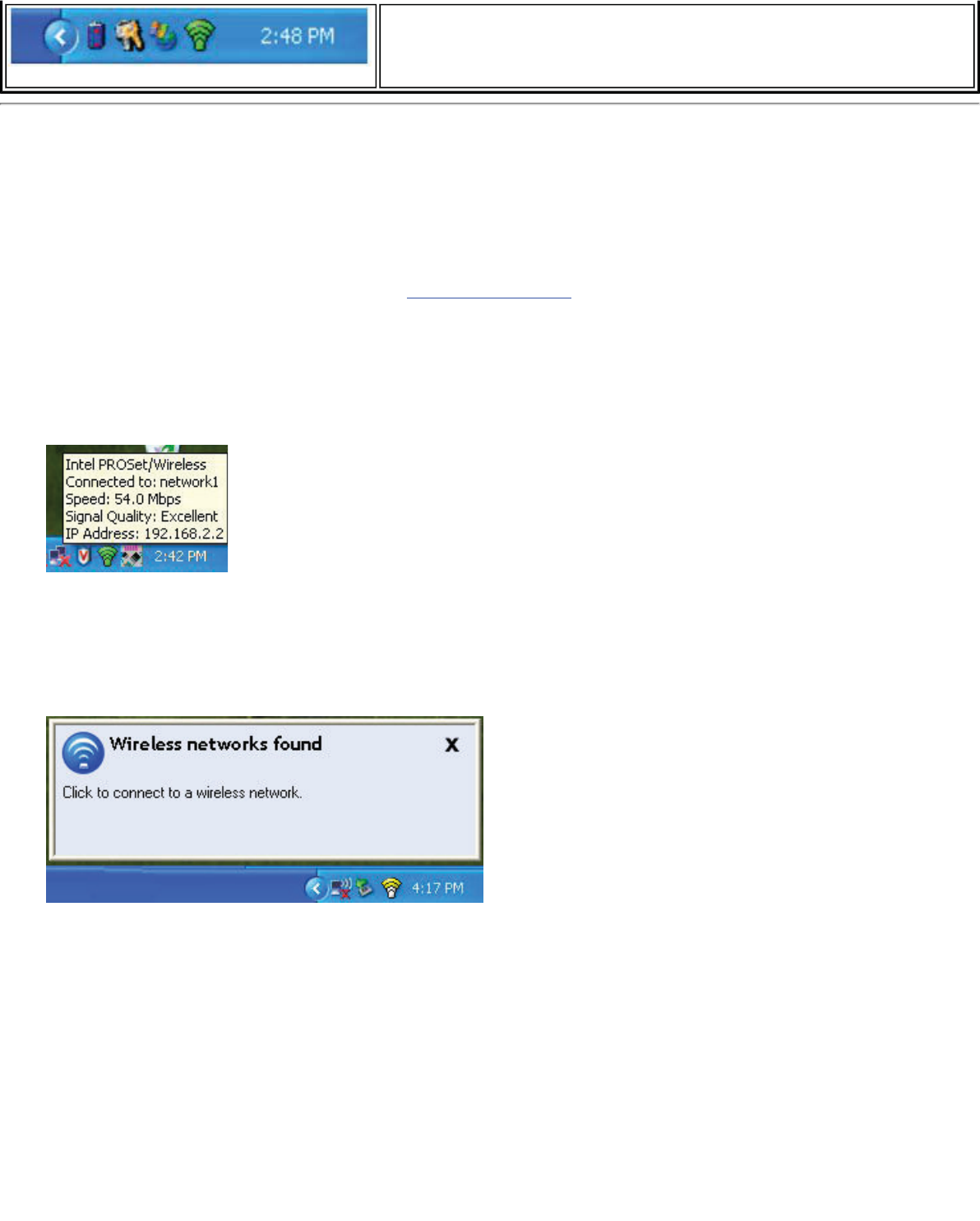
Connected to a wireless network: Connected to a wireless
network. Tool tip displays network name, speed, signal quality and IP
address. The icon is green with waves that reflect signal quality. The
more waves, the better the signal quality.
Tool Tips and Desktop Alerts
The Tool Tips and Desktop Alerts provide feedback and interaction. To display Tool Tips, move your mouse pointer
over the icon. Desktop alerts are displayed when your wireless network changes state. For example, if you are out of
range of any wireless networks, a desktop alert is displayed when you come into range.
Select Show Information Notifications in the Application Settings to enable desktop alerts.
Tool Tips
Tool tips display when the mouse pointer rolls over the icon. The tool tips display text for each of the connection
states.
Desktop Alerts
When user action is required, a desktop alert displays. If you click the alert, then an appropriate action is taken. For
example when wireless networks are found, the following alert displays:
Action: Click the desktop alert to connect to a network in the WiFi Networks list.
Once connected, the alert displays the wireless network that you are connected to, the speed of the connection,
signal quality and IP address.
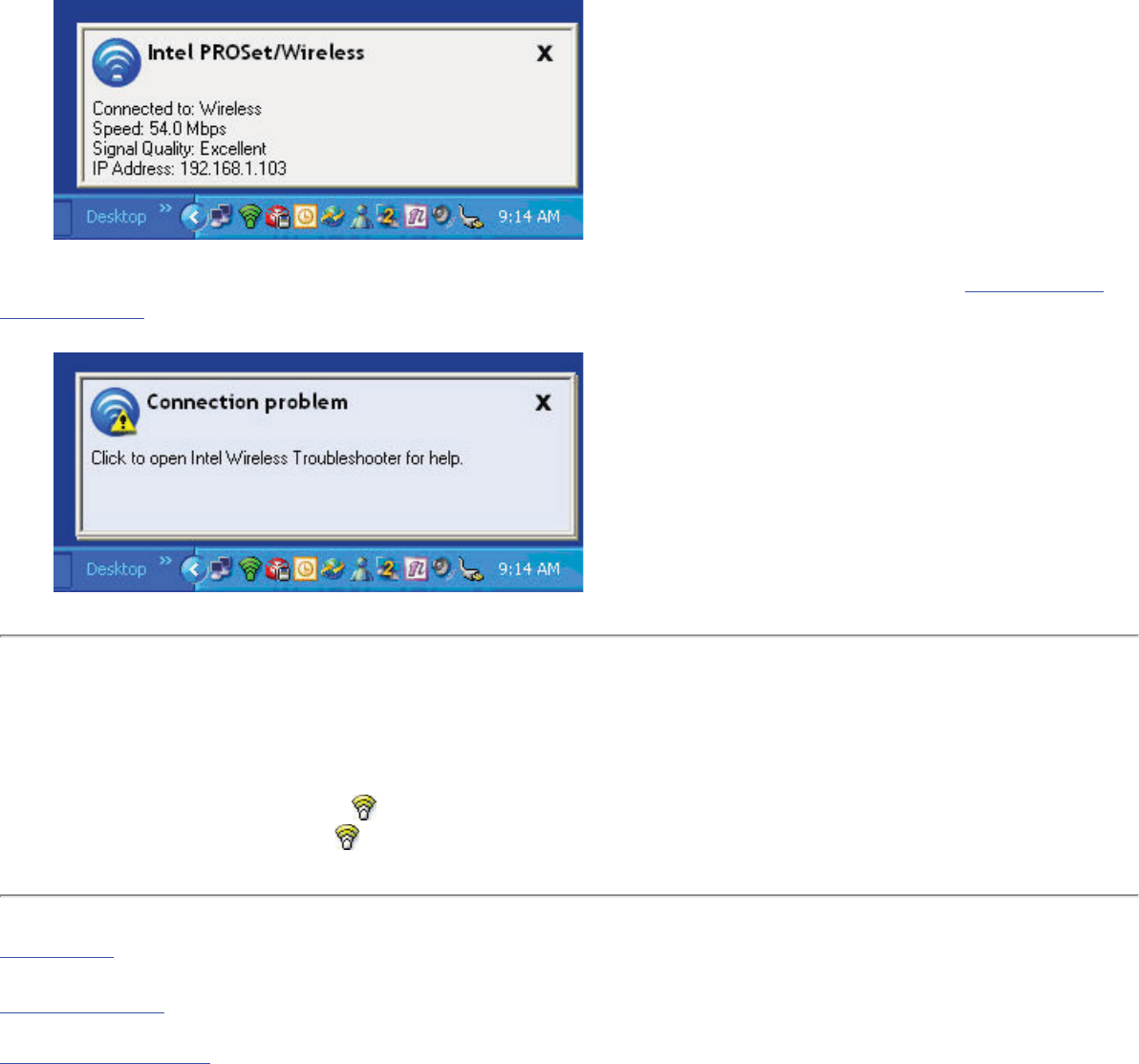
Desktop alerts are also used to indicate if there is a connection problem. Click the alert to open the Intel Wireless
Troubleshooter.
Start Intel PROSet/Wireless WiFi from Taskbar
To start Intel(R) PROSet/Wireless WiFi software:
●Double-click the Taskbar icon located in the lower right corner of your Windows desktop, or
●Right-click the Taskbar icon , and select Configure WiFi .
Back to Top
Back to Contents
Trademarks and Disclaimers

Back to Contents
WiFi Networks list
The WiFi Networks list displays a list of wireless networks within range of the adapter. To
update the list, click Refresh to rescan for wireless networks. Click Profile to launch the
Profile Wizard and create a profile for the selected wireless network.
Name Description
Wireless Networks ( ) The number within the parentheses designates the number of
wireless network found within range of your wireless network
adapter.
The signal strength of the wireless network access point or
computer (Device to Device [ad hoc] mode). The signal strength
icon bars indicate that the wireless network or computer is
available for connection but is still not associated with an access
point or computer (Device to Device [ad hoc] mode).
Network Name Network Name (SSID): The name of the network that the
adapter is connected to. The Network Name (SSID) must be the
same as the SSID of the access point.
If an access point does not broadcast its network name (SSID)
or the wireless adapter receives a hidden network name from a
stealth access point, <SSID not broadcast> is displayed in the
WiFi Networks list. To associate with an <SSID not broadcast>
network entry, a new profile must be created before connection.
After connection, the <SSID not broadcast> is still displayed in
the WiFi Networks list. The associated SSID profile is viewed in
the Profiles list.
Status Notification that the adapter is connecting to the wireless
network. Once connected, the status is changed to Connected.
Profiles: Identifies a network in the WiFi Networks list that is
connected and has a profile in the profiles list.
The wireless network uses Network (Infrastructure) mode.
The wireless network uses Device to Device (ad hoc) mode.
The wireless network uses Security encryption.

The band frequency being used by the wireless network
(802.11a, 802.11b, 802.11g, or 802.11n).
The wireless network is on the Exclude list or the profile is
configured for Manual connection. When set to Manual in the
profile, connection to network or an access point is not
automatic. Double-click on the network in the list to connect to
it.
Connect (Disconnect) Click to connect to a wireless network. Once connected, the
button changes to Disconnect.
Lists the network names of the available networks and profiles.
The network status icons indicate the current connection status.
●If the selected network has 802.1X authentication, the
Profile Wizard General Settings opens. If the network has
no WEP security (Open), WEP 64-bit or 128-bit encryption,
or pre-shared key (PSK), click Connect.
●If a PSK or WEP password are required, you are prompted
to enter this information prior to connection. If you need
to add security settings, click Advanced to access the
Create Wireless Profile General Settings. See First
Time Connection for more information.
Properties Provides detailed information about the connected network and
its access points. See Network Properties for information.
Refresh Refreshes the list of available networks. If any new networks are
available within range of the adapter, the list is updated to show
the new network name.
WiFi On / WiFi Off Switch the WiFi radio off and on. See Turn WiFi On or Off for
more information.
Close Closes the Intel(R) PROSet/Wireless WiFi Connection Utility main
window.
Help? Provides help information for this page.
Back to Top
Back to Contents
Trademarks and Disclaimers
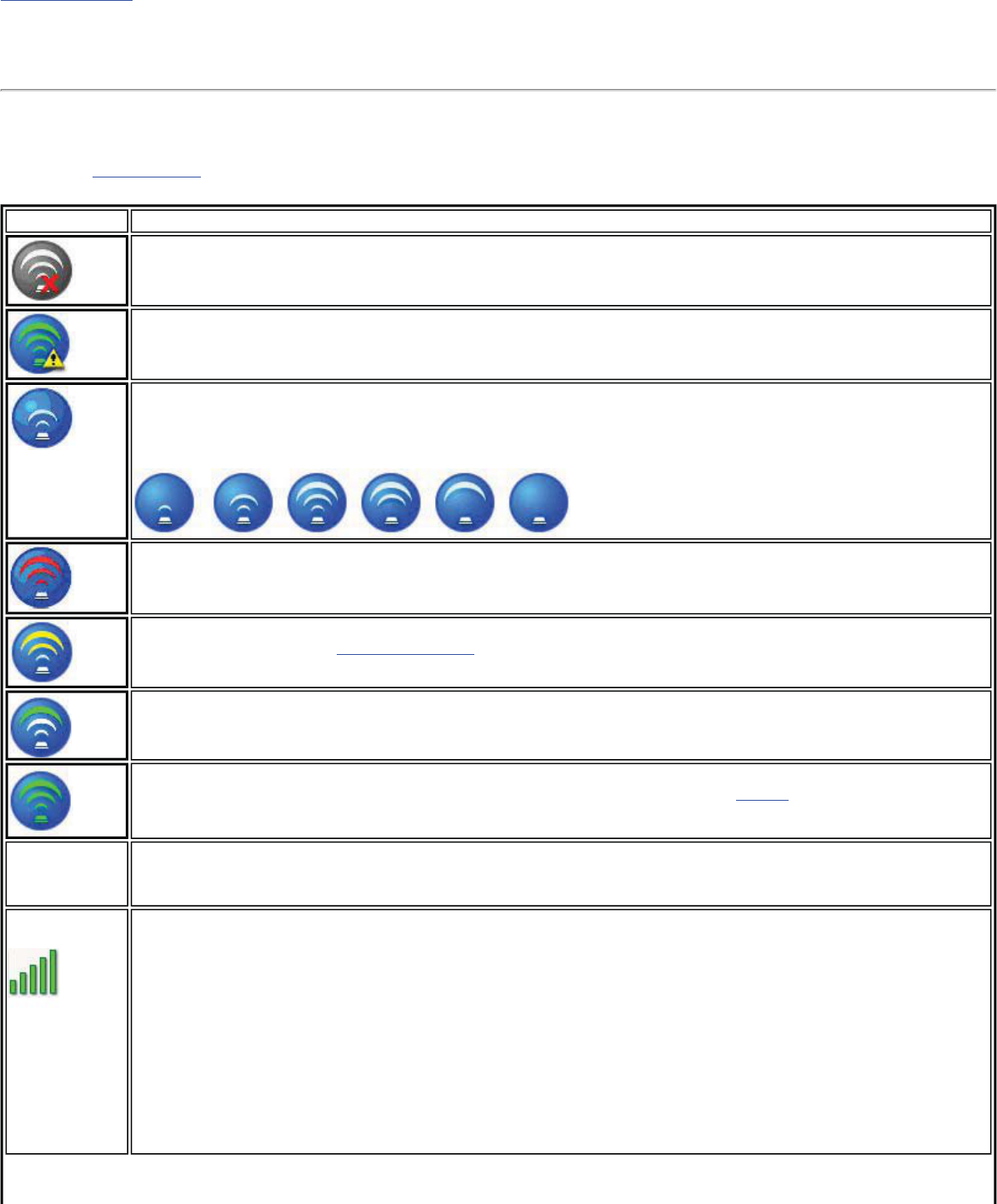
Back to Contents
Connection Status Icons
The connection status icons indicate the current connection status of your wireless adapter. The connection status icon displays
in the Intel(R) PROSet/Wireless WiFi Connection Utility main window. The Taskbar icon also indicates the current connection
status. See Taskbar Icons for more information.
Icon Description
Wireless turned off : The wireless adapter radio is turned off. Click the WiFi On button to turn on the radio.
Indicates connection problems including authentication failures.
Searching for wireless networks: The wireless adapter is scanning for any available wireless networks.
Animated Icons:
No wireless networks found: The adapter does not find any available wireless networks.
Wireless network found: An available wireless network is found. You can choose to connect to available
networks displayed in the WiFi Networks list.
Connecting to a wireless network. You are connecting to a wireless network. The crescent shaped curves
switch between green and white until an IP Address is obtained or if a connection error occurs.
Connected to a wireless network: You are connected to a wireless network. The network name, speed,
signal quality, and IP address display the current connection status. Click the Details button to display details
of the current network connection.
Network
Name
Name (Profile Name or SSID): The name of the network that the adapter is connected to. The Name
column displays the SSID or the Profile name if a profile for the network is available.
Signal
Quality
The signal strength icon bars indicate the quality of the transmit and receive signals between your wireless
adapter and the access point or computer in Device to Device (ad hoc) mode. The number of vertical green
bars indicates the strength of the transmit and receive signals.
NOTE: The signal strength is displayed for the closest AP for networks that contains multiple APs.
The signal strength ranges from excellent to out of range. The following factors affect signal strength:
●Signal quality decreases with distance and is affected by metal and concrete barriers.
●Metal objects can reflect signals and cause interference.
●Other electrical devices can cause interference.

Properties Provides adapter connection status information. See Network Properties for information.
WiFi On/
WiFi Off
Switch the radio off and on. See Turn Radio On or Off for more information.
Help? Provides help information for this page.
Close Closes the WiFi connection utility main window.
Back to Top
Back to Contents
Trademarks and Disclaimers

Back to Contents
Network Properties
Network Properties
Manage Exclusions
Click Properties at the Intel(R) PROSet/Wireless WiFi Connection Utility main window to see
detailed information about the selected network and its access points. This screen shows
you information about this network, information about the access points, and also lets you
open up the Exclude List Management screen. On the Exclude List Management screen, you
can add profiles to be excluded from automatic connection.
Network Properties details
Name Description
Network Name Displays the wireless network name.
Band Current band and frequency being used. Displays Out
of Range if no band and frequency are displayed.
The following bands are listed:
●802.11a
●802.11b
●802.11g
●802.11n

Operation Mode Displays the current mode:
●Network (Infrastructure)
A wireless network centered around an
access point. In this environment, the
access point not only provides
communication with the wired network, but
also mediates wireless network traffic in
the immediate neighborhood.
●Device to Device (ad hoc)
A communication configuration in which
every computer has the same capabilities,
and any computer can initiate a
communication session. Also known as a
peer-to-peer network or a computer-to-
computer network.
Authentication Level Displays the current authentication security mode for
the network being used.
The following network authentication levels are listed:
●Open
●Shared
●WPA-Enterprise
●WPA2-Enterprise
●WPA-Personal
●WPA2-Personal
Displays the authentication used by the currently used
network. See to Security Overview for more information.
Data Encryption The following Data Encryption settings are listed:
●None
●WEP
●TKIP
●CKIP
●AES-CCMP
See to Security Overview for more information.

Access Points in this Network
<0-50>
●Signal Strength: The signal strength icon bars
indicate the strength of the transmit and receive
signals between your wireless adapter and the
nearest access point.
●Displays one of the following icons: .
Indicates the band being used (802.11a,
802.11b, 802.11g or 802.11n).
●Channel: Displays the current transmit and
receive channel being used for a particular
wireless network.
●BSSID (Infrastructure operating mode):
Displays the twelve-digit MAC address of the
access point of the selected network.
Manage Exclusions See Manage Exclusions for more information. If
network exclusion is enabled (see Application Settings),
then the Network Properties also indicates if the
network is excluded from automatic connection.
Close Closes the Network Properties.
Help? Provides help information for this page.
Back to Top
Back to Contents
Trademarks and Disclaimers
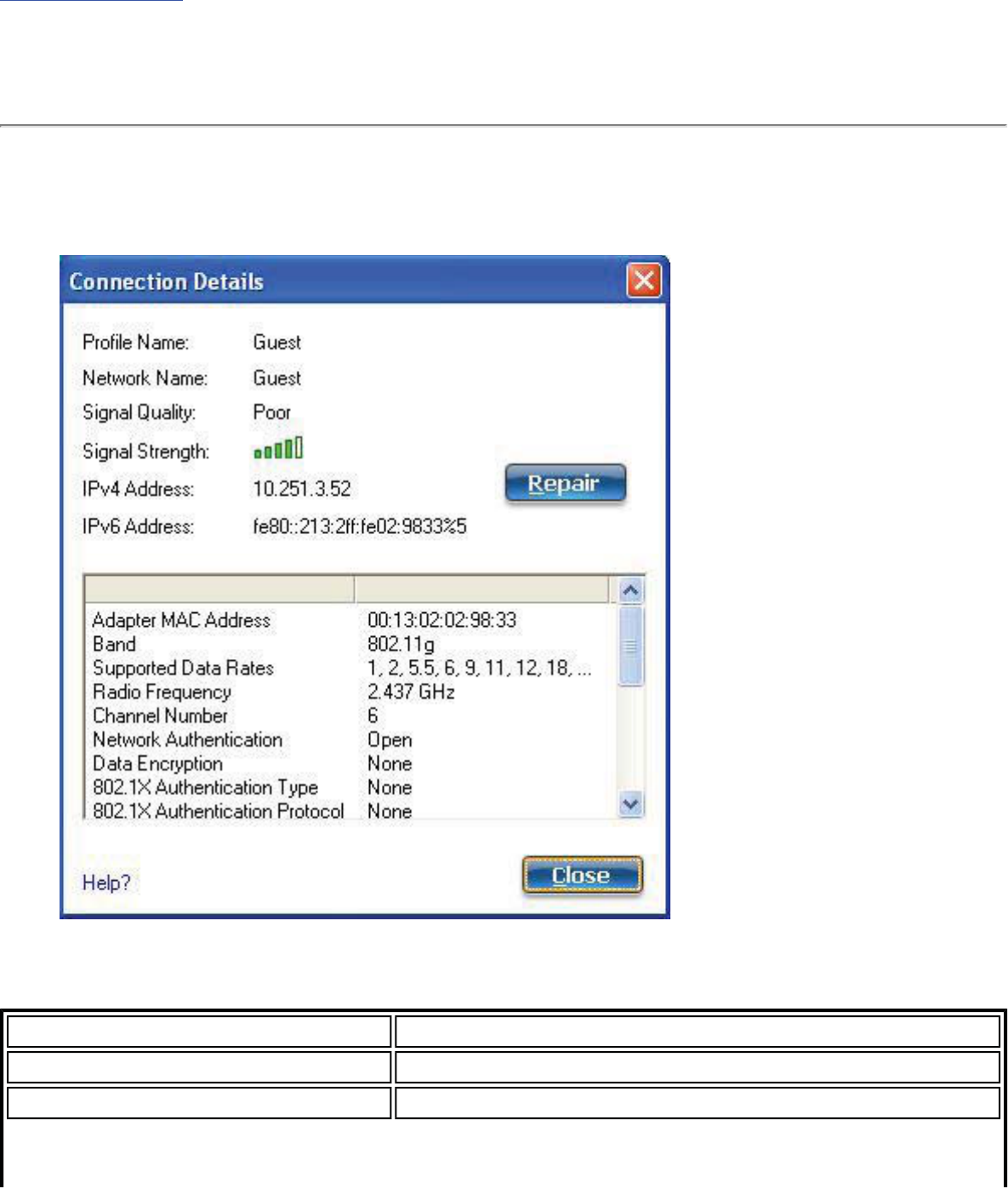
Back to Contents
Network Connection Details
When you are connected to a network, click the Details button on the Intel(R) PROSet/
Wireless WiFi Connection Utility main window to display the Connection Details.
Connection Details Description
Name Description
Profile Name Name of the profile.
Network Name Network Name (SSID) of the current connection.

Signal Quality A radio frequency (RF) signal can be assessed by two
components:
●signal strength (quantity)
●signal quality
The quality of the signal is determined by a
combination of factors. Primarily it is composed of
signal strength and the ratio of the RF noise present.
RF noise occurs both naturally and artificially by
electrical equipment. If the amount of the RF noise is
high, or the signal strength is low, it results in a lower
signal to noise ratio, which causes poorer signal
quality. With a low signal to noise ratio, it is difficult
for the radio receiver to discern the data information
contained in the signal from the noise itself.
Signal Strength The signal strength icon bars indicate the quality of
the transmit and receive signals between your wireless
adapter and the access point or computer in Device to
Device (ad hoc) mode. The number of vertical green
bars indicates the strength of the transmit and receive
signals.
NOTE: The signal strength is displayed for the closest
AP for networks that contains multiple APs.
The signal strength ranges from excellent to out of
range. The following factors affect signal strength:
●Signal quality decreases with distance and is
affected by metal and concrete barriers.
●Metal objects can reflect signals and cause
interference.
●Other electrical devices can cause interference.
IP Address IPv4 Address: Internet Protocol (IP) address for the
current connection.
IPv6 Address: The next generation IP address is
backward compatible and is designed to fix data
security problems with IPv4. IPv6 increases the
address space from 32 to 128 bits, providing for an
unlimited number of networks and systems. It also
supports quality of service (QoS) parameters for real-
time audio and video.

Adapter MAC Address Media Access Control (MAC) address for the wireless
adapter.
Band Indicates the wireless band of the current connection.
●802.11a
●802.11b
●802.11g
●802.11n
Number of Antennas in Use This indicates the number of antennas currently in
use. This number depends on the band(s) that the
various networks are currently using, the transmit/
receive modes in use on those bands, the signal
strength, and the capabilities of the access point(s).
The user has no direct control over this parameter.
Supported Data Rates Rates at which the wireless adapter can send and
receive data. Displays the speed in Mbps for the
frequency being used.
●802.11a: 6, 9, 12, 18, 24, 36, 48, and 54
●802.11b: 1, 2, 5.5, and 11
●802.11g: 1, 2, 5.5, 6, 9, 11, 12, 18, 24, 36, 48,
and 54
●802.11n: 300, 270, 243, 240, 180, 150, 144,
135, 130, 120, 117, 115.5, 90, 86.667, 72.2,
65, 60, 57.8, 45, 43.3, 30, 28.9, 21.7, 15, 14.4,
7.2
Radio Frequency Displays the frequency of the current wireless
connection.
●802.11a: 5.15 GHz to 5.85 GHz
●802.11b/g: 2.400 GHz to 2.4835 GHz
(dependent on country)
●802.11n: 2.400 GHz to 5.00 GHz
Channel Number Displays the transmit and receive channel.
Network Authentication Displays Open, Shared, WPA*-Personal, WPA2*-
Personal, WPA-Enterprise and WPA2-Enterprise.
Displays the authentication used by the currently used
profile. See Security Overview for more information.
Data Encryption Displays None, WEP, TKIP or AES-CCMP. See Security
Overview for more information.

802.1X Authentication Type Displays None, EAP-SIM, TLS, TTLS, PEAP, LEAP, or
EAP-FAST. See Security Overview for more
information.
802.1X Authentication Protocol Displays None, PAP,GTC,CHAP,MS-CHAP,MS-CHAP-
V2 or TLS. See Security Overview for more
information.
CCX Version Version of the Cisco Compatible Extensions on this
wireless connection.
Current Tx Power The power level at which the wireless adapter is
currently transmitting, in milliwatts.
Supported Power Levels These are the power levels that the wireless adapter is
capable of transmitting. This information is presented
in a range and is dependent on the adapter.
Access Point MAC Address The Media Access Control (MAC) address for the
associated access point.
Mandatory Access Point Displays None, if not enabled. If enabled, from the
Mandatory Access Point setting, the access point MAC
address is displayed. This option directs the wireless
adapter to connect to an access point that uses a
specific MAC address (48-bit 12 hexadecimal digits, for
example, 00:06:25:0E:9D:84).
AP Name The name of the access point. This name is set by the
person configuring the access point and is typically
limited to 32 characters.
NOTE: This parameter is only visible when connected
to a Cisco Systems access point.
AP IPV4/IPV6 Address The Interconnect Protocol address (IPV4 or IPV6) for
the access point. IPV6 is the next generation IP
address and is backward compatible and is designed
to fix data security problems with IPv4. IPv6 increases
the address space from 32 to 128 bits, providing for
an unlimited number of networks and systems. It also
supports quality of service (QoS) parameters for real-
time audio and video.
NOTE: This parameter is only visible when connected
to a Cisco Systems access point.

AP Signal Strength The strength of the signal received from the access
point, at the adapter. This value is given in milliwatts
(mW) and may actually be in the picowatts range. This
value varies, based on the distance between the AP
and the adapter, obstacles that may interfere with the
signal, and the power level at which the AP is
transmitting.
NOTE: This parameter is only visible when connected
to a Cisco Systems access point.
AP Noise Level The radio frequency (RF) noise level present in the
environment that will tend to interfere with the signal
from the access point. RF noise comes from natural
and electrical sources.
NOTE: This parameter is only visible when connected
to a Cisco Systems access point.
Repair Renews the IP Address. If you have trouble accessing
the network, verify if the IP address is valid. If it is
0.0.0.0 or 169.x.x.x then it is probably not valid. If
your network is set up for automatic network address
assignment, then click Repair and request a new IP
address.
Close Closes the page.
Help? Provides help information for this page.
Back to Top
Back to Contents
Trademarks and Disclaimers
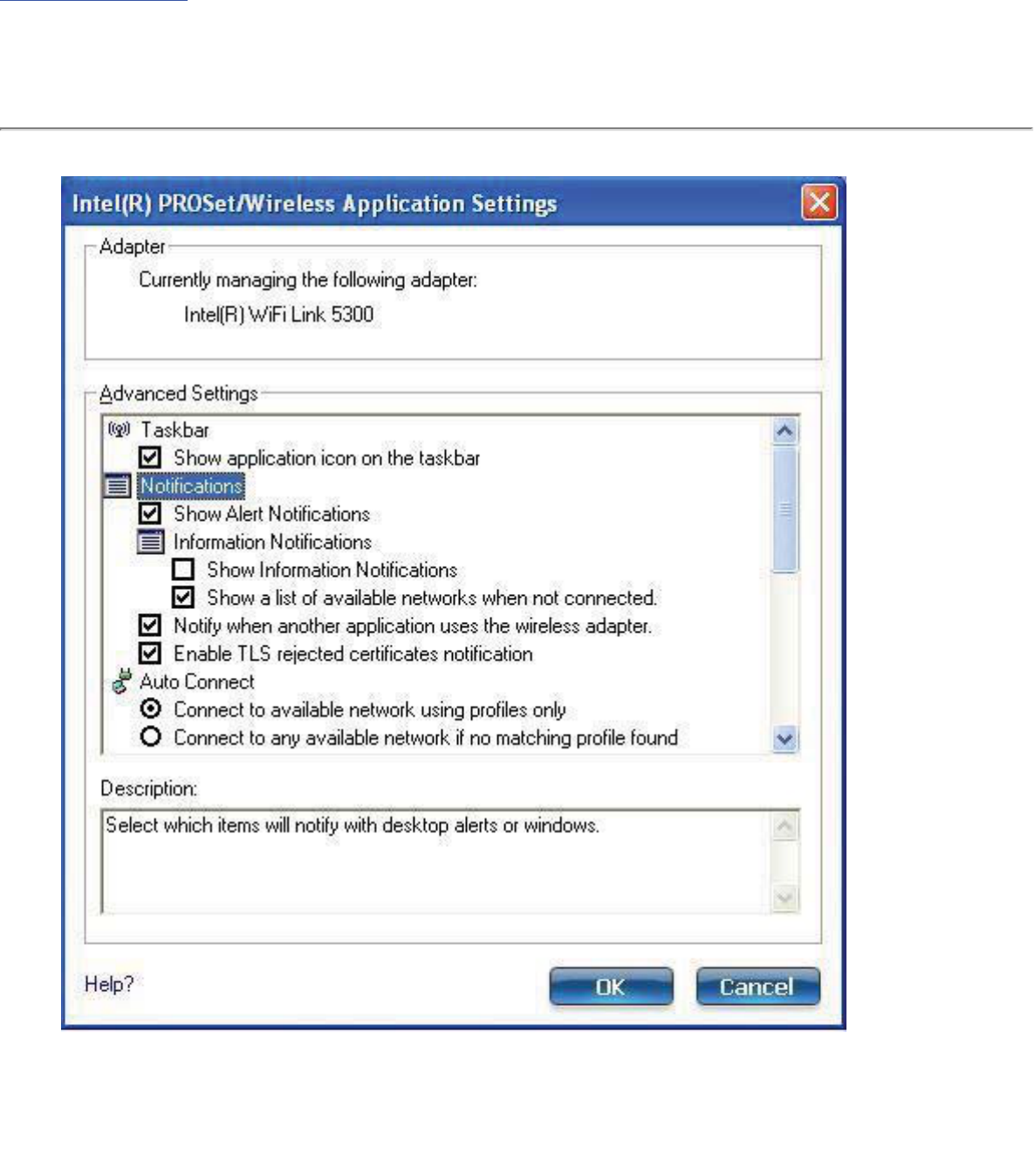
Back to Contents
Application Settings (Tools menu)
The Application Settings control the behavior of the Intel(R) PROSet/Wireless WiFi
Connection Utility.
Application Settings Description

Name Description
Adapter Lists the network adapter. It may be any one of the
following:
●Intel(R) WiMAX/WiFi Link 5350
●Intel(R) WiMAX/WiFi Link 5150
●Intel(R) WiFi Link 5300
●Intel(R) WiFi Link 5100
●Intel(R) Wireless WiFi Link 4965AGN
●Intel(R) Wireless WiFi Link 4965AG_
●Intel(R) PRO/Wireless 3945ABG Network
Connection
●Intel(R) PRO/Wireless 2915ABG Network
Connection
●Intel(R) PRO/Wireless 2200BG Network
Connection
Advanced Settings: The following settings control how the WiFi connection utility
behaves and displays information.
Taskbar Show application icon on the taskbar: Select to
display the Taskbar status icon. This icon resides on the
Windows Taskbar (Notification Area). This icon provides
the status of your wireless connection. Clear to not
display the Taskbar status icon.
The Taskbar Status Icon provides several functions:
●Visual feedback for the connection state and
wireless activity of your wireless network. The
icon changes color and animation for different
wireless activity. See Taskbar Icons for more
information.
●Menu: A menu is displayed when you right-click
the icon. From this menu you perform tasks such
as turn the radio on or off or launch the WiFi
connection utility. See: Taskbar Menu Options for
more information.
●Tool tips and desktop alerts. See: Tool Tips and
Desktop Alerts for more information.

Notifications Show Alert Notifications: Select to display desktop
alerts next to the taskbar icon. When your action is
required, a message displays. Only events of high
importance trigger a desktop alert. If the desktop alert
is selected, then the appropriate action is taken. Clear
to not display desktop alerts. See Tool Tips and
Desktop Alerts for more information.
Select one of the following options:
Information Notifications: These desktop alerts are
of lower importance. They do not require your
interaction but can greatly improve the wireless
experience.
●Show Information Notifications: Selected by
default. All informational desktop alerts are
displayed next to the taskbar status icon. These
desktop alerts improve your wireless experience
with notifications when available wireless
networks are within range. They also inform you
when a wireless connection has been made or
has been lost. See Tool Tips and Desktop Alerts
for more information.
●Show a list of available networks when not
connected: When Show Information
Notifications is cleared, you can select this
item. When the desktop alerts are disabled, this
option lets you continue to be notified of
available networks when the wireless adapter is
not connected.
Notify when another application uses the wireless
adapter: When selected, a message is displayed when
other applications are trying to manage your wireless
adapter. This is helpful if you use software provided by
a hotspot location (coffee shop, airport terminal). To
take advantage of the WiFi connection utility features,
disable this software when you leave the hotspot.
Enable TLS rejected certificates notification:
Select if you want a warning issued when a PEAP-TLS
certificate is rejected by the authentication server. See
Enterprise Security and Set up a Client with TLS
Network Authentication for more information.

Auto Connect Connect to available network using profiles only:
(Default) Connect the wireless adapter to an available
network with a matching profile from the Profiles List. If
no matching profile is found, you are notified (see
Notifications). The wireless device remains
disconnected until a matching profile is found or you
configure a new matching profile.
Connect to any available network if no matching
profile found: Select to connect to a network
automatically if you have not configured a profile and
are at a location that has an open, unsecured wireless
network. NOTE: Open networks have no security. You
would need to provide your own security for this
wireless connection. One way to secure an open
wireless connection is with Virtual Private Networking
(VPN) software.
Connect to any network based on profiles only
(Cisco mode): Select to try every profile in preferred
order. This signifies that you are in the vicinity of an
access point which has more than one SSID but only
advertises one.
Do not automatically connect. User will connect
manually: Select to turn off automatic connection.
Manage Exclusions Enable automatic exclude list feature: Select to
enable the automatic exclude list feature. This feature
provides a way to exclude access points from automatic
connection. See Manage Exclusions for more
information.
Enable manual exclude list feature: Select to
enable the manual exclude list feature. This feature
provides a way to exclude networks from automatic
connection. See Manage Exclusions for more
information.
WiFi Networks list Show column sort headers: Select to display the
column names in the WiFi Networks list. Click a column
header to sort the column in either ascending or
descending order.